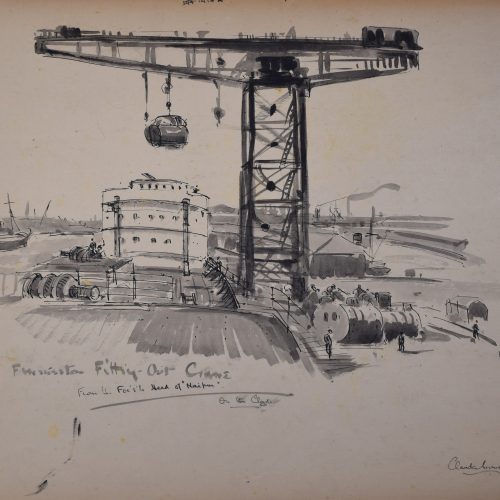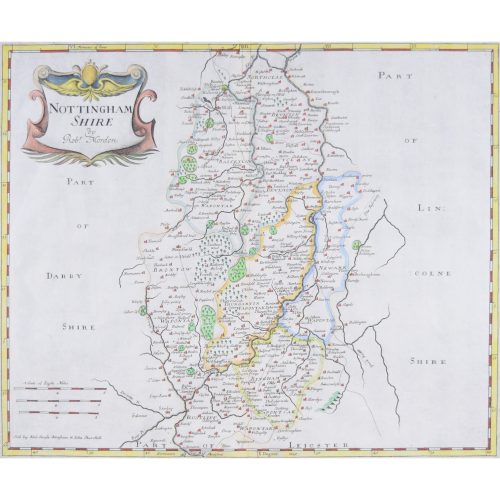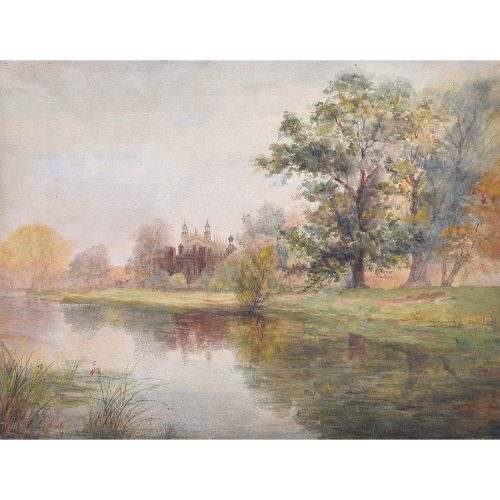-
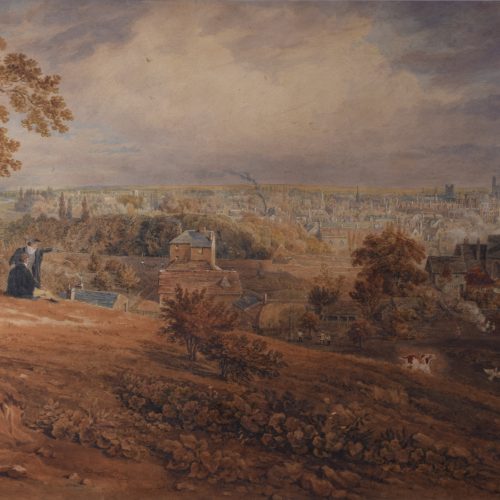
Henry Sargant Storer (1791-1837)
A view of Cambridge from Castle Hill c.1824
Watercolour 46x74.5cm Original watercolour for engraving published in c. 1824. We have a copy of the engraving available, please ask to see it! Provenance: from the family of the artist. A very large and very fine view of Cambridge from Castle Hill. New Court of St John's College shines brightly, being in the course of construction - it was finished in 1831. A later panorama of Cambridge in 1838 shows Jesus Green lock in the course of construction. If you are interested email info@manningfineart.co.uk or call us on 07929 749056. -

Louis Osman (1914-1996) Catalogue for May 1974 Exhibition at Canons Ashby, Northamptonshire
29.6x21.3cm (A4-sized) 24 pages plus card covers Staple bound Provenance: from the artist's estate Louis Osman (30 January 1914 - 11 April 1996) was an architect, artist, goldsmith, silversmith and medallist. Few people matched his creations as a goldsmith, and consequently he was chosen to make the crown for the Investiture of the Prince of Wales in 1969. Many of his other works are in public collections in the UK and worldwide. After Hele's school in Exeter he studied at the Bartlett School of Architecture - part of University College London - from 1931. Also attending the Slade, he left the Bartlett being awarded the top first, which brings with it the Donaldson Medal of the RIBA. Subsequently he trained with Sir Albert Richardson (who lived in a large Georgian house in Northamptonshire in which he refused to have electric light; his wife was endlessly patient with his eccentricities). Serving during the Second World War as a Major in the Intelligence Corps, he was a specialist in Air Photography and served on the Beach Reconnaissance Committee prior to the June 1944 Normandy 'D-Day' landings. Following the war he was busy as an architect, works including for Westminster Abbey, and Lincoln, Exeter, Ely and Lichfield Cathedrals. Staunton Harold Church in Ashby de la Zouch for the National Trust, and of course his own folly, the Grade I listed Elizabethan manor house, Canons Ashby in Northamptonshire - which was given to the National Trust in 1981 when Osman was not able to keep the tenancy any longer. At Canons Ashby he established a workshop and had a team of silversmiths and goldsmiths working for him. In 1974 he created the exhibition celebrated by this lavishly illustrated catalogue. His crown for the Investiture of the Prince of Wales was on display, together with many other items of his own creation, and also by other silversmiths such as Malcolm Green, Philip Noaks and Stephen Nunn, also acknowledging the work of Desmond Clenn-Murphy, Peter Musgrove and Christopher Philipson in his own works. In 1976 he made the gold enamelled casket that holds the copy of the Magna Carta on view in the United States Capitol, Washington, DC. If you are interested email info@manningfineart.co.uk or call us on 07929 749056. Condition: Excellent. As new, staple bound and staples - as always - showing slight sign of rust to the inside -

after Samuel Buck (1696 - 1779) and Nathaniel Buck (active 1724 - 1759)
The South View of Bindon Abbey, in the County of Dorset (1733)
Engraving 20 x 37 cm An engraved view of Bindon Abbey, a Cistercian monastery on the River Frome in Dorset. The monastery was founded in 1149 by William de Glastonia on the site since known as Little Bindon near Bindon Hill. In 1172 the monastery moved to a site near Wool, and was supported by the house of Plantagenet. The abbey was scheduled for Dissolution in 1536, and finally dissolved in 1539. Only ruins remain. Samuel and Nathaniel Buck were brothers and notable 18th century architectural artists, best known for their depictions of ancient castles and monasteries entitled 'Buck's Antiquities' and those of townscapes of England and Wales, ''Sea-Ports and Capital Towns''. Little is known about the brothers' lives. Samuel was born in Yorkshire and died in penury in London in 1779, and was buried in the churchyard of St Clement Danes. Nathaniel pre-deceased him, dying between 1759 and 1774. Condition: generally good; some age toning; mounted to board; sheet trimmed outside platemark. If you are interested, please email info@manningfineart.co.uk or call us on 07929 749056. -
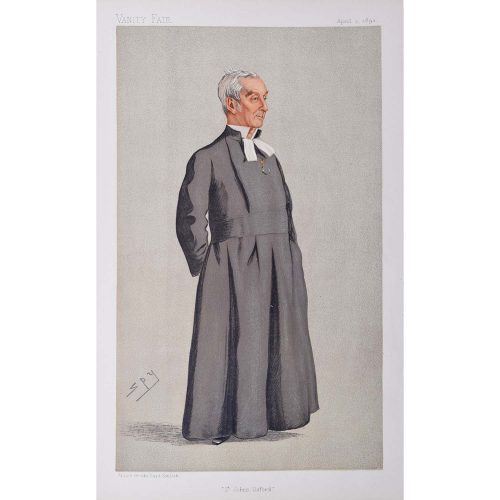
Vanity Fair Spy Magazine President of St john's College Oxford
1 April 1893 Lithograph If you are interested email info@manningfineart.co.uk or call us on 07929 749056. Condition: Good. -
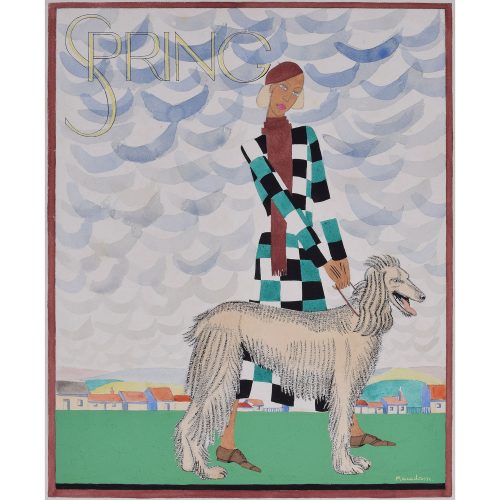
Margaret Macadam (1902-1991)
Spring: Lady with an Afghan Hound
Signed Mixed media c.1930 28x23cm If you are interested email info@manningfineart.co.uk or call us on 07929 749056. -
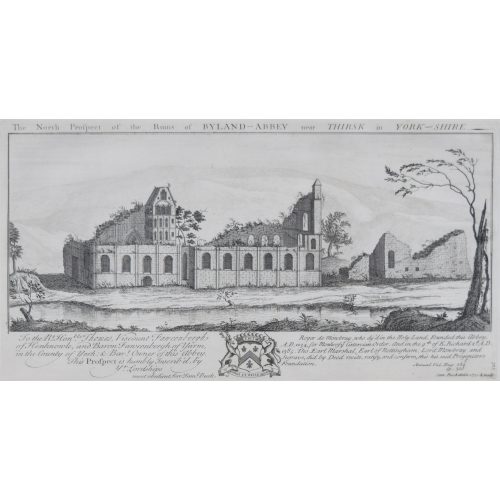
Samuel & Nathaniel Buck
Byland Abbey, Yorkshire
Engraving 37x19cm, c. 1770 "Byland Abbey is an interesting ruin about five miles from Helmsley. It was a fine specimen of ecclesiastical architecture, founded by the monks of Furness, who were driven from their establishment in Lancashire during an incursion of the Scots. When the abbey was dissolved in 1540 its revenues amounted to 238l. 9s. 4d." (Source: The Penny Magazine of the Society for the Diffusion of Useful Knowledge 25 June 1836.) -
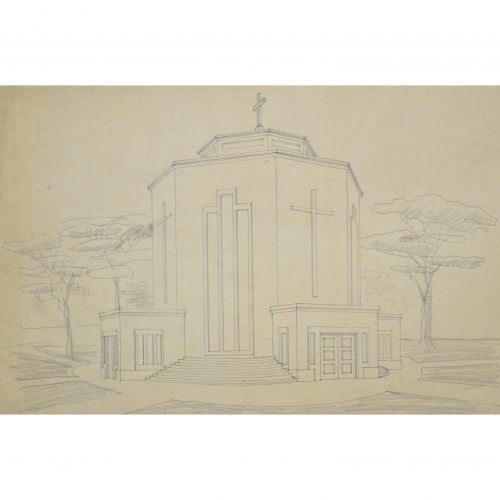
S Clapham (active 1940 - 1960)
A Modernist Church
Pencil 29 x 43 cm A design for an octagonal church in the modernist mid-century style. Clapham was an architect based in Stockwell in London. Condition: generally very good. If you are interested, please email info@manningfineart.co.uk or call us on 07929 749056. Click here for other works by the artist. -
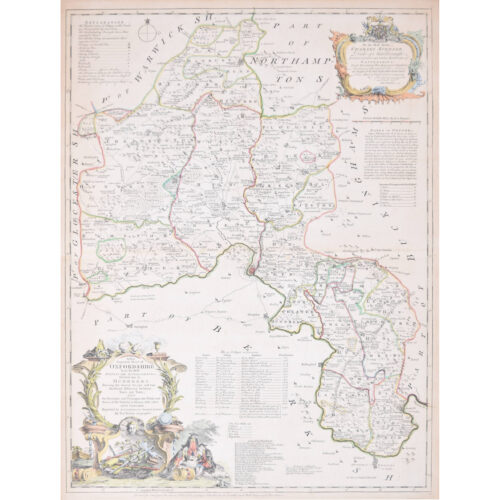
Thomas Kitchin (1719 - 1784)
Map of Oxfordshire (1764)
Engraving with later hand-colouring 72 x 54 cm This decorative map of Oxfordshire features a cartouche with three concentrating scholars and various educational trappings like rolls of parchment. The cartouche in the upper right corner dedicates the map to Charles Spencer, Duke of Marlborough, whose family seat of Blenheim Palace is just outside the city of Oxford. The map also sports a list of the University of Oxford's colleges, its rectories and vicarages, and a paragraph on the Earls of Oxford. Thomas Kitchin was an English engraver and cartographer. He was born in London and was apprenticed to the map engraver Emanuel Bowen in 1732. He produced John Elphinstone's map of Scotland (1746), the Geographia Scotiae (1749), and The Small English Atlas (1749) with Thomas Jefferys. Kitchen worked for the London Magazine and for the King; there is also some debate as to whether he passed off other cartographers' work as his own. Condition: generally very good; central fold as issued, another fold to middle of top half, three tiny losses (a millimetre or two) just outside plate mark to left side. If you are interested, please email info@manningfineart.co.uk or call us on 07929 749056. Click here for other decorative maps. -
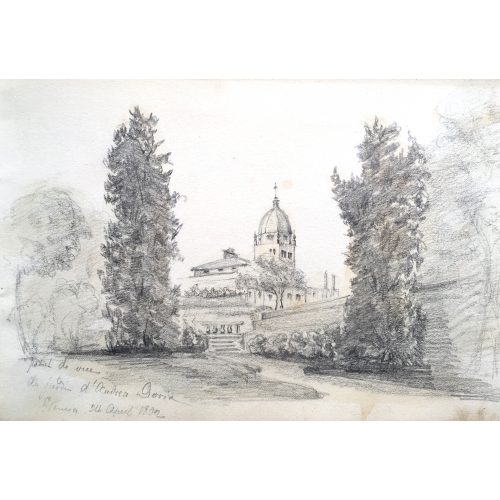
Oscar Andreae (fl.1860-1880) Garden
Pencil drawing 1862 12 x 18.5cm approx. Andreae spent much of the 1860s exploring Europe - the invention of the railways having made undertaking a Grand Tour rather easier than it had been half a century earlier - and recorded the places he visited. If you are interested email info@manningfineart.co.uk or call us on 07929 749056. Condition: Good. -
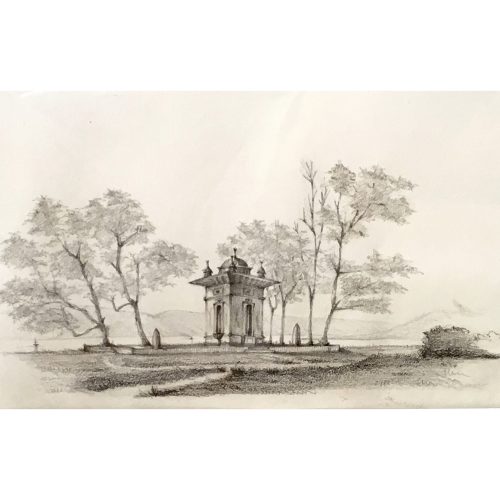
Oscar Andreae (fl.1860-1880) Kiosk on the Bosphorus
Pencil drawing Dated 4 April 1866 13 x 19.5cm approx. Andreae spent much of the 1860s exploring Europe - the invention of the railways having made undertaking a Grand Tour rather easier than it had been half a century earlier - and recorded the places he visited. Here he is in Turkey, recording a Kiosk - or Köşkü - on the shores of the Bosphorus, the strait of water in northwestern Turkey that links the Black Sea to the Mediterranean. If you are interested email info@manningfineart.co.uk or call us on 07929 749056. Condition: Good. -
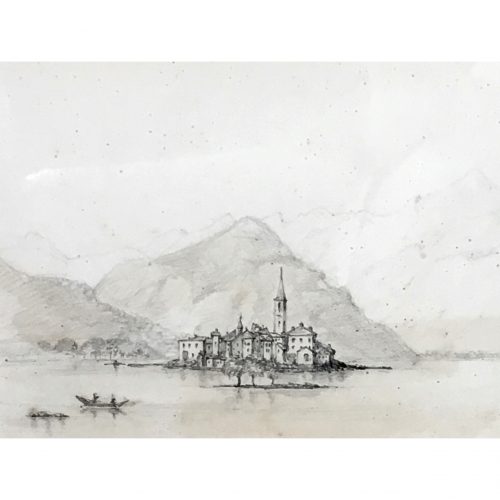
Oscar Andreae (fl.1860-1880) Isola Pescatori, Italy
1862 Pencil drawing Sheet 12 x 16.5cm Andreae spent much of the 1860s exploring Europe - the invention of the railways having made undertaking a Grand Tour rather easier than it had been half a century earlier - and recorded the places he visited. Here, visiting the Lago Maggiore in northern Italy he depicts the Isola Pescatori (the fishermen's island) - or Isola Superiore. If you are interested email info@manningfineart.co.uk or call us on 07929 749056. Condition: Good. -
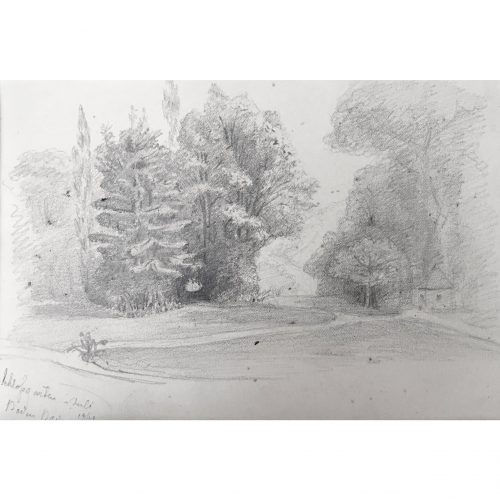
Oscar Andreae (fl.1860-1880) Inscribed 'Schlossgarten - Juli 1861/ Baden Baden'
Pencil Drawing Sheet 11 x 18.5cm Andreae spent much of the 1860s exploring Europe - the invention of the railways having made undertaking a Grand Tour rather easier than it had been half a century earlier - and recorded the places he visited. Here he records what is thought to be the gardens of the Neues Schloss in Baden Baden, the former residence of the Margraves of Baden. Baden Baden is an old spa town - with two thermal baths - on the edge of the Black Forest in the south west of Germany. If you are interested email info@manningfineart.co.uk or call us on 07929 749056. Condition: Good. -
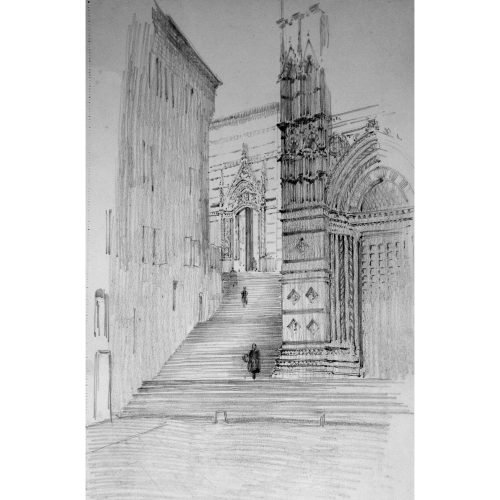
Christopher Wyndham Hughes (1881-1961) Italian Church Entrance
Pencil drawing c.1930s 35 x 23cm Born in St Albans, in Hertfordshire UK, Hughes was a painter, illustrator, printmaker and teacher. He served in the First World War in the 7th Battalion Wiltshire Regiment being awarded a Military Cross in the 1917 New Years Honours List and attaining the rank of Colonel. Subsequently he taught art at Marlborough College. He was taught painting by his father, Wyndham Hughes, who was an expert in stained glass and ecclesiastical decoration. This is from a series of drawing we have of an Italian trip, to see some others, scroll down to "More from this Seller" and below it click on "See all from this seller." If you are interested email info@manningfineart.co.uk or call us on 07929 749056. Condition: Good. -
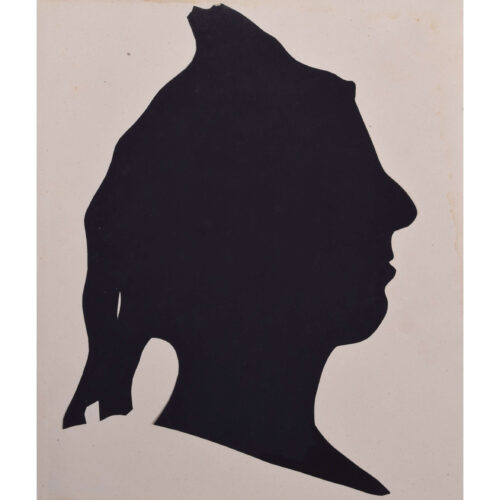
Silhouette of Lady II (circa 1870)
Gouache, pen, and ink 52 x 44 cm Prior to photography, silhouettes were the easiest way of recording a person's appearance. This set might record the group present at a country house party, a wedding, or other similar convivial occasion. Condition: generally good; some staining to edges. If you are interested, please email info@manningfineart.co.uk or call us on 07929 749056. Click here for other silhouettes. -
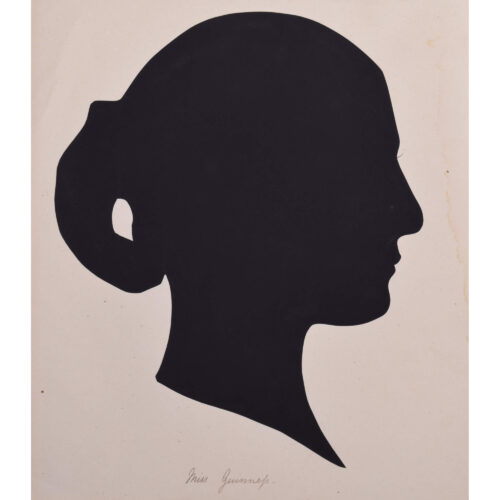
Silhouette (circa 1870)
Miss Guinness
Gouache, pen, and ink 52 x 44 cm Silhouettes of other members of the Guinness family of brewers and bankers are also available in this set. The Guinness family seat is Elveden Hall in Suffolk. Prior to photography, silhouettes were the easiest way of recording a person's appearance. This set might record the group present at a country house party, a wedding, or other similar convivial occasion. Condition: generally good; some staining to edges. If you are interested, please email info@manningfineart.co.uk or call us on 07929 749056. Click here for other silhouettes. -
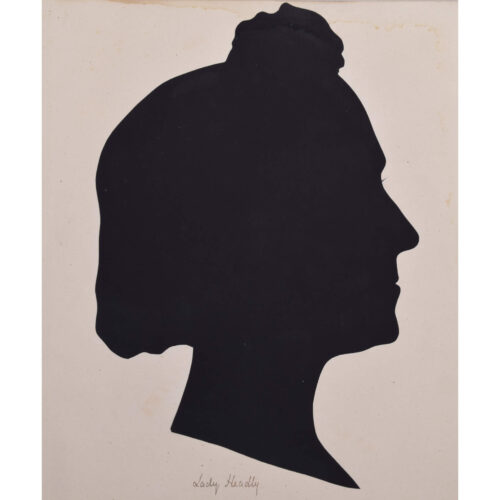
Silhouette (circa 1870)
Lady Headley
Gouache, pen, and ink 52 x 44 cm A silhouette depicting Lady Headley, likely the wife of the 6th or 7th Baron Headley. Lord Headley, Baron Allanson and Winn, of Aghadoe in the County of Kerry, was a title in the Peerage of Ireland, first created in 1797. Prior to photography, silhouettes were the easiest way of recording a person's appearance. This set might record the group present at a country house party, a wedding, or other similar convivial occasion. Condition: generally good; some staining. If you are interested, please email info@manningfineart.co.uk or call us on 07929 749056. Click here for other silhouettes. -
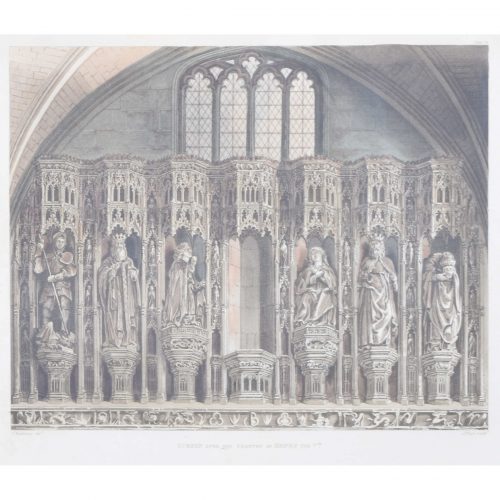
J Black (early 19th century) after Frederick Mackenzie (1788 - 1854)
Screen Over the Chantry of Henry V, Westminster Abbey (1812)
Hand-coloured aquatint 26 x 31 cm Published by Rudolph Ackermann (1764 - 1834). An engraving of the gothic screen of the elaborately carved chantry chapel dedicated to Henry V, and below which lies his tomb, in Westminster Abbey. Mackenzie's drawing was engraved by Black and published by Ackermann in his 1812 "History of Westminster Abbey". The Abbey is an historic, mainly Gothic church in the City of Westminster, London, just to the west of the Palace of Westminster. It is one of the United Kingdom''s most notable religious buildings and since Edward the Confessor, a burial site for English and, later, British monarchs. Since the coronation of William the Conqueror in 1066, all coronations of English and British monarchs have occurred in Westminster Abbey. Sixteen royal weddings have occurred at the abbey since 1100. According to a tradition first reported circa 1080, a church was founded at the site (then known as Thorney Island) in the seventh century, in the time of Mellitus, Bishop of London. Construction of the present church began in 1245 on the orders of Henry III. Frederick Mackenzie (1788 - 1854) was a British watercolourist and architectural draughtsman. He first exhibited at the Royal Academy in 1804, and contributed eleven drawings between that year and 1828. He contributed to the Society of Painters in Water Colours exhibitions from 1813, becoming an associate in 1822, and a full member the following year. From 30 November 1831 till his death he was treasurer to the society. In later life Mackenzie was no longer commissioned to illustrate books. Rudolph Ackermann was an Anglo-German bookseller, inventor, lithographer, publisher and businessman. In 1795 he established a print-shop and drawing-school at 96 Strand. Here Ackermann set up a lithographic press and began a trade in prints. He later began to manufacture colours and thick carton paper for landscape and miniature painters. Within three years the premises had become too small and he moved to 101 Strand, in his own words "four doors nearer to Somerset House", the seat of the Royal Academy of Arts. Between 1797 and 1800 Ackermann rapidly developed his print and book publishing business, encompassing many different genres including topography, caricature, portraits, transparencies and decorative prints. Condition: good. Some age toning. If you’d like to know more, please email info@manningfineart.co.uk or call us on 07929 749056. -
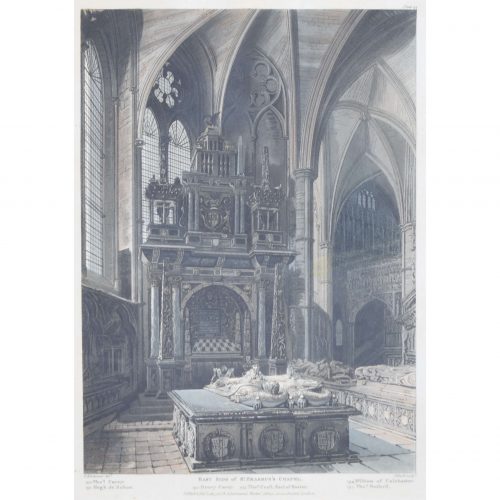
J Black (early 19th century) after Frederick Mackenzie (1788 - 1854)
East Side of St Erasmus' Chapel, Westminster Abbey (1812)
Hand-coloured aquatint 28 x 19 cm Published by Rudolph Ackermann (1764 - 1834). An engraving of the east side of the chapel of St Erasmus in Westminster Abbey. Mackenzie's drawing was engraved by Black and published by Ackermann in his 1812 "History of Westminster Abbey". The chapel was built in the late 15th century by order of Edward IV's wife, Elizabeth Woodville. It would have been used to worship St Erasmus, also known as St Elmo (a Christian saint and martyr venerated as the patron saint of sailors and abdominal pain). The Abbey is an historic, mainly Gothic church in the City of Westminster, London, just to the west of the Palace of Westminster. It is one of the United Kingdom's most notable religious buildings and since Edward the Confessor, a burial site for English and, later, British monarchs. Since the coronation of William the Conqueror in 1066, all coronations of English and British monarchs have occurred in Westminster Abbey. Sixteen royal weddings have occurred at the abbey since 1100. According to a tradition first reported circa 1080, a church was founded at the site (then known as Thorney Island) in the seventh century, in the time of Mellitus, Bishop of London. Construction of the present church began in 1245 on the orders of Henry III. Frederick Mackenzie (1788 - 1854) was a British watercolourist and architectural draughtsman. He first exhibited at the Royal Academy in 1804, and contributed eleven drawings between that year and 1828. He contributed to the Society of Painters in Water Colours exhibitions from 1813, becoming an associate in 1822, and a full member the following year. From 30 November 1831 till his death he was treasurer to the society. In later life Mackenzie was no longer commissioned to illustrate books. Rudolph Ackermann was an Anglo-German bookseller, inventor, lithographer, publisher and businessman. In 1795 he established a print-shop and drawing-school at 96 Strand. Here Ackermann set up a lithographic press and began a trade in prints. He later began to manufacture colours and thick carton paper for landscape and miniature painters. Within three years the premises had become too small and he moved to 101 Strand, in his own words "four doors nearer to Somerset House", the seat of the Royal Academy of Arts. Between 1797 and 1800 Ackermann rapidly developed his print and book publishing business, encompassing many different genres including topography, caricature, portraits, transparencies and decorative prints. Condition: good. Some age toning. If you’d like to know more, please email info@manningfineart.co.uk or call us on 07929 749056. -
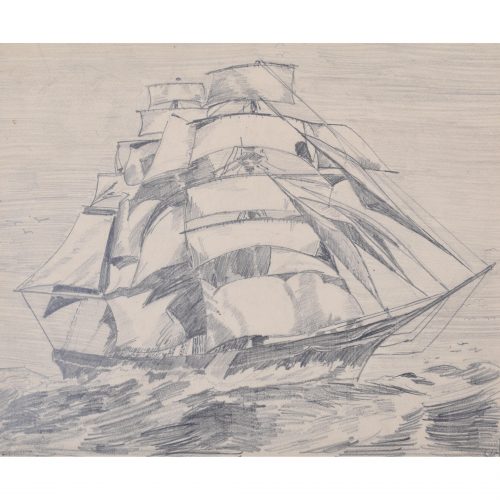
Gerald Mac Spink (flourished 1920 - 1940)
Sailing ship
Pencil 31 x 38 cm A stormy sea and the wind in her sails. Spink was a skilled artist, illustrator, and designer who produced a series of posters in the inter-war period for companies including the London Underground, Southern Railways, LNER, Hawker Engineering, and British Steel. He won a prize in 1933 from the Imperial Institute for his poster artwork. He also worked as an aeronautical engineer in Kingston-on-Thames for Hawker Engineering; his greatest achievement was the creation of the 'Squanderbug', a 500cc racing car which he built in 1947, and which races even to this day. Provenance: the artist's estate. Condition: generally very good. If you are interested, please email info@manningfineart.co.uk or call us on 07929 749056. Click here for other works by the artist. -
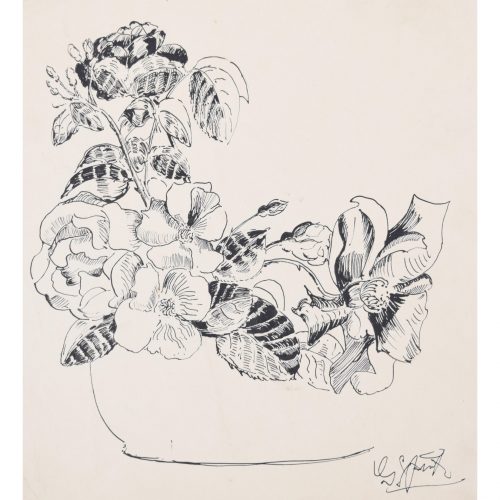
Gerald Mac Spink (flourished 1920 - 1940)
Flowers
Pen and ink 15 x 23 cm Signed 'G Spink' lower right. Spink was a skilled artist, illustrator, and designer who produced a series of posters in the inter-war period for companies including the London Underground, Southern Railways, LNER, Hawker Engineering, and British Steel. He won a prize in 1933 from the Imperial Institute for his poster artwork. He also worked as an aeronautical engineer in Kingston-on-Thames for Hawker Engineering; his greatest achievement was the creation of the 'Squanderbug', a 500cc racing car which he built in 1947, and which races even to this day. Provenance: the artist's estate. Condition: generally very good. If you are interested, please email info@manningfineart.co.uk or call us on 07929 749056. Click here for other works by the artist. -
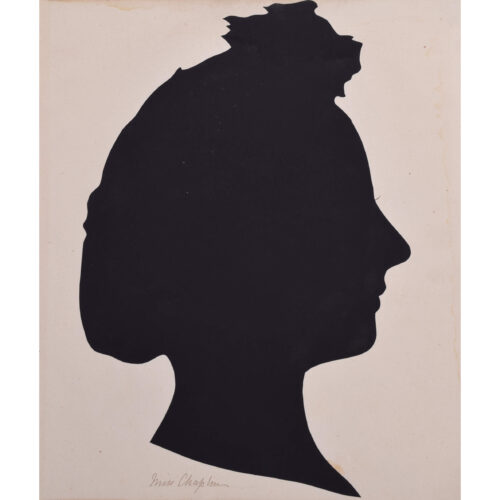
Silhouette (circa 1870)
Miss Chaplin
Gouache, pen, and ink 52 x 44 cm Prior to photography, silhouettes were the easiest way of recording a person's appearance. This set might record the group present at a country house party, a wedding, or other similar convivial occasion. Condition: good. Some staining at upper and right edges. If you are interested, please email info@manningfineart.co.uk or call us on 07929 749056. Click here for other silhouettes. -
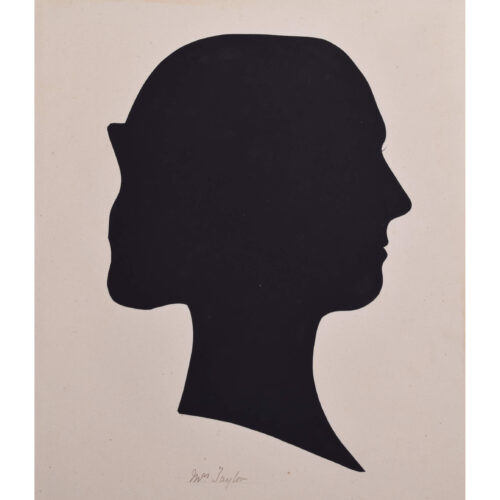
Silhouette (circa 1870)
Mrs Taylor
Gouache, pen, and ink 52 x 44 cm Prior to photography, silhouettes were the easiest way of recording a person's appearance. This set might record the group present at a country house party, a wedding, or other similar convivial occasion. Condition: generally very good. If you are interested, please email info@manningfineart.co.uk or call us on 07929 749056. Click here for other silhouettes. -

Silhouette (circa 1870)
Mrs Warburton
Gouache, pen, and ink 52 x 44 cm Prior to photography, silhouettes were the easiest way of recording a person's appearance. This set might record the group present at a country house party, a wedding, or other similar convivial occasion. Condition: generally very good; some light staining at upper edge. If you are interested, please email info@manningfineart.co.uk or call us on 07929 749056. Click here for other silhouettes. -
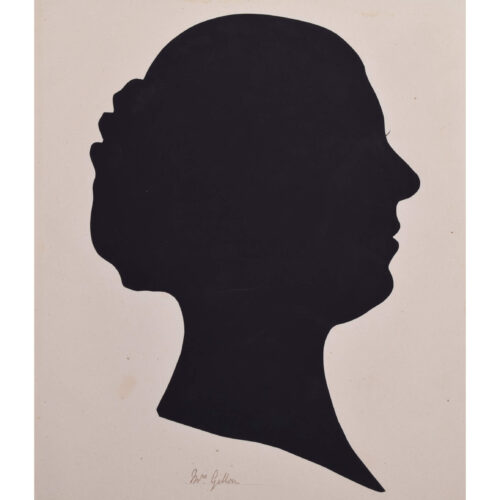
Silhouette (circa 1870)
Mrs Gillon
Gouache, pen, and ink 52 x 44 cm Prior to photography, silhouettes were the easiest way of recording a person's appearance. This set might record the group present at a country house party, a wedding, or other similar convivial occasion. Condition: generally very good; some light staining. If you are interested, please email info@manningfineart.co.uk or call us on 07929 749056. Click here for other silhouettes. -
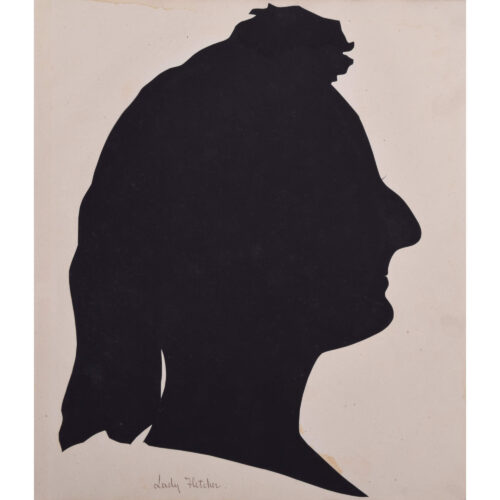
Silhouette (circa 1870)
Lady Fletcher
Gouache, pen, and ink 52 x 44 cm Prior to photography, silhouettes were the easiest way of recording a person's appearance. This set might record the group present at a country house party, a wedding, or other similar convivial occasion. Condition: generally very good; some light staining to right edge. If you are interested, please email info@manningfineart.co.uk or call us on 07929 749056. Click here for other silhouettes. -
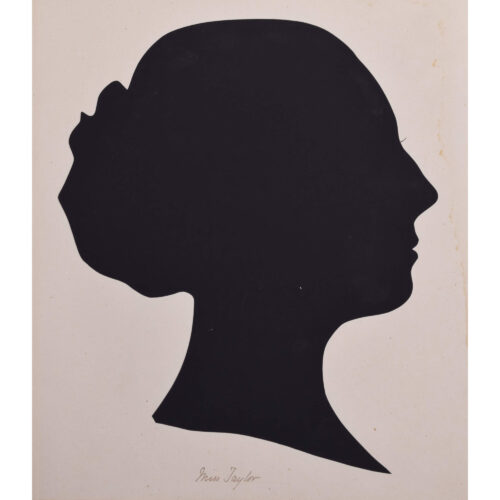
Silhouette (circa 1870)
Miss Taylor
Gouache, pen, and ink 52 x 44 cm Prior to photography, silhouettes were the easiest way of recording a person's appearance. This set might record the group present at a country house party, a wedding, or other similar convivial occasion. Condition: good; some staining to right edge. If you are interested, please email info@manningfineart.co.uk or call us on 07929 749056. Click here for other silhouettes. -
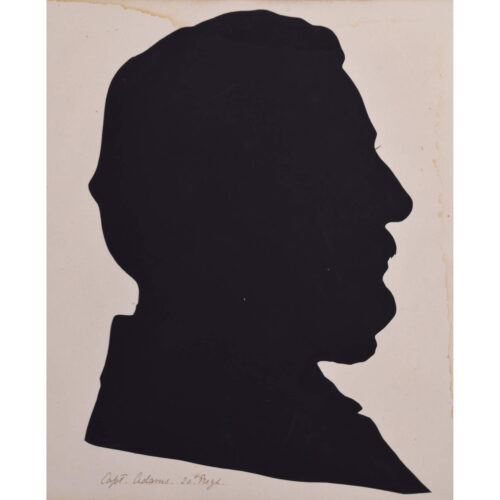
Silhouette (circa 1870)
Captain Adams, 20th Regt
Gouache, pen, and ink 52 x 44 cm Prior to photography, silhouettes were the easiest way of recording a person's appearance. This set might record the group present at a country house party, a wedding, or other similar convivial occasion. Condition: generally good; some staining to upper and right margins. If you are interested, please email info@manningfineart.co.uk or call us on 07929 749056. Click here for other silhouettes. -
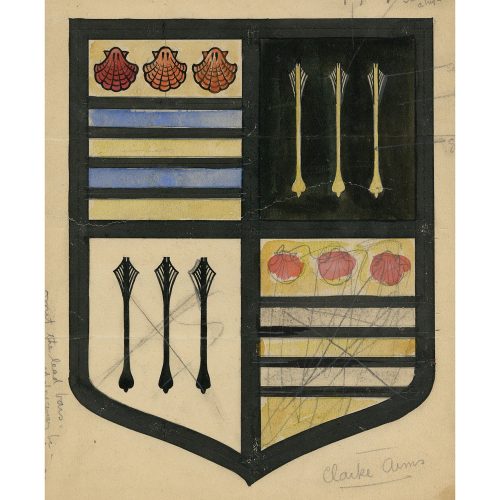
Florence Camm (1874-1960)
Clarke Arms Design
Watercolour and pencil 22x17cm Design for TW Camm & Co. If you are interested email info@manningfineart.co.uk or call us on 07929 749056. -
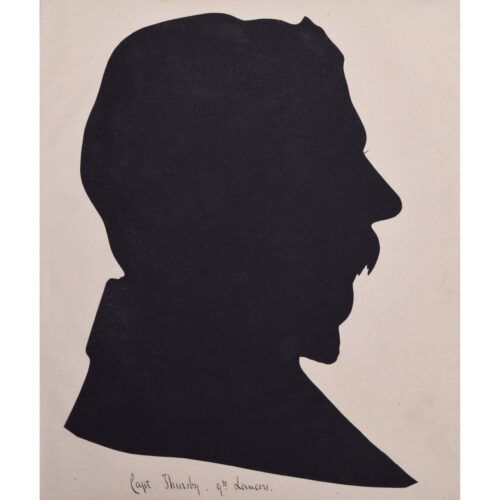
Silhouette (circa 1870)
Captain Thursby, 9th Lancers
Gouache, pen, and ink 52 x 44 cm Captain Piers Thursby was born in 1834 and served in the 9th Queen's Royal Lancers, a cavalry regiment of the British Army, with whom he served during the Indian Mutiny of the 1850s. He was the son of Revd. W. Thursby of Ormerod House and died in 1904. Prior to photography, silhouettes were the easiest way of recording a person's appearance. This set might record the group present at a country house party, a wedding, or other similar convivial occasion. Condition: generally very good; some staining to right edge. If you are interested, please email info@manningfineart.co.uk or call us on 07929 749056. Click here for other silhouettes. -
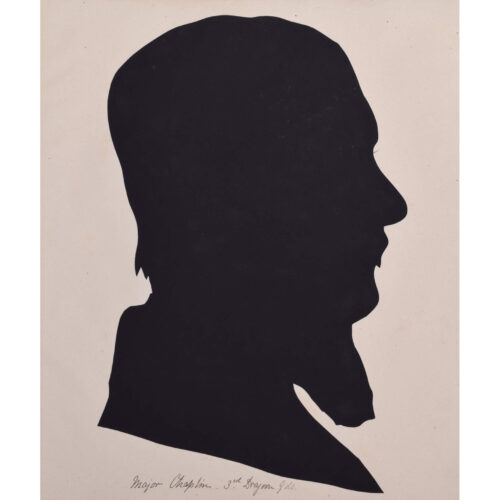
Silhouette (circa 1870)
Major Chaplin, 3rd Dragoon Guards
Gouache, pen, and ink 52 x 44 cm Silhouettes of Mrs F Chaplin and Miss Chaplain, likely the Major's wife and daughter, are also available. Prior to photography, silhouettes were the easiest way of recording a person's appearance. This set might record the group present at a country house party, a wedding, or other similar convivial occasion. Condition: generally very good; some staining to right edge. If you are interested, please email info@manningfineart.co.uk or call us on 07929 749056. Click here for other silhouettes. -
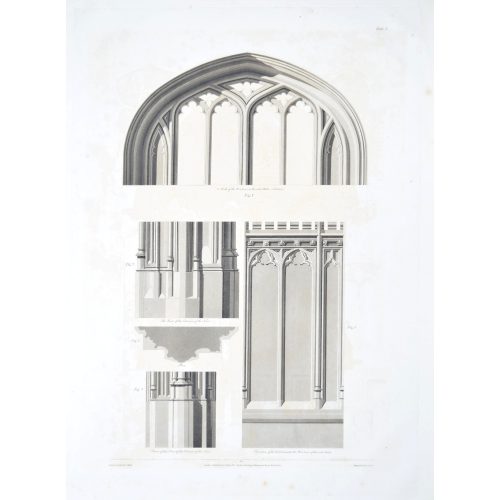
Frederick Nash (1782-1856) Drawn and etched Engraved by F C Lewis Arches and Columns
London Published by F Nash, No 6 Asylum Buildings, Westminster Road July 12 1804 55x39cm Frederick Nash was born in Lambeth. Initially studying architectural drawing under Thomas Malton he subsequently enrolled at the Royal Academy of Arts. From 1801 to 1809 he worked with the antiquarians John Britton and Edward Wedlake Brayley, subsequently becoming a member of the Society of Painters in Watercolours - a group of painters who had left the Royal Academy following complaints of under-recognition of their works. Latterly primarily a landscape painter he toured the rivers of Germany. If you are interested email info@manningfineart.co.uk or call us on 07929 749056. Condition: In generally good condition, some offsetting of ink from adjacent print as visible in image, occasional spotting. Not trimmed. -
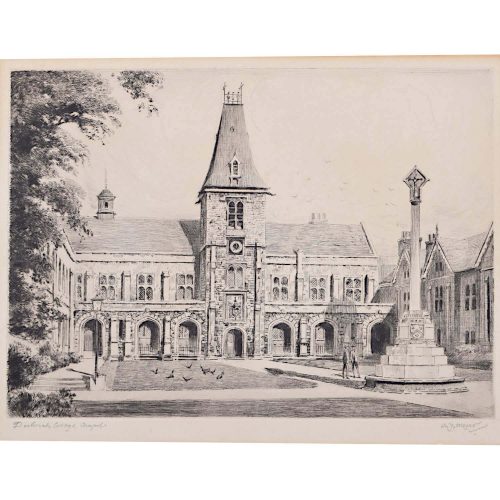
A J Meyer (British, fl 1900-1930) Dulwich College
Etching 22x30cm Sadly little is known of Meyer, an accomplished artist and particularly producer of etchings. He was one of many artists to join the craze for etchings started by Whistler and that died out after the 1929 Wall Street crash. If you are interested email info@manningfineart.co.uk or call us on 07929 749056. Condition: Mounted to board; generally good to very good. -
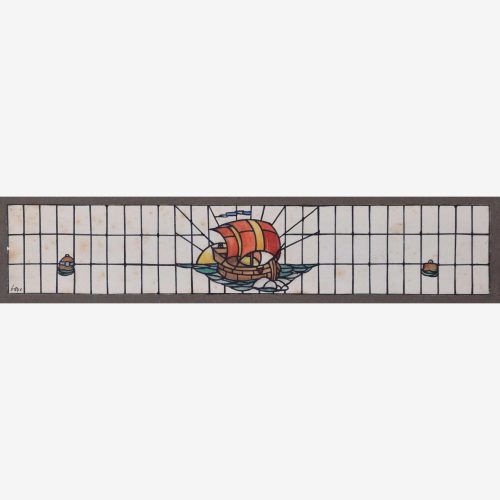
Florence Camm (1874-1960)
Stained Glass Window Design with Red Sailing Ship
Watercolour 6.5x34cm Condition: Some spotting to image; mounted to board - see image. Click for biographical details and other works by Camm. If you are interested email info@manningfineart.co.uk or call us on 07929 749056. -
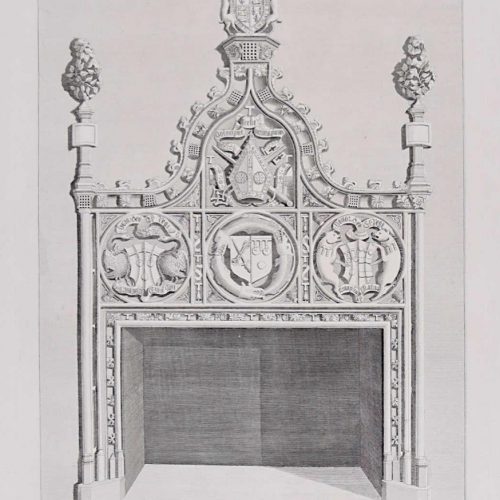
James Basire
James Basire engraving of Bishop's Palace Exeter
Engraving 50 x 33 cm (to plate mark) Published by the Society of Antiquaries 23rd April 1796. A member of the Society of Antiquaries, Basire specialised in architectural prints. He was appointed as engraver to the society, much of his finest works being found in their Vestuta Monumenta. Basire's father Isaac was a cartographer, and both his son and grandson were called James and also worked for the society. William Blake was apprenticed to Basire for seven years. If you are interested, email info@manningfineart.co.ukor call us on 07929 749056. -
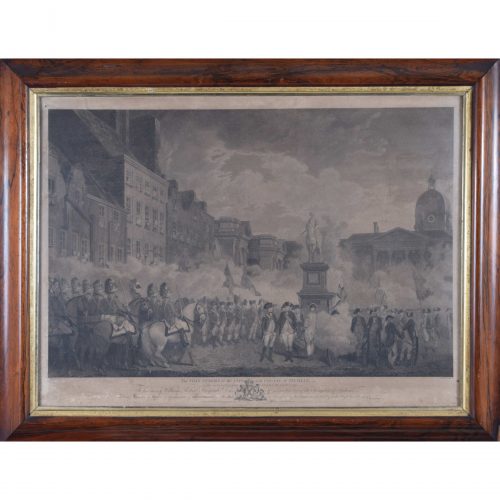
Joseph Collyer (1748 - 1827) after Francis Wheatley (1747 - 1801)
The Volunteers of the City and County of Dublin
Monochrome print 28 x 31 cm A monochrome print depicting Dublin regiments of the Irish Volunteers meeting on College Green. Francis Wheatley depicted the scene in oils in 1779, and Joseph Collyer engraved it in 1781. Wheatley went to Dublin in 1779 and established himself there as a portrait-painter; this view of the Dublin Volunteers became the basis for a best-selling print bought by numerous Irish Patriots. Volunteers were local Irish militias raised by community initiative in Ireland in 1778. Their original purpose was to guard against invasion and to preserve law and order at a time when British soldiers were withdrawn from Ireland to fight abroad during the American Revolutionary War and the government failed to organise its own militia. Taking advantage of Britain's preoccupation with its rebelling American colonies, the Volunteers were able to pressure Westminster into conceding legislative independence to the Dublin parliament. Francis Wheatley was an English portrait and landscape painter who studied at the Royal Academy, and won several prizes from the Society of Arts. He was elected an associate of the Royal Academy in 1790, and an academician in the following year. Joseph Collyer was a British engraver. In 1770 where he exhibited at the Royal Academy for the first time; he was elected an associate engraver of the Royal Academy, and appointed portrait engraver to Queen Charlotte in 1786. Condition: fair. Some browning and staining. In handsome rosewood frame. If you are interested, please email info@manningfineart.co.uk or call us on 07929 749056. -
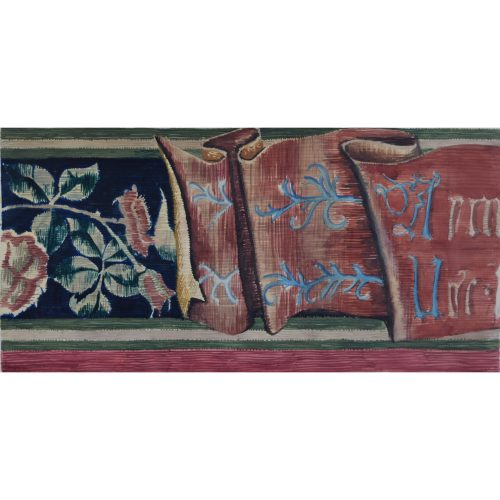
D. L. Hadden
Design for tapestry
Watercolour 25x50cm If you are interested email info@manningfineart.co.uk or call us on 07929 749056. -
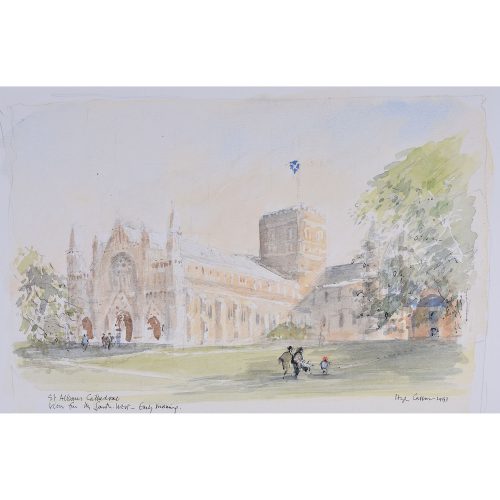
Sir Hugh Casson (1910-1999)
St. Albans Cathedral
Lithographic proof print, out of series. Signed in the plate, not pencil-signed. Provenance: the artist’s estate. 28 x 35 cm (11 x 14 in) If you are interested email info@manningfineart.co.uk or call us on 07929 749056. For biographical details and other works by the artist click here. -
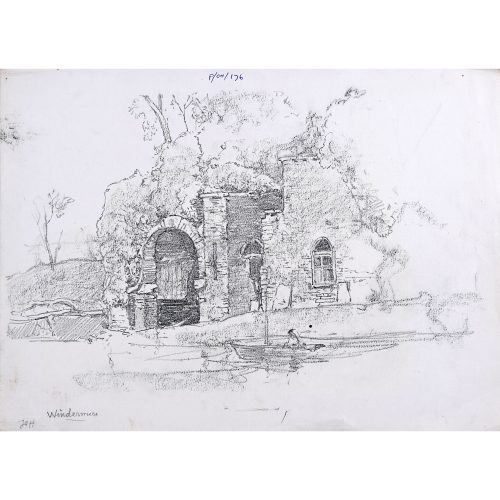
Oliver Hall R.A., R.E., R.W.S. (1869-1957) Boat House, Windermere, Lake District, UK
26x37cm Pencil drawing Provenance: Martin Muncaster, the artist's grandson Inscribed to reverse in pen by Claude or Martin Muncaster Hall was landscape painter in oil and watercolour with a fondness for both Spanish and rugged moorland as subjects. Having studied at the RCA between 1887-90 he attended evening classes at Westminster and Lambeth Schools of Art. Travelling extensively in Spain, France and Italy he began exhibiting etchings at the RA in 1890. Originally from Pulborough he moved in later life to Ulverston, Lancashire. His son was Claude Muncaster. If you are interested email info@manningfineart.co.uk or call us on 07929 749056. Condition: Good. -
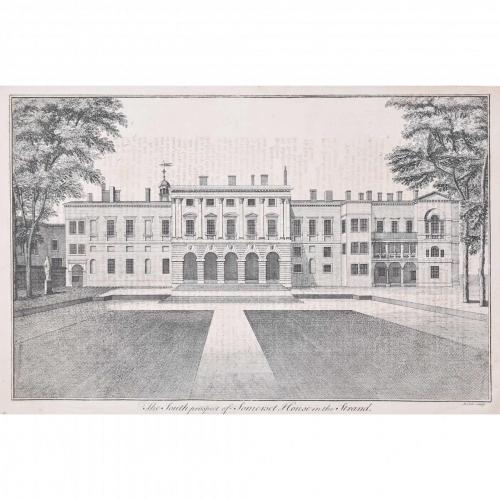
Benjamin Cole (1697-1783)
South Prospect of Somerset House (c. 1753)
Engraving 24 x 37 cm Stow's Survey of London, a ward-by-ward topographical and historical tour of the City of London giving an account of buildings, social conditions and customs, was first published in 1598. Cole's architectural view of Somerset House illustrates the clean neoclassical proportions for which it is known. Condition: Trimmed by the binder's knife within plate marks; some offsetting from facing page; occasional soft creases; generally good. -
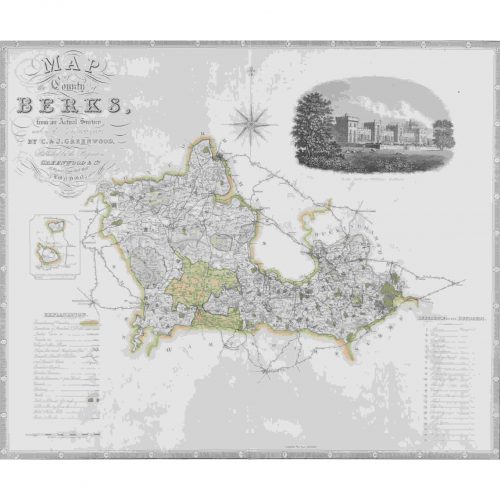
John Dower (1825 - 1901)
Map of Berkshire from an actual survey made in the years 1822 & 1823
Engraving 57 x 69 cm A large antique engraved map of Berkshire. Condition: good; some light staining. If you’d like to know more, please email info@manningfineart.co.uk or call us on 07929 749056. -
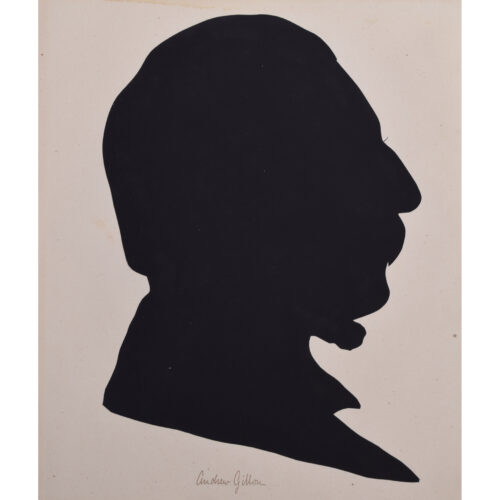
Silhouette (circa 1870)
Andrew Gillon
Gouache, pen, and ink 52 x 44 cm Prior to photography, silhouettes were the easiest way of recording a person's appearance. This set might record the group present at a country house party, a wedding, or other similar convivial occasion. Condition: generally good; some staining to upper edge. If you are interested, please email info@manningfineart.co.uk or call us on 07929 749056. Click here for other silhouettes. -
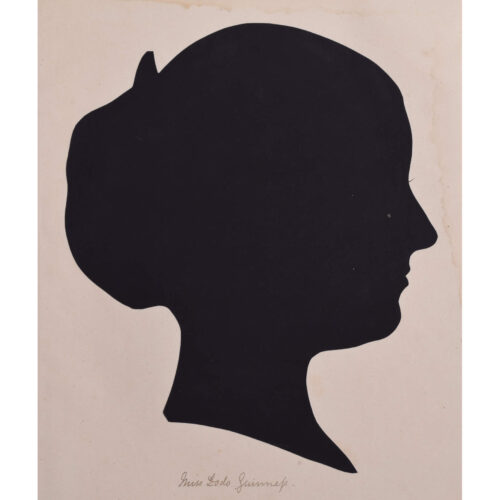
Silhouette (circa 1870)
Miss Dodo Guinness
Gouache, pen, and ink 52 x 44 cm Adelaide Maud Guinness, nicknamed 'Dodo', was descended from the banking line of Guinnesses. Her father was the barrister and MP Richard Samuel Guinness. Dodo married Edward Cecil Guinness, the 1st Earl of Iveagh and her third cousin, in 1873. Edward's father had died in 1868, after which Edward inherited a share of the famous Guinness brewery. The Guinness family seat is Elveden Hall in Suffolk. Prior to photography, silhouettes were the easiest way of recording a person's appearance. This set might record the group present at a country house party, a wedding, or other similar convivial occasion. Condition: generally good; some staining to upper edge. If you’d like to know more, please email info@manningfineart.co.uk or call us on 07929 749056. -
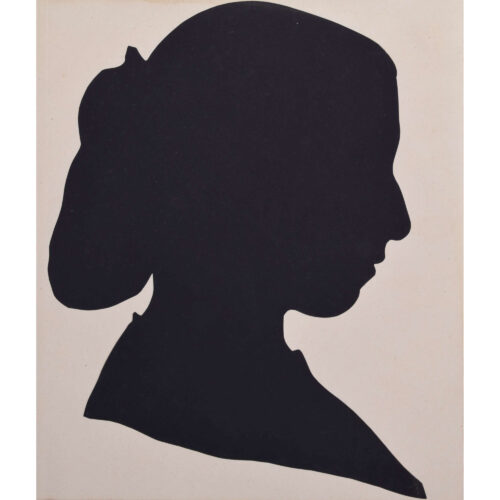
Silhouette of Lady I (circa 1870)
Gouache, pen, and ink 52 x 44 cm Prior to photography, silhouettes were the easiest way of recording a person's appearance. This set might record the group present at a country house party, a wedding, or other similar convivial occasion. Condition: generally good; some staining to upper edge. If you are interested, please email info@manningfineart.co.uk or call us on 07929 749056. Click here for other silhouettes. -
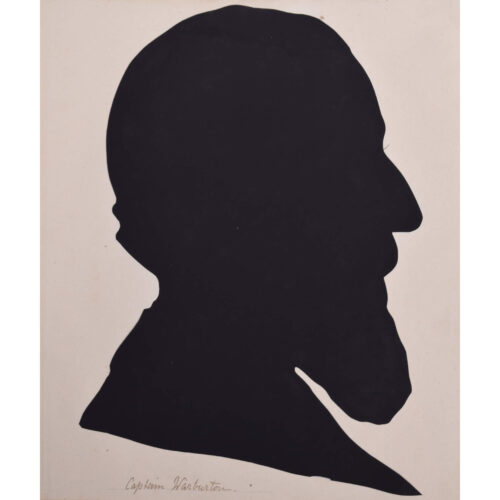
Silhouette (circa 1870)
Captain Warburton
Gouache, pen, and ink 52 x 44 cm Prior to photography, silhouettes were the easiest way of recording a person's appearance. This set might record the group present at a country house party, a wedding, or other similar convivial occasion. Condition: generally very good; occasional spots. If you are interested, please email info@manningfineart.co.uk or call us on 07929 749056. Click here for other silhouettes. -
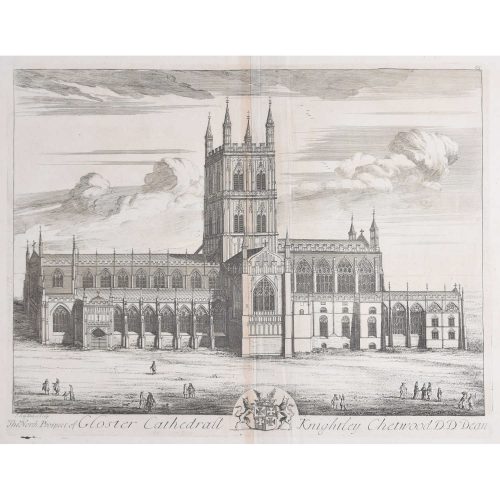
Johannes 'Jan' Kip (1652/3 - 1722)
The North Prospect of Gloster Cathedral (c.1716)
43 x 47 cm Copper engraving Johannes "Jan" Kip was a Dutch engraver, draughtsman and print dealer. After producing works for the court of William of Orange in Amsterdam, Kip followed William and Mary to London, settling in Farringdon and selling prints. Later, Kip collaborated with draughtsman and painter Leonard Knyff, and together they made a popular series of engraved views of English country houses. This print is from Sir Robert Atkyn's 'The Ancient and Present State of Gloucestershire'. In his usual manner - Kip was probably the foremost engraver of his time in England - he has placed figures before the Cathedral to give life - and scale - to the building. Condition: Generally very good with central vertical fold and adjacent parallel creases; one diagonal crease mid left to bottom centre. Will look very good when framed. -
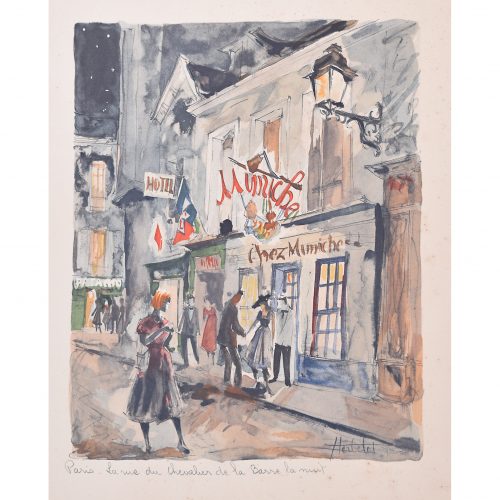 Franz Herbelot (French, active 1940s-1950s) Paris: La Rue de Chevalier de la Barre la nuit Lithograph 28 x 22 cm A fantastic lithograph by Herbelot which brilliantly captures the spirit of mid-century Paris. Little is known of Herbelot's life, but he is most notable for his views of Paris. The Rue de Chevalier de la Barre is a street in Montmartre named after the Knight de la Barre, François-Jean Lefebvre de la Barre, who died in 1766. Here, we see the street as it was in the 20th century, brimming with ladies and gentlemen dressed à la mode, bathed in the warm light of thriving bistros and hotels.
Franz Herbelot (French, active 1940s-1950s) Paris: La Rue de Chevalier de la Barre la nuit Lithograph 28 x 22 cm A fantastic lithograph by Herbelot which brilliantly captures the spirit of mid-century Paris. Little is known of Herbelot's life, but he is most notable for his views of Paris. The Rue de Chevalier de la Barre is a street in Montmartre named after the Knight de la Barre, François-Jean Lefebvre de la Barre, who died in 1766. Here, we see the street as it was in the 20th century, brimming with ladies and gentlemen dressed à la mode, bathed in the warm light of thriving bistros and hotels. -
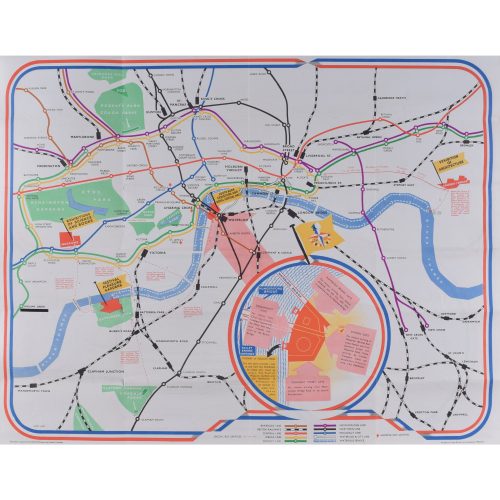
James Hart
Festival of Britain
Lithographic poster map 45 x 58 cm Folding map published for London Transport and British Railways for visitors to the 1951 Festival of Britain, featuring the Abram Games logo, details of water bus services, a detailed plan of the Lambeth exhibition area by Waterloo Bridge. If you are interested email info@manningfineart.co.uk or call us on 07929 749056. -
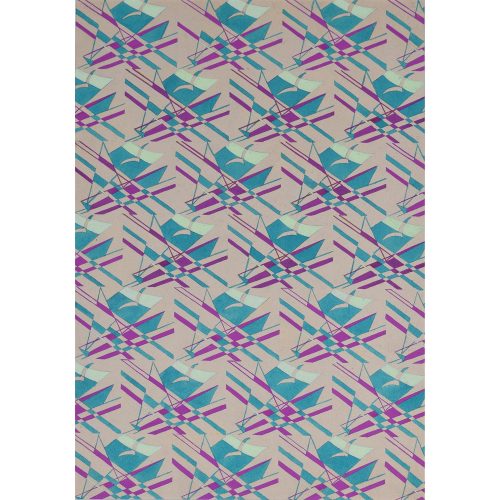
Margaret Macadam (1902-1991)
Seagull and Sailing Boat Wallpaper Design
Watercolour 27x20cm If you are interested email info@manningfineart.co.uk or call us on 07929 749056. -

J Black (early 19th century) after Frederick Mackenzie (1788 - 1854)
The Choir, Westminster Abbey (1812)
Hand-coloured aquatint 28 x 19 cm Published by Rudolph Ackermann (1764 - 1834). An engraving of the vast and soaring interior of Westminster Abbey. Mackenzie's drawing was engraved by Black and published by Ackermann in his 1812 "History of Westminster Abbey". The Abbey is an historic, mainly Gothic church in the City of Westminster, London, just to the west of the Palace of Westminster. It is one of the United Kingdom's most notable religious buildings and since Edward the Confessor, a burial site for English and, later, British monarchs. Since the coronation of William the Conqueror in 1066, all coronations of English and British monarchs have occurred in Westminster Abbey. Sixteen royal weddings have occurred at the abbey since 1100. According to a tradition first reported circa 1080, a church was founded at the site (then known as Thorney Island) in the seventh century, in the time of Mellitus, Bishop of London. Construction of the present church began in 1245 on the orders of Henry III. Frederick Mackenzie (1788 - 1854) was a British watercolourist and architectural draughtsman. He first exhibited at the Royal Academy in 1804, and contributed eleven drawings between that year and 1828. He contributed to the Society of Painters in Water Colours exhibitions from 1813, becoming an associate in 1822, and a full member the following year. From 30 November 1831 till his death he was treasurer to the society. In later life Mackenzie was no longer commissioned to illustrate books. Rudolph Ackermann was an Anglo-German bookseller, inventor, lithographer, publisher and businessman. In 1795 he established a print-shop and drawing-school at 96 Strand. Here Ackermann set up a lithographic press and began a trade in prints. He later began to manufacture colours and thick carton paper for landscape and miniature painters. Within three years the premises had become too small and he moved to 101 Strand, in his own words "four doors nearer to Somerset House", the seat of the Royal Academy of Arts. Between 1797 and 1800 Ackermann rapidly developed his print and book publishing business, encompassing many different genres including topography, caricature, portraits, transparencies and decorative prints. Condition: good. Some age toning. If you’d like to know more, please email info@manningfineart.co.uk or call us on 07929 749056. -
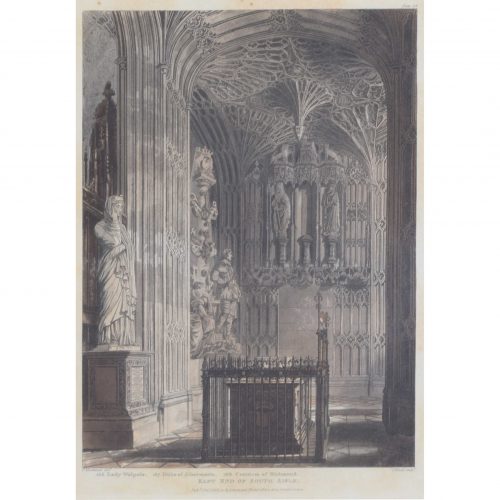
J Black (early 19th century) after Frederick Mackenzie (1788 - 1854)
East End of South Aisle, Westminster Abbey (1812)
Hand-coloured aquatint 31 x 24 cm Published by Rudolph Ackermann (1764 - 1834). An engraving of the East End of Westminster Abbey's south aisle. Mackenzie's drawing was engraved by Black and published by Ackermann in his 1812 "History of Westminster Abbey". Charles II, Queen Anne, Queen Mary II and her husband King William III, and Mary, Queen of Scots are all buried in the south aisle. The Abbey is an historic, mainly Gothic church in the City of Westminster, London, just to the west of the Palace of Westminster. It is one of the United Kingdom's most notable religious buildings and since Edward the Confessor, a burial site for English and, later, British monarchs. Since the coronation of William the Conqueror in 1066, all coronations of English and British monarchs have occurred in Westminster Abbey. Sixteen royal weddings have occurred at the abbey since 1100. According to a tradition first reported circa 1080, a church was founded at the site (then known as Thorney Island) in the seventh century, in the time of Mellitus, Bishop of London. Construction of the present church began in 1245 on the orders of Henry III. Frederick Mackenzie (1788 - 1854) was a British watercolourist and architectural draughtsman. He first exhibited at the Royal Academy in 1804, and contributed eleven drawings between that year and 1828. He contributed to the Society of Painters in Water Colours exhibitions from 1813, becoming an associate in 1822, and a full member the following year. From 30 November 1831 till his death he was treasurer to the society. In later life Mackenzie was no longer commissioned to illustrate books. Rudolph Ackermann was an Anglo-German bookseller, inventor, lithographer, publisher and businessman. In 1795 he established a print-shop and drawing-school at 96 Strand. Here Ackermann set up a lithographic press and began a trade in prints. He later began to manufacture colours and thick carton paper for landscape and miniature painters. Within three years the premises had become too small and he moved to 101 Strand, in his own words "four doors nearer to Somerset House", the seat of the Royal Academy of Arts. Between 1797 and 1800 Ackermann rapidly developed his print and book publishing business, encompassing many different genres including topography, caricature, portraits, transparencies and decorative prints. Condition: good. Some age toning. If you’d like to know more, please email info@manningfineart.co.uk or call us on 07929 749056. -
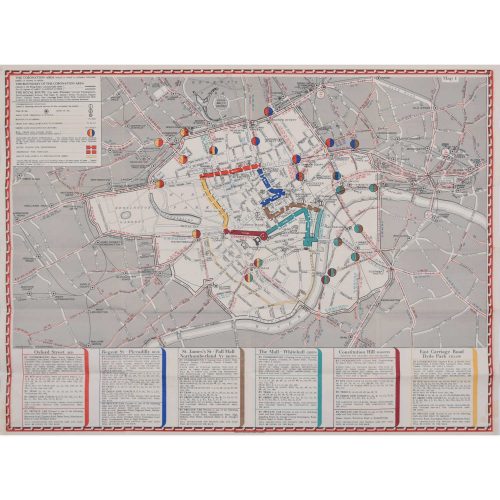
Coronation Arrangements - Map of London (1937)
Lithograph 45 x 60 cm (unfolded) Published by London Transport for the Coronation of George VI, this map illustrates the route the King took in 1936. And best of all, it's just (almost!) as useful in today's London. Condition: generally very good. If you are interested, please email info@manningfineart.co.uk or call us on 07929 749056. -
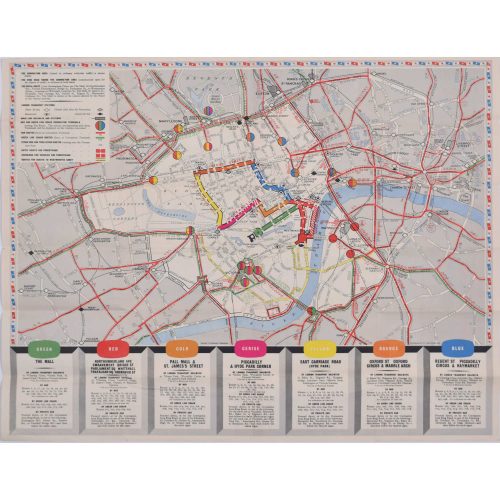
Coronation Arrangements - Map of London (1953)
Lithograph 45 x 60 cm (unfolded) Published by London Transport for the Coronation of Elizabeth II, this delightfully-coloured map illustrates the route taken by the Queen when she was crowned in 1953. Condition: generally very good. If you are interested, please email info@manningfineart.co.uk or call us on 07929 749056. -
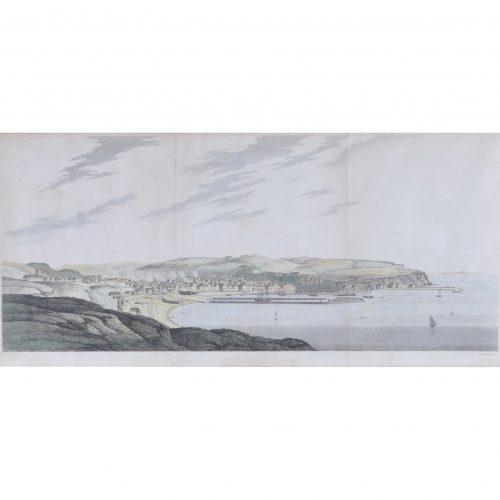
Elizabeth Byrne (1777 - 1849) after Joseph Farington RA (1747 - 1821)
North View of Whitehaven, Cumbria
Hand-coloured engraving 27.5 x 56.5 cm A view of the cliffs and port of Whitehaven in Cumbria. Joseph Farington RA was an 18th-century English landscape painter and diarist. He drew a north and south view of Whitehaven, which were engraved by Elizabeth Byrne in the early 19th century. Byrne was a London-born etcher and landscape painter, who was taught by her father, the etcher William Byrne. She and her father contributed etchings to the 'Magna Britannia' and 'Britannia depicta', books illustrating the most interesting views in various English counties, published by Samuel Lysons in the late 1810s. Condition: good. Two folds and some light age toning. If you are interested, please email info@manningfineart.co.uk or call us on 07929 749056. -
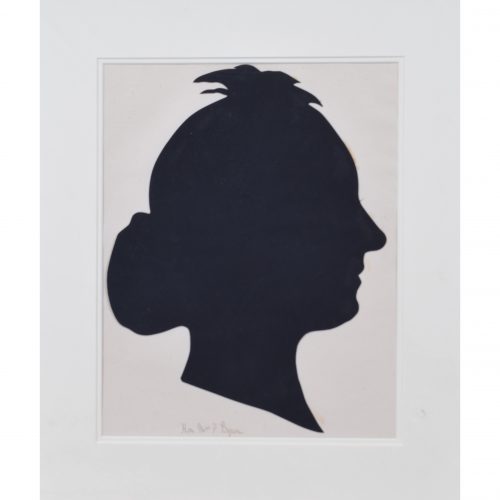
Silhouette (circa 1870)
The Hon Mrs F Byron
Gouache, pen, and ink 52 x 44 cm Likely Mary Jane Wescomb, the daughter of the daughter of Reverend William Wescomb. She married the Hon Frederick Byron in 1851; Byron was a cricketer educated at Westminster and Balliol College, Oxford, and became a fellow at All Souls College in 1843. The couple moved in to Langford Grove together after their marriage. Prior to photography, silhouettes were the easiest way of recording a person's appearance. This set might record the group present at a country house party, a wedding, or other similar convivial occasion. Condition: generally very good. If you’d like to know more, please email info@manningfineart.co.uk or call us on 07929 749056. -
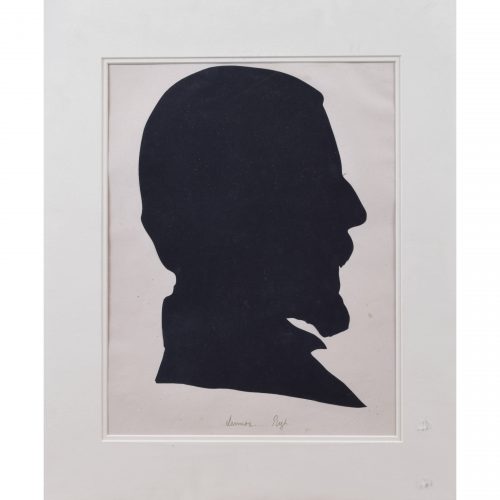
Silhouette (circa 1870)
Lennox
Gouache, pen, and ink 52 x 44 cm Prior to photography, silhouettes were the easiest way of recording a person's appearance. This set might record the group present at a country house party, a wedding, or other similar convivial occasion. Condition: generally very good. If you’d like to know more, please email info@manningfineart.co.uk or call us on 07929 749056. -
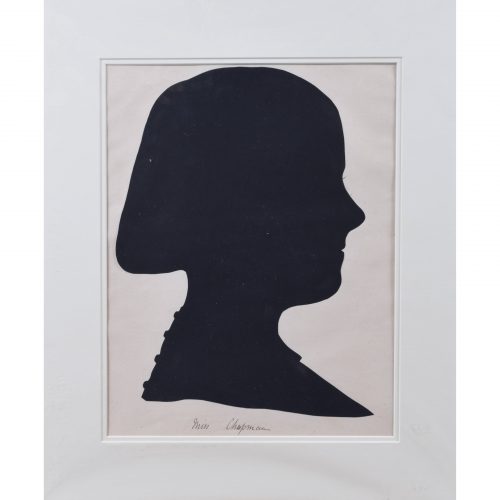
Silhouette (circa 1870)
Miss Chapman
Gouache, pen, and ink 52 x 44 cm One of the daughters of David Barclay Chapman - either Ella Maria or Eugenia Susannah. His other daughter, Adeline Mary, appears in another silhouette from this particular set. David Barclay Chapman was a partner in the bank which in 1896 became the Limited Company Barclay & Co, known today as Barclay's. Prior to photography, silhouettes were the easiest way of recording a person's appearance. This set might record the group present at a country house party, a wedding, or other similar convivial occasion. Condition: generally very good. If you’d like to know more, please email info@manningfineart.co.uk or call us on 07929 749056. -

Silhouette (circa 1870)
David Barclay Chapman
Gouache, pen, and ink 52 x 44 cm David Barclay Chapman was a partner in the bank which in 1896 became the Limited Company Barclay & Co, known today as Barclay's. Two of his daughters appear in other silhouettes from this particular set. Prior to photography, silhouettes were the easiest way of recording a person's appearance. This set might record the group present at a country house party, a wedding, or other similar convivial occasion. Condition: generally good; some staining to upper edge. If you are interested, please email info@manningfineart.co.uk or call us on 07929 749056. Click here for other silhouettes. -
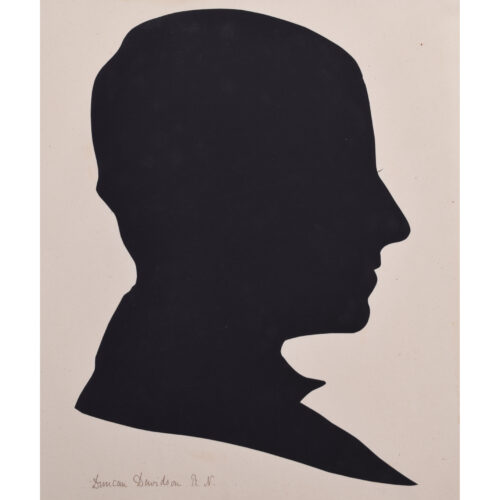
Silhouette (circa 1870)
Duncan Davidson RN
Gouache, pen, and ink 52 x 44 cm Captain Duncan George Davidson was born in 1833 served in the Royal Navy. He became a Captain in 1872 and captained H.M.S. Serapis between 1876 and 1879; he retired a year later. Prior to photography, silhouettes were the easiest way of recording a person's appearance. This set might record the group present at a country house party, a wedding, or other similar convivial occasion. Condition: generally very good. If you are interested, please email info@manningfineart.co.uk or call us on 07929 749056. Click here for other silhouettes. -
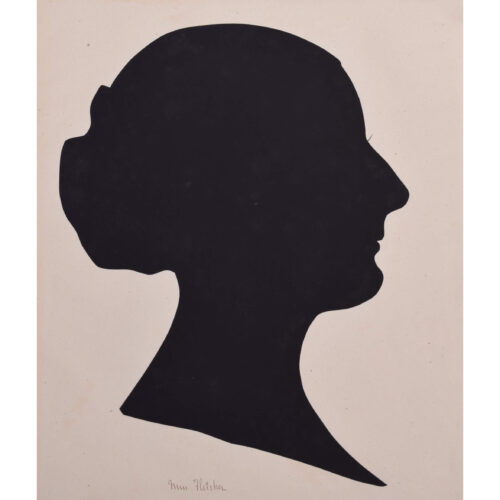
Silhouette (circa 1870)
Miss Fletcher
Gouache, pen, and ink 52 x 44 cm Prior to photography, silhouettes were the easiest way of recording a person's appearance. This set might record the group present at a country house party, a wedding, or other similar convivial occasion. Condition: generally very good. If you are interested, please email info@manningfineart.co.uk or call us on 07929 749056. Click here for other silhouettes. -
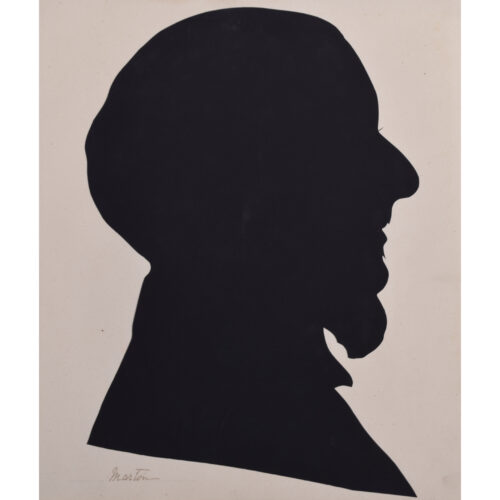
Silhouette (circa 1870)
Marton
Gouache, pen, and ink 52 x 44 cm Prior to photography, silhouettes were the easiest way of recording a person's appearance. This set might record the group present at a country house party, a wedding, or other similar convivial occasion. Condition: generally very good. If you are interested, please email info@manningfineart.co.uk or call us on 07929 749056. Click here for other silhouettes. -
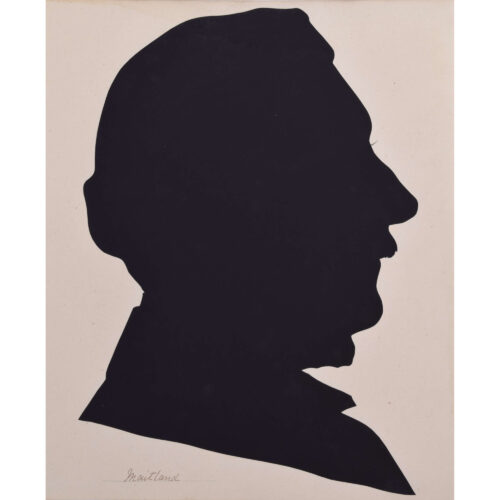
Silhouette (circa 1870)
Maitland
Gouache, pen, and ink 52 x 44 cm Prior to photography, silhouettes were the easiest way of recording a person's appearance. This set might record the group present at a country house party, a wedding, or other similar convivial occasion. Condition: very good. If you are interested, please email info@manningfineart.co.uk or call us on 07929 749056. Click here for other silhouettes. -
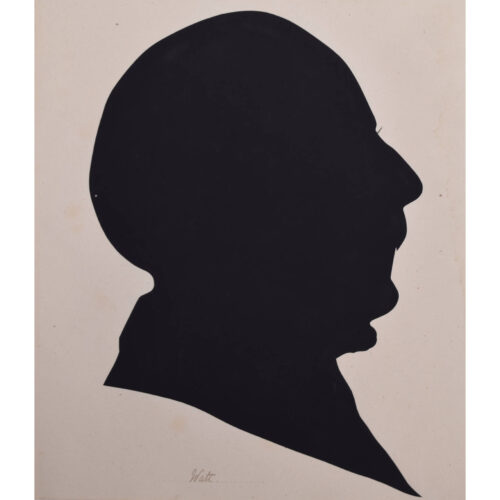
Silhouette (circa 1870)
Watt
Gouache, pen, and ink 52 x 44 cm Prior to photography, silhouettes were the easiest way of recording a person's appearance. This set might record the group present at a country house party, a wedding, or other similar convivial occasion. Condition: generally very good. If you are interested, please email info@manningfineart.co.uk or call us on 07929 749056. Click here for other silhouettes. -
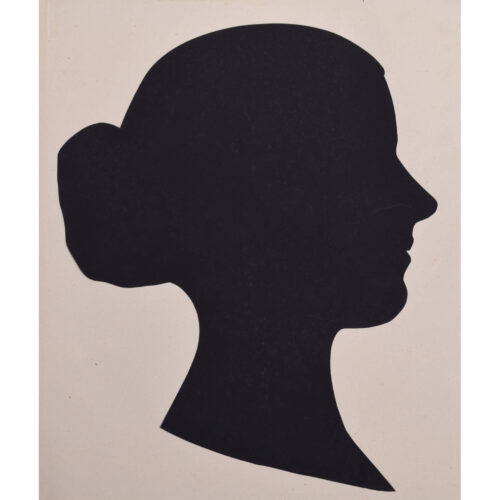
Silhouette of a Lady III (circa 1870)
Gouache, pen, and ink 52 x 44 cm Prior to photography, silhouettes were the easiest way of recording a person's appearance. This set might record the group present at a country house party, a wedding, or other similar convivial occasion. Condition: very good. If you are interested, please email info@manningfineart.co.uk or call us on 07929 749056. Click here for other silhouettes. -
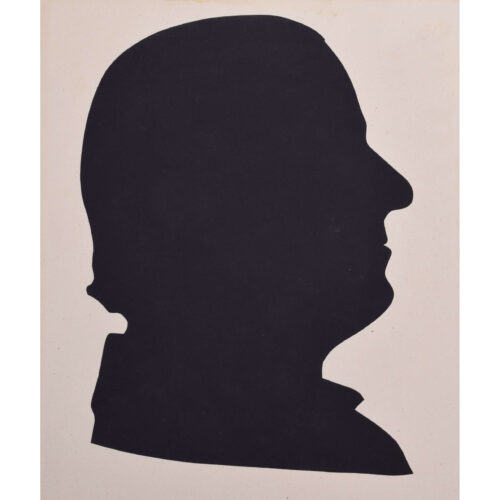
Silhouette of a Gentleman I (circa 1870)
Gouache, pen, and ink 52 x 44 cm Prior to photography, silhouettes were the easiest way of recording a person's appearance. This set might record the group present at a country house party, a wedding, or other similar convivial occasion. Condition: generally very good. If you are interested, please email info@manningfineart.co.uk or call us on 07929 749056. Click here for other silhouettes. -
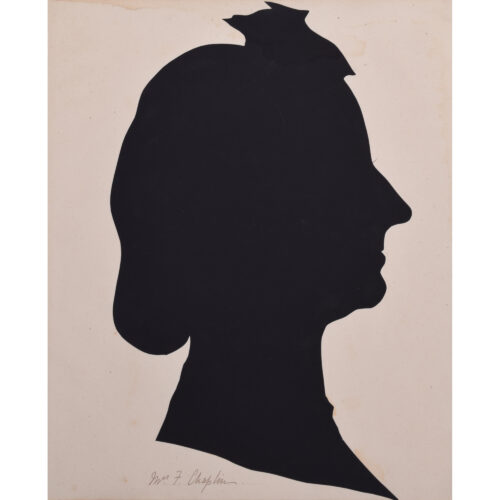
Silhouette (circa 1870)
Mrs F Chaplin
Gouache, pen, and ink 52 x 44 cm Prior to photography, silhouettes were the easiest way of recording a person's appearance. This set might record the group present at a country house party, a wedding, or other similar convivial occasion. Condition: generally good; some staining. If you are interested, please email info@manningfineart.co.uk or call us on 07929 749056. Click here for other silhouettes. -
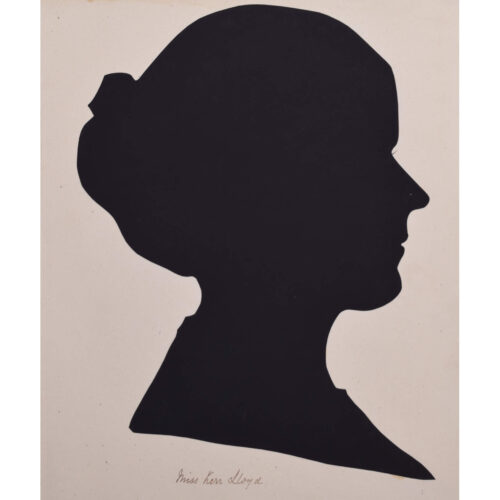
Silhouette (circa 1870)
Miss Kerr Lloyd
Gouache, pen, and ink 52 x 44 cm Prior to photography, silhouettes were the easiest way of recording a person's appearance. This set might record the group present at a country house party, a wedding, or other similar convivial occasion. Condition: very good. If you are interested, please email info@manningfineart.co.uk or call us on 07929 749056. Click here for other silhouettes. -
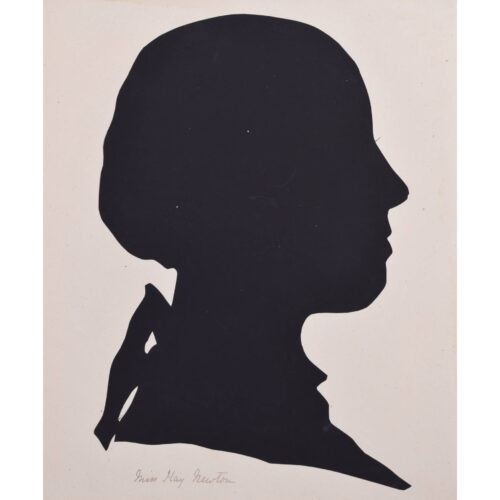
Silhouette (circa 1870)
Miss Hay Newton
Gouache, pen, and ink 52 x 44 cm The Hay-Newtons were a wealthy family from East Lothian in Scotland. Prior to photography, silhouettes were the easiest way of recording a person's appearance. This set might record the group present at a country house party, a wedding, or other similar convivial occasion. Condition: very good. If you are interested, please email info@manningfineart.co.uk or call us on 07929 749056. Click here for other silhouettes. -
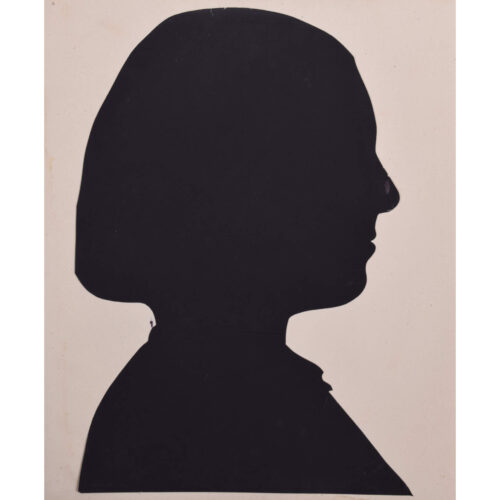
Silhouette (circa 1870)
Miss Alice Lowneley
Gouache, pen, and ink 52 x 44 cm Prior to photography, silhouettes were the easiest way of recording a person's appearance. This set might record the group present at a country house party, a wedding, or other similar convivial occasion. Condition: generally good; some staining. If you are interested, please email info@manningfineart.co.uk or call us on 07929 749056. Click here for other silhouettes. -
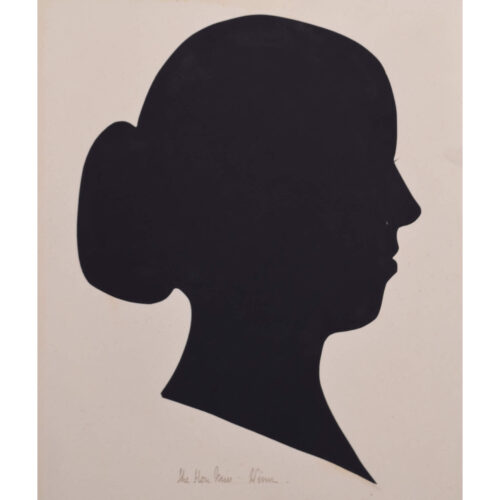
Silhouette (circa 1870)
The Hon Miss Winn
Gouache, pen, and ink 52 x 44 cm Prior to photography, silhouettes were the easiest way of recording a person's appearance. This set might record the group present at a country house party, a wedding, or other similar convivial occasion. Condition: generally very good. If you are interested, please email info@manningfineart.co.uk or call us on 07929 749056. Click here for other silhouettes. -
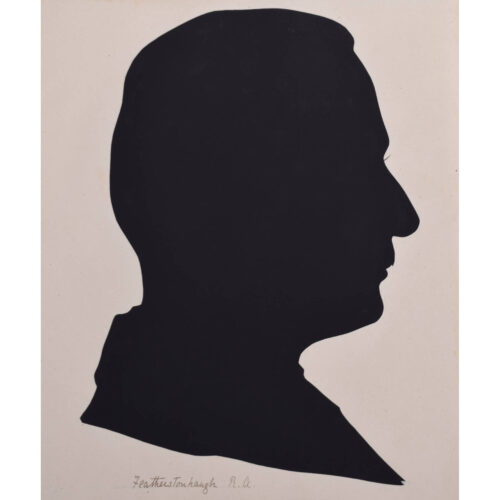
Silhouette (circa 1870)
Major Chaplin, 3rd Dragoon Guards
Gouache, pen, and ink 52 x 44 cm A silhouette of Featherstone (Christian name and rank unknown) of the Royal Artillery. Prior to photography, silhouettes were the easiest way of recording a person's appearance. This set might record the group present at a country house party, a wedding, or other similar convivial occasion. Condition: generally very good. If you are interested, please email info@manningfineart.co.uk or call us on 07929 749056. Click here for other silhouettes. -
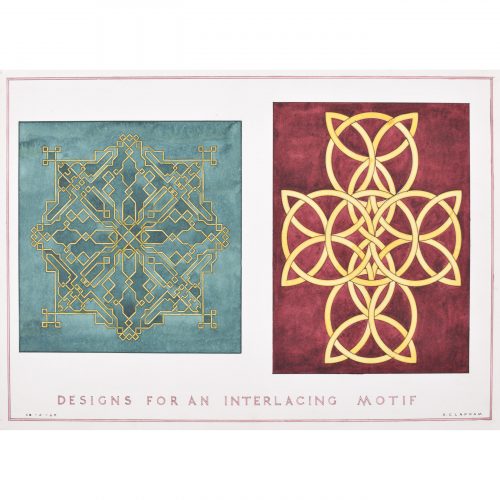
S Clapham (active 1940 - 1960)
Designs for an Interlacing Motif (1949)
Watercolour 37 x 52 cm Dated 26-2-1949 and signed. Clapham was an architect based in Stockwell in London. Condition: very good. If you are interested, please email info@manningfineart.co.uk or call us on 07929 749056. Click here for other works by the artist. -
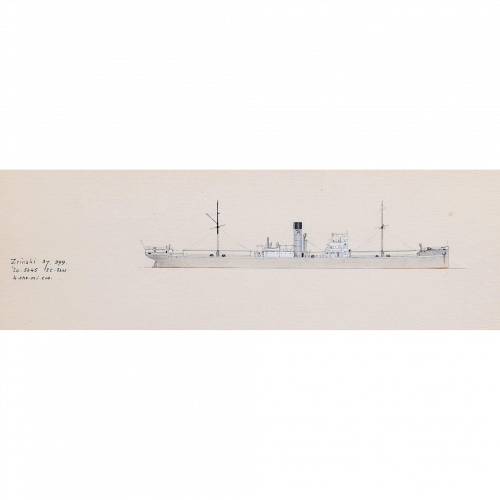
Laurence Dunn (1910-2006)
SS Zrinski (c.1925)
4 x 17 cm Ink and bodycolour on paper Zrinski was built by the Northumberland Shipbuilding Co Ltd. Following a period in Norwegian ownership it was transferred to Yugoslavian ownership in 1927. In 1940 it was acquired by the Crest Shipping Co Ltd, and sunk by German U-Boat U-140 on 8 December 1940 - as SS Ashcrest. Dunn's drawings of coastal tramps are early works, likely sketched from the side of the Thames estuary near his home. The World Ship Society published the following obituary for the well-published maritime artist and writer in 2006: DUNN, Laurence. [December 15 2006 — Lloyds List] Many readers will be saddened by the death of well-known marine artist and writer Laurence Dunn in his 97th year. A man of encyclopaedic knowledge, he began his lifelong love of ships in Brixham, where he meticulously recorded passing traffic with the exquisitely accurate line drawings which later became something of a trademark. While studying at London’s Central School of Art his work was noticed by the Southern Railway, which commissioned profiles of its fleet, and this in turn led to work for Orient Line, where he also designed the well-known corn-coloured hull, and later Thorneycroft, where he helped with shaping draft plans for a new royal yacht. During the second world was he worked for naval intelligence at the Admiralty, where his technique did much to improve recognition standards, and greatly expanded his shipping clientele, becoming personally known to many chairmen. As well as the shipping press he worked for mainstream publications such as Everybody’s, Sphere and the upmarket comic Eagle. Through his many contacts he enjoyed going to sea in a great variety of ships from aircraft carriers to colliers. Laurence wrote several books, starting with ship recognition titles which introduced new standards of layout, but his best known work was probably Passenger Liners, which was widely taken up by the travel trade. His love of Greece, where he was an early publicist of island cruising, let to involvement in reshaping various passenger liners beginning with Greek Line’s OLYMPIA. In later life he designed several sets of shipping stamps for the Crown Agents, produced photographic volumes on Thames and Mediterranean shipping and still found time to enjoy the passing Thames traffic. Our sympathies go to his wife Jennifer, who provided succour to the many ship lovers who beat a path to the welcoming door of their Gravesend home. Condition: Generally very good, slight toning to paper. If you'd like to know more, please email info@manningfineart.co.uk or call us on 07929 749056. -
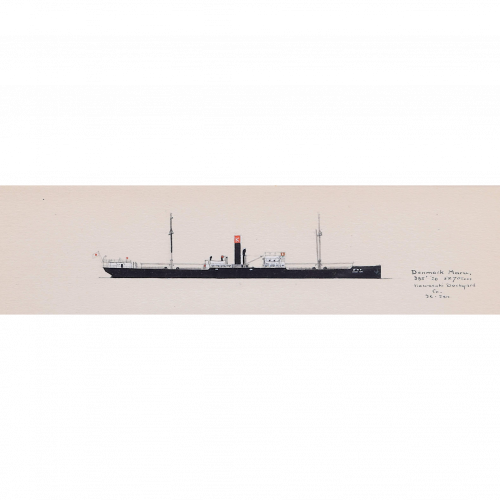
Laurence Dunn (1910-2006)
SS Denmark Maru (c.1927)
4 x 17 cm Ink and bodycolour on paper SS Denmark Maru was built by Kawasaki Shipyard Co in Japan. Until 1935 she was in service on K Line's Hamburg - New York route. Dunn's drawings of coastal tramps are early works, likely sketched from the side of the Thames estuary near his home. The World Ship Society published the following obituary for the well-published maritime artist and writer in 2006: DUNN, Laurence. [December 15 2006 — Lloyds List] Many readers will be saddened by the death of well-known marine artist and writer Laurence Dunn in his 97th year. A man of encyclopaedic knowledge, he began his lifelong love of ships in Brixham, where he meticulously recorded passing traffic with the exquisitely accurate line drawings which later became something of a trademark. While studying at London’s Central School of Art his work was noticed by the Southern Railway, which commissioned profiles of its fleet, and this in turn led to work for Orient Line, where he also designed the well-known corn-coloured hull, and later Thorneycroft, where he helped with shaping draft plans for a new royal yacht. During the second world was he worked for naval intelligence at the Admiralty, where his technique did much to improve recognition standards, and greatly expanded his shipping clientele, becoming personally known to many chairmen. As well as the shipping press he worked for mainstream publications such as Everybody’s, Sphere and the upmarket comic Eagle. Through his many contacts he enjoyed going to sea in a great variety of ships from aircraft carriers to colliers. Laurence wrote several books, starting with ship recognition titles which introduced new standards of layout, but his best known work was probably Passenger Liners, which was widely taken up by the travel trade. His love of Greece, where he was an early publicist of island cruising, let to involvement in reshaping various passenger liners beginning with Greek Line’s OLYMPIA. In later life he designed several sets of shipping stamps for the Crown Agents, produced photographic volumes on Thames and Mediterranean shipping and still found time to enjoy the passing Thames traffic. Our sympathies go to his wife Jennifer, who provided succour to the many ship lovers who beat a path to the welcoming door of their Gravesend home. Condition: Generally very good, slight toning to paper. If you'd like to know more, please email info@manningfineart.co.uk or call us on 07929 749056. -
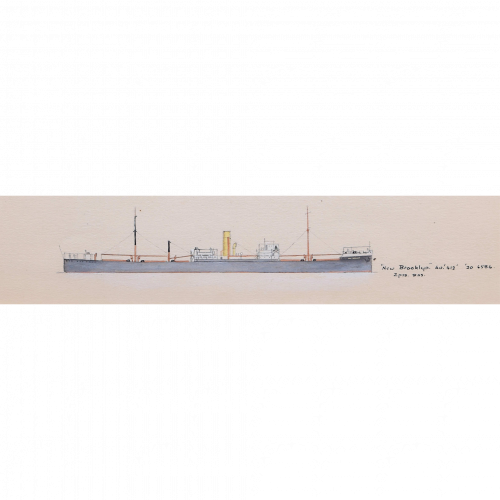
Laurence Dunn (1910-2006)
SS New Brooklyn (c.1927)
4 x 17 cm Ink and bodycolour on paper SS New Brooklyn was built in Belfast by Harland & Wolff in 1920 for Elder Dempster & Co, and was known initially as New Romance. In 1954, she was sold to Mageolia Nav SA, Panama and renamed Marianna. She was scrapped in 1959 at La Spezia. She was an 'N' Type fabricated ship with straight frames which was introduced in 1917 to utilise the capacity of bridge building companies which had very little of their normal bridge-building work to do during the war. Dunn's drawings of coastal tramps are early works, likely sketched from the side of the Thames estuary near his home. The World Ship Society published the following obituary for the well-published maritime artist and writer in 2006: DUNN, Laurence. [December 15 2006 — Lloyds List] Many readers will be saddened by the death of well-known marine artist and writer Laurence Dunn in his 97th year. A man of encyclopaedic knowledge, he began his lifelong love of ships in Brixham, where he meticulously recorded passing traffic with the exquisitely accurate line drawings which later became something of a trademark. While studying at London’s Central School of Art his work was noticed by the Southern Railway, which commissioned profiles of its fleet, and this in turn led to work for Orient Line, where he also designed the well-known corn-coloured hull, and later Thorneycroft, where he helped with shaping draft plans for a new royal yacht. During the second world was he worked for naval intelligence at the Admiralty, where his technique did much to improve recognition standards, and greatly expanded his shipping clientele, becoming personally known to many chairmen. As well as the shipping press he worked for mainstream publications such as Everybody’s, Sphere and the upmarket comic Eagle. Through his many contacts he enjoyed going to sea in a great variety of ships from aircraft carriers to colliers. Laurence wrote several books, starting with ship recognition titles which introduced new standards of layout, but his best known work was probably Passenger Liners, which was widely taken up by the travel trade. His love of Greece, where he was an early publicist of island cruising, let to involvement in reshaping various passenger liners beginning with Greek Line’s OLYMPIA. In later life he designed several sets of shipping stamps for the Crown Agents, produced photographic volumes on Thames and Mediterranean shipping and still found time to enjoy the passing Thames traffic. Our sympathies go to his wife Jennifer, who provided succour to the many ship lovers who beat a path to the welcoming door of their Gravesend home. Condition: Generally very good, slight toning to paper. If you'd like to know more, please email info@manningfineart.co.uk or call us on 07929 749056. -
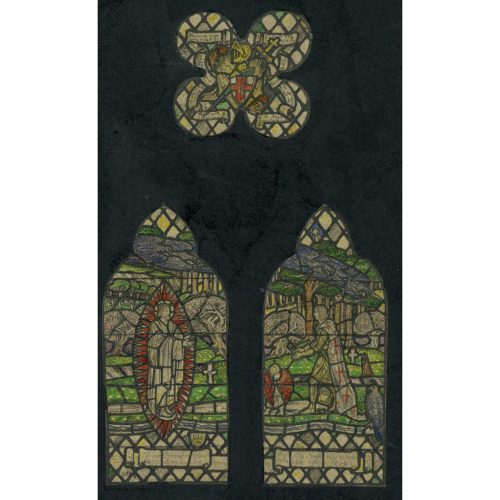
Florence Camm (1874-1960)
Arthurian Stained Glass Window Design II
Watercolour 16x9.5cm Design for TW Camm & Co., Smethwick, Birmingham. If you are interested email info@manningfineart.co.uk or call us on 07929 749056. -
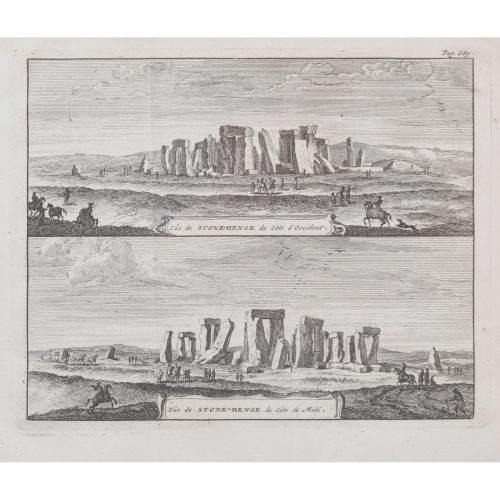
Pieter van der Aa (1659-1733), after David Loggan (1634–1692)
Stonehenge (1727)
Engraving 12 x 16 cm Two eighteenth-century views of the pagan and mystical Stonehenge, engraved by Pieter van der Aa after David Loggan, the noted engraver, draughtsman, and painter. Pieter van der Aa of Leiden was a Dutch publisher best known for preparing maps and atlases, though he also printed editions of foreign bestsellers and illustrated volumes. He is noted for the many engravings he produced after David Loggan's series of Oxford and Cambridge colleges and costumes. In 1727 Van Der Aa illustrated "Les Delices de la Grande Bretagne & de L'Irelande" by James Beeverell, the book in which this engraving appears. Condition: a good impression. If you’d like to know more, please email info@manningfineart.co.uk or call us on 07929 749056. -
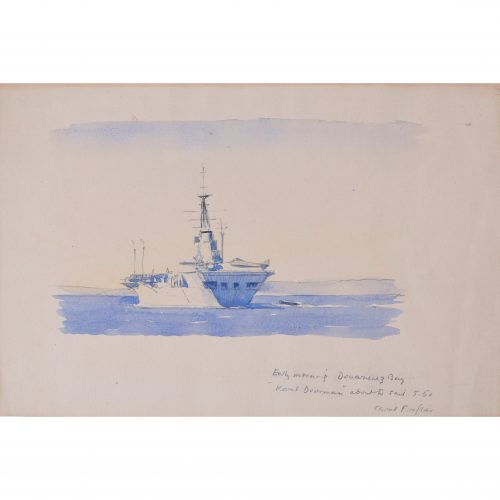
Laurence Dunn (1910-2006)
Karel Doorman About to Sail
Watercolour 15 x 23 cm (sheet size 99 x 73 cm) Signed to backing board, with extensive inscription by Dunn. HNLMS Karel Doorman (R81) was a Colossus-class aircraft carrier of the Royal Netherlands Navy. Formerly the British ship HMS Venerable, she was sold to the Netherlands in 1948 as a light attack carrier. In 1960, she was involved in the decolonization conflict in Western New Guinea with Indonesia. In the mid 1960s, her role was changed to anti-submarine warfare carrier and only ASW aircraft and helicopters were carried. An engine room fire took her out of service in 1968. She was sold to Argentina in 1969 and renamed ARA Veinticinco de Mayo. Laurence Dunn was an artist known for his depictions of ships. He grew up in Devon, where he practised drawing passing ships, and went on to study at the Central School of Art. He then worked for shipbuilding firm John I. Thornycroft & Company Limited, where he assisted with the design of the royal yacht.During the Second World War, Dunn worked for naval intelligence. In the early 1960s he created many line drawings of Atlantic ocean liners. The World Ship Society published the following obituary for Laurence Dunn in 2006: DUNN, Laurence. [December 15 2006 — Lloyds List] Many readers will be saddened by the death of well-known marine artist and writer Laurence Dunn in his 97th year. A man of encyclopaedic knowledge, he began his lifelong love of ships in Brixham, where he meticulously recorded passing traffic with the exquisitely accurate line drawings which later became something of a trademark. While studying at London’s Central School of Art his work was noticed by the Southern Railway, which commissioned profiles of its fleet, and this in turn led to work for Orient Line, where he also designed the well-known corn-coloured hull, and later Thorneycroft, where he helped with shaping draft plans for a new royal yacht. During the second world was he worked for naval intelligence at the Admiralty, where his technique did much to improve recognition standards, and greatly expanded his shipping clientele, becoming personally known to many chairmen. As well as the shipping press he worked for mainstream publications such as Everybody’s, Sphere and the upmarket comic Eagle. Through his many contacts he enjoyed going to sea in a great variety of ships from aircraft carriers to colliers. Laurence wrote several books, starting with ship recognition titles which introduced new standards of layout, but his best known work was probably Passenger Liners, which was widely taken up by the travel trade. His love of Greece, where he was an early publicist of island cruising, let to involvement in reshaping various passenger liners beginning with Greek Line’s OLYMPIA. In later life he designed several sets of shipping stamps for the Crown Agents, produced photographic volumes on Thames and Mediterranean shipping and still found time to enjoy the passing Thames traffic. Our sympathies go to his wife Jennifer, who provided succour to the many ship lovers who beat a path to the welcoming door of their Gravesend home. Condition: very good. If you'd like to know more, please email info@manningfineart.co.uk or call us on 07929 749056. -
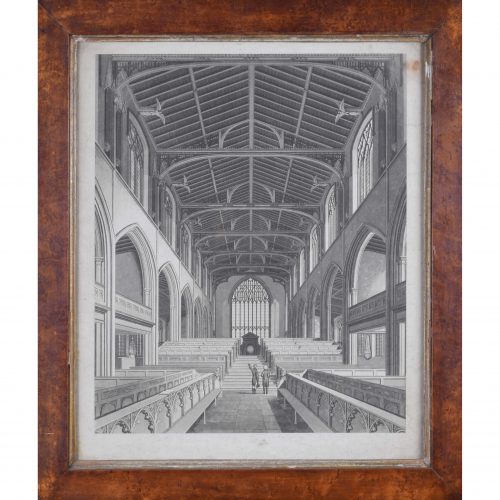
Chapel Interior (circa 1800)
Engraving 49 x 40 cm An engraving of a magnificent chapel interior. Two men tour the chapel, one gesticulating towards the spectacular design of the chancel window. Condition: good. Some gentle discolouration; in faux burr-maple frame. If you’d like to know more, please email info@manningfineart.co.uk or call us on 07929 749056. -
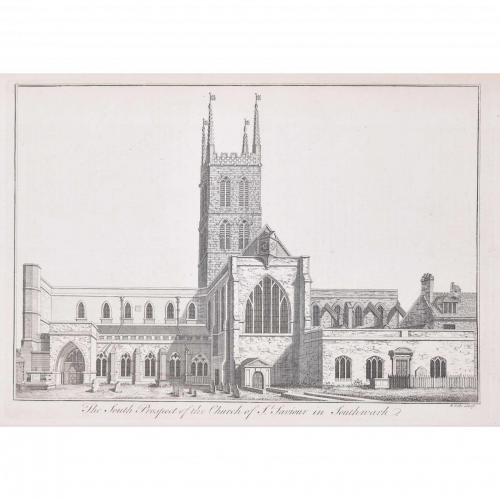
Benjamin Cole (1697-1783)
Southwark Cathedral (c. 1753)
Engraving 24 x 33 cm Stow's Survey of London, a ward-by-ward topographical and historical tour of the City of London giving an account of buildings, social conditions and customs, was first published in 1598. This view of Southwark Cathedral, labelled here as 'the South Prospect of the Church of St Saviour in Southwark', offers a charming perspective of the building's architecture and churchyard. Condition: Generally very good; slight offsetting from facing page and old library stamp to reverse. -
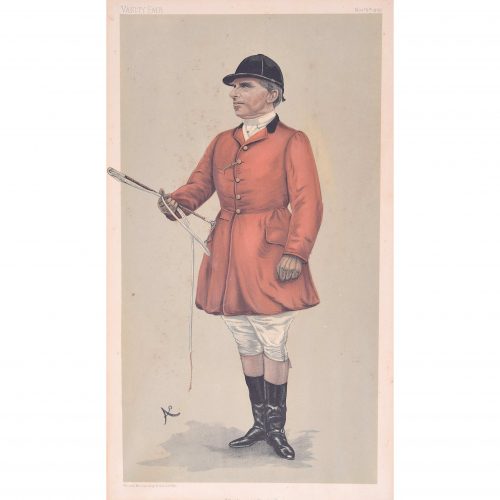
Roland "Ao" / "Armadillo" L'Estrange for Vanity Fair Magazine 'Berks and Bucks': Sir Robert Rodney Wilmot
5 November 1903 Lithograph 21 x 37 cm Depicting Sir Robert Rodney Wilmot, in red hunting clothes and whip, of the Berks & Bucks Draghounds at their opening meet. Wilmot was educated at Eton and Oxford, and his hobbies famously included croquet. The Vanity Fair magazine of 1868 to 1914 was subtitled 'A Weekly Show of Political, Social and Literary Wares'. Founded by Thomas Gibson Bowles, who aimed to expose the contemporary vanities of Victorian society, it featured regular full-page, colour lithographs of famous (or infamous) contemporary figures. It is for these caricatures that the original Vanity Fair is best known today. If you are interested, please email info@manningfineart.co.uk or call us on 07929 749056. Condition: Good. Mounted to board, some age toning. -
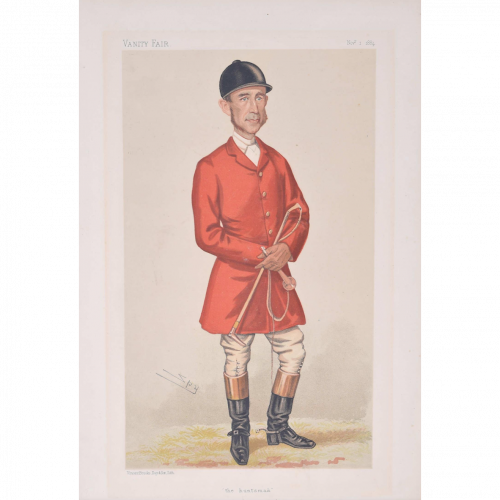
Sir Leslie "Spy" Ward for Vanity Fair Magazine 'The Huntsman': Thomas Firr
1 November 1884 Lithograph 21 x 37 cm Depicting Thomas Firr, Huntsman of the Quorn, on the day of the season's opening meet. The illustrated volume 'Tom Firr of the Quorn: Huntsman Extraordinary' details Firr's days with the hunt, and considers him 'the greatest huntsman in England'. He was huntsman to the Quorn for 27 years from 1872 to 1899. The Quorn Hunt has a claim to be the oldest hunt in the country, having been founded in 1696 by Mr Thomas Boothby of Tooley Park, Leicestershire. Tooley Park lies about eight miles southwest of Leicester, just to the north of the Hinckley road. The hunt takes its name from the village of Quorn, where the hounds were kennelled from 1753 to 1904. If you are interested, please email info@manningfineart.co.uk or call us on 07929 749056. Condition: Good. Mounted to board, some age toning. -
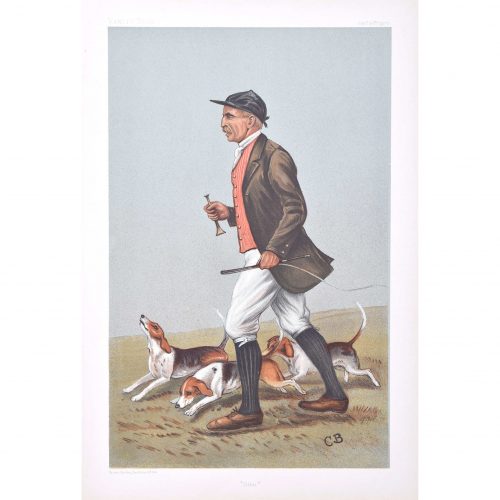
Cuthbert "CB" Bradley for Vanity Fair Magazine 'Otho': Otho Paget
30 January 1902 Lithograph 21 x 37 cm CB's cartoon depicts John Otho Paget, noted beagler and author of 'Beagles and Beagling'. Cuthbert Bradley was also a sporting man - he famously authored 'Fox-Hunting from Shire to Shire with Many Noted Packs' and worked as a sporting journalist for The Field. As well as illustrating for Vanity Fair, he painted polo and foxhunting scenes, and other pictures of equestrian interest. The majority of his Vanity Fair cartoons are of hunting men. The Vanity Fair magazine of 1868 to 1914 was subtitled 'A Weekly Show of Political, Social and Literary Wares'. Founded by Thomas Gibson Bowles, who aimed to expose the contemporary vanities of Victorian society, it featured regular full-page, colour lithographs of famous (or infamous) contemporary figures. It is for these caricatures that the original Vanity Fair is best known today. If you are interested, please email info@manningfineart.co.uk or call us on 07929 749056. Condition: Generally very good. -
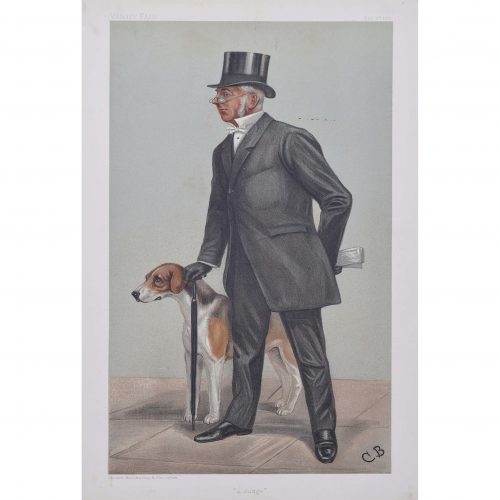
Cuthbert "CB" Bradley for Vanity Fair Magazine 'A Judge': The Rev Cecil Legard
11 July 1901 Lithograph 21 x 37 cm CB's cartoon depicts The Rev Cecil Legard (1843-1918), the Rector of Cottesbrooke and heir to the baronetcy. As well as a clergyman, Legard was a noted sportsman and hound expert; he was a steeplechase rider, and also edited the Foxhound Kennel Stud Book. CB depicts him judging hounds, excellently outfitted; as the biography on the reverse of the mounted lithograph notes, he might be 'the best judge of a foxhound in England'. A copy of the cartoon is held by the Kingston Lacy Estate in Dorset. Cuthbert Bradley was also a sporting man - he famously authored 'Fox-Hunting from Shire to Shire with Many Noted Packs' and worked as a sporting journalist for The Field. As well as illustrating for Vanity Fair, he painted polo and foxhunting scenes, and other pictures of equestrian interest. The majority of his Vanity Fair cartoons are of hunting men. The Vanity Fair magazine of 1868 to 1914 was subtitled 'A Weekly Show of Political, Social and Literary Wares'. Founded by Thomas Gibson Bowles, who aimed to expose the contemporary vanities of Victorian society, it featured regular full-page, colour lithographs of famous (or infamous) contemporary figures. It is for these caricatures that the original Vanity Fair is best known today. If you are interested, please email info@manningfineart.co.uk or call us on 07929 749056. Condition: Generally very good. -
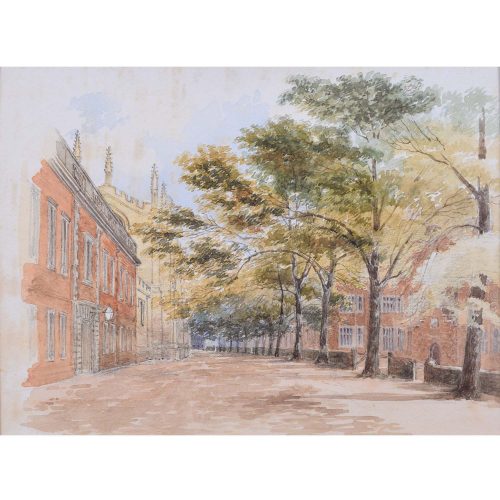
Anonymous Eton College
Watercolour 21.2×28.5cm If you are interested email info@manningfineart.co.ukor call us on 07929 749056. Condition: Good. -

Sutton Nichols (1668 - 1729)
Map of Cambridgeshire
Engraving 43 x 36 cm Signed in plate lower left. A beautifully coloured 18th century map engraving of Cambridgeshire. The map was produced by Robert Morden for publication in Edward Gibson's 1695 translation of William Camden's Britannia, a topographical and historical survey of Great Britain and Ireland produced to "restore antiquity to Britaine, and Britain to his antiquity" - a most noble aim. William Camden (1551 - 1623) was an English antiquarian, historian, topographer, and herald, best known as the author of Britannia, the first chorographical survey of the islands of Great Britain and Ireland, and the Annales, the first detailed historical account of the Queen Elizabeth I's reign. Sutton Nicholls was a draughtsman and engraver best known for his panoramic views of the cities of London and Westminster. Almost all of his engravings were commissioned by publishers. Nicholls specialised in topographical and architectural designs; he also produced many maps, notably illustrating John Strype’s edition of John Stowe’s ‘Survey of London’ in 1720. Condition: good. Mounted to board. If you’d like to know more, please email info@manningfineart.co.uk or call us on 07929 749056. -
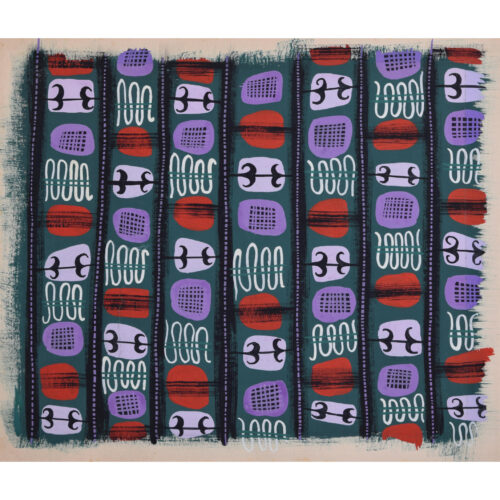
Raymond Weston
Fabric design
Gouache 32 x 37 cm Label to reverse. A fabric design for a dress, produced by a student at the Loughborough College of Art. The colours and forms suggest a mid-century design; the label to the reverse indicates that it would have been machine printed on silk, to be made into a dress. Condition: generally very good. If you are interested, please email info@manningfineart.co.uk or call us on 07929 749056. -

William Kip (active 1598 - 1610) after Christopher Saxton (1540 - 1610)
Map of Cambridgeshire (1637)
Engraving with later hand colouring 29 x 32 cm An antique map of Cambridgeshire. The map was originally published in William Camden's atlas 'Britannia', which was first published in 1586. William Kip was a goldsmith and map engraver. He was born in Utrecht in the Netherlands and moved to London to pursue his career as an engraver. Alongside William Hole, Kip re-engraved Christopher Saxton's 1574 county maps for publication in Camden's 'Britannia', and it is this venture for which he is most well-known. Christopher Saxton was an English cartographer who produced the first county maps of England and Wales. Between 1574 and 1578 he engraved maps of every county in Britain, and compiled them into an atlas in 1579. These maps bore Queen Elizabeth I's arms as well as those of Saxton's patron, Thomas Seckford. Condition: generally good; faint evidence of old staining. If you are interested, please email info@manningfineart.co.uk or call us on 07929 749056. Click here for more maps and general pictures of Cambridge. -
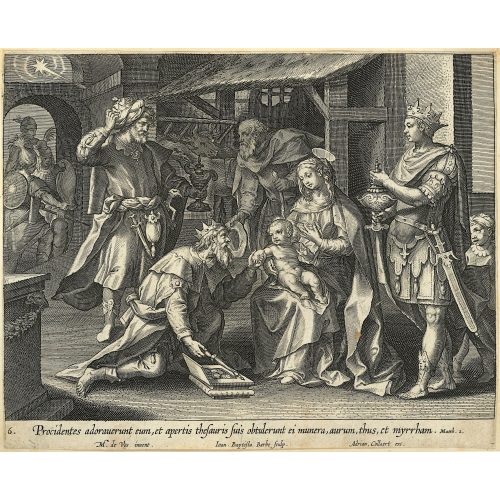
Jean Baptist Barbé (1578?-1649) Adriaen Collaert (c. 1560-1618) after Maerten de Vos (1532 - 1603) 6. "Procidentes adoravuerunt eum, et apertis thesauris suis obtulerunt ei munera, aurum, thus, et myrrham" - Matth 2
Engraving From Vita, Passio, et Resurrectio Iesu Christi first published 1598, this a later edition published by Joannes Galle (1600-1676) 16.5x21.8cm From the Gospel of Matthew, Chapter 2 Verse 11 - and fell down and worshipped him: and when they had opened their treasures, they presented unto him gifts; gold, and frankincense and myrrh. The star hangs over the stable door, as the three Magi present their treasures to Our Lord, sitting upon Mary's knee, St Joseph in attendance behind. Adriaen Collaert was born in Antwerp between 1555 and 1565, becoming wijnmeester of the Guild of St Luke in 1580 - a title reserved for the sons of guild members. The guild of St Luke was generally the city guild for artists. Working for Philip Galle, a Dutch publisher best known for his old master prints, he married Galle's daughter Justa. After learning the principles of engraving in the Netherlands, he spent some years in Italy improving his skill. Upon returning to Flanders he engraved, in accomplished fashion, a great number of plates. His brother, Jan Collaert II, his son, Jan Baptist Collaert II and a grandson were all printmakers. These particular plates are after paintings by Maerten de Vos, a Flemish painter and draughtsman. His father was Pieter de Vos, from whom he learned. From 1550 - 1558 he travelled in Italy, visiting Rome and Venice and becoming master of the Antwerp Guild of St Luke upon his return in 1558. After 1575 he was mainly engaged in producing print designs. If you are interested email info@manningfineart.co.uk or call us on 07929 749056. Condition: Trimmed to plate margins, generally good condition commensurate with age, slight age toning and handling marks as evident from image. -
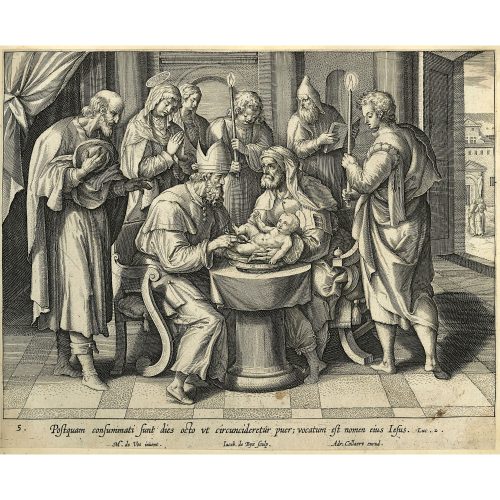
Adriaen Collaert (c. 1560-1618) after Maerten de Vos (1532 - 1603) 5. "Postquam consummati sunt dies octo ut circuncideretur puer; vocatum est nomen eius Iesus" - Luke 2
Engraving, From Vita, Passio, et Resurrectio Iesu Christi first published 1598, this a later edition published by Joannes Galle (1600-1676) 16.5x21.8cm From the Gospel of Luke, Chapter 2 Verse 21 - And when eight days were accomplished for the circumcising of the child, his name was called Jesus. Adriaen Collaert was born in Antwerp between 1555 and 1565, becoming wijnmeester of the Guild of St Luke in 1580 - a title reserved for the sons of guild members. The guild of St Luke was generally the city guild for artists. Working for Philip Galle, a Dutch publisher best known for his old master prints, he married Galle's daughter Justa. After learning the principles of engraving in the Netherlands, he spent some years in Italy improving his skill. Upon returning to Flanders he engraved, in accomplished fashion, a great number of plates. His brother, Jan Collaert II, his son, Jan Baptist Collaert II and a grandson were all printmakers. These particular plates are after paintings by Maerten de Vos, a Flemish painter and draughtsman. His father was Pieter de Vos, from whom he learned. From 1550 - 1558 he travelled in Italy, visiting Rome and Venice and becoming master of the Antwerp Guild of St Luke upon his return in 1558. After 1575 he was mainly engaged in producing print designs. If you are interested email info@manningfineart.co.uk or call us on 07929 749056. Condition: Trimmed to plate margins, generally good condition commensurate with age, slight age toning and handling marks as evident from image. -
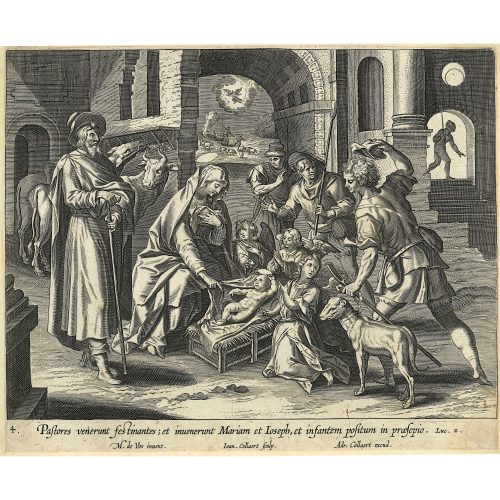
Adriaen Collaert (c. 1560-1618) after Maerten de Vos (1532 - 1603) "Pastores venerunt festinantes; et inuenerunt Mariam et Ioseph, et infantem positum in praesepio" - Luke 2
Engraving, From Vita, Passio, et Resurrectio Iesu Christi first published 1598, this a later edition published by Joannes Galle (1600-1676) 16.5x21.8cm From the Gospel of Luke, Chapter 2 Verse 16 - And the shepherds came with haste, and found Mary, and Joseph, and the babe lying in a manger. Adriaen Collaert was born in Antwerp between 1555 and 1565, becoming wijnmeester of the Guild of St Luke in 1580 - a title reserved for the sons of guild members. The guild of St Luke was generally the city guild for artists. Working for Philip Galle, a Dutch publisher best known for his old master prints, he married Galle's daughter Justa. After learning the principles of engraving in the Netherlands, he spent some years in Italy improving his skill. Upon returning to Flanders he engraved, in accomplished fashion, a great number of plates. His brother, Jan Collaert II, his son, Jan Baptist Collaert II and a grandson were all printmakers. These particular plates are after paintings by Maerten de Vos, a Flemish painter and draughtsman. His father was Pieter de Vos, from whom he learned. From 1550 - 1558 he travelled in Italy, visiting Rome and Venice and becoming master of the Antwerp Guild of St Luke upon his return in 1558. After 1575 he was mainly engaged in producing print designs. If you are interested email info@manningfineart.co.uk or call us on 07929 749056. Condition: Trimmed to plate margins, generally good condition commensurate with age, slight age toning and handling marks as evident from image. -
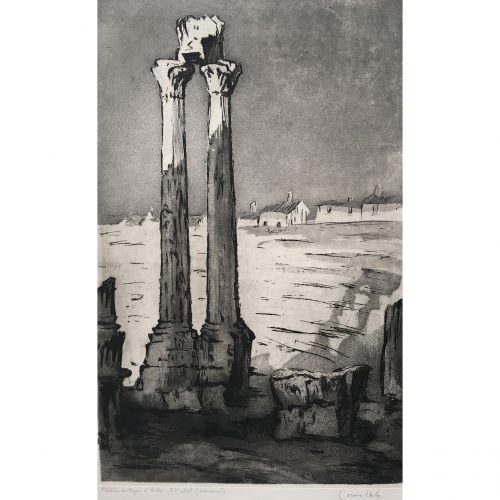
Louise Ibels (1891-1965) 'Théâtre Antique à Arles'
Etching and aquatint Signed and titled in pencil to margin 3rd state proof Approx. 39 x 25cm (plate) A French artist known for her charming etchings, here she captures the romance of the Roman Theatre in Arles. Built at the time of Augustus (27BC-14AD) it had seating for 8,000 across thirty-three tiers of steps. During the early Middle Ages it was plundered for its stone to build the town walls. These days the only part of the rear wall of the stage that survives are the two columns depicted in the print. Re-emphasised by the presence of their shadow, the rest of the view disappears softly into the distant background. If you are interested email info@manningfineart.co.uk or call us on 07929 749056. Condition: Excellent. -
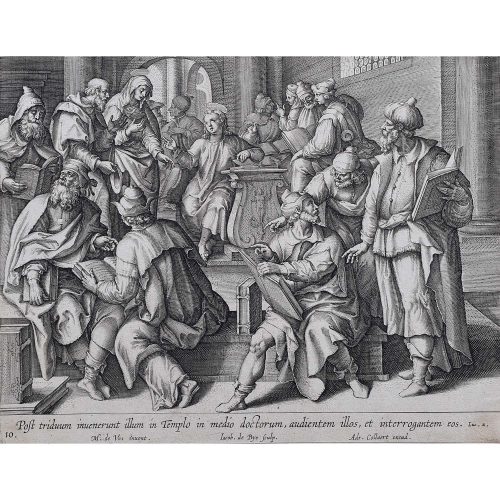
Jean Baptist Barbé (1578?-1649) Adriaen Collaert (c. 1560-1618) after Maerten de Vos (1532 - 1603) 10. Post triduum invenerunt illum in templo in medio doctorum, audientem illos, et interrogante eos. Luc. 2
Engraving From Vita, Passio, et Resurrectio Iesu Christi first published 1598, this a later edition published by Joannes Galle (1600-1676) 16.5x21.8cm From the Gospel of Luke, Chapter 2 After three days they found him in the temple among the doctors, listening to them and asking them questions. Adriaen Collaert was born in Antwerp between 1555 and 1565, becoming wijnmeester of the Guild of St Luke in 1580 - a title reserved for the sons of guild members. The guild of St Luke was generally the city guild for artists. Working for Philip Galle, a Dutch publisher best known for his old master prints, he married Galle's daughter Justa. After learning the principles of engraving in the Netherlands, he spent some years in Italy improving his skill. Upon returning to Flanders he engraved, in accomplished fashion, a great number of plates. His brother, Jan Collaert II, his son, Jan Baptist Collaert II and a grandson were all printmakers. These particular plates are after paintings by Maerten de Vos, a Flemish painter and draughtsman. His father was Pieter de Vos, from whom he learned. From 1550 - 1558 he travelled in Italy, visiting Rome and Venice and becoming master of the Antwerp Guild of St Luke upon his return in 1558. After 1575 he was mainly engaged in producing print designs. If you are interested email info@manningfineart.co.uk or call us on 07929 749056. Condition: Trimmed to plate margins, generally good condition commensurate with age, slight age toning and handling marks as evident from image. -
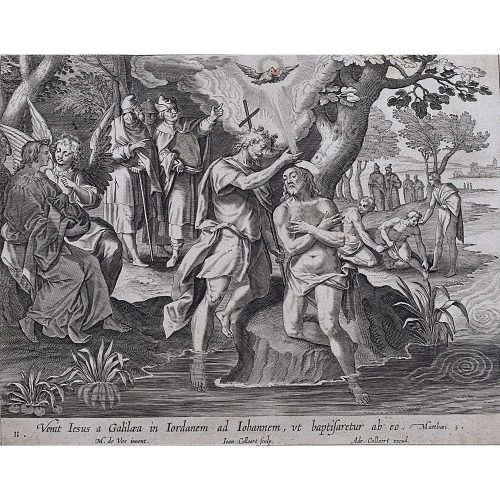
Jean Baptist Barbé (1578?-1649) Adriaen Collaert (c. 1560-1618) after Maerten de Vos (1532 - 1603) 11. Verit Iesus a Galilaea in Iordanem ad Iohannem, vt baptifartur ab eo. Matthew. 3.
Engraving From Vita, Passio, et Resurrectio Iesu Christi first published 1598, this a later edition published by Joannes Galle (1600-1676) 16.5x21.8cm From the Gospel of Matthew, chapter 3 "Then Jesus came from Galilee to the Jordan to be baptized by John." Adriaen Collaert was born in Antwerp between 1555 and 1565, becoming wijnmeester of the Guild of St Luke in 1580 - a title reserved for the sons of guild members. The guild of St Luke was generally the city guild for artists. Working for Philip Galle, a Dutch publisher best known for his old master prints, he married Galle's daughter Justa. After learning the principles of engraving in the Netherlands, he spent some years in Italy improving his skill. Upon returning to Flanders he engraved, in accomplished fashion, a great number of plates. His brother, Jan Collaert II, his son, Jan Baptist Collaert II and a grandson were all printmakers. These particular plates are after paintings by Maerten de Vos, a Flemish painter and draughtsman. His father was Pieter de Vos, from whom he learned. From 1550 - 1558 he travelled in Italy, visiting Rome and Venice and becoming master of the Antwerp Guild of St Luke upon his return in 1558. After 1575 he was mainly engaged in producing print designs. If you are interested email info@manningfineart.co.uk or call us on 07929 749056. Condition: Trimmed to plate margins, generally good condition commensurate with age, slight age toning and handling marks as evident from image. -
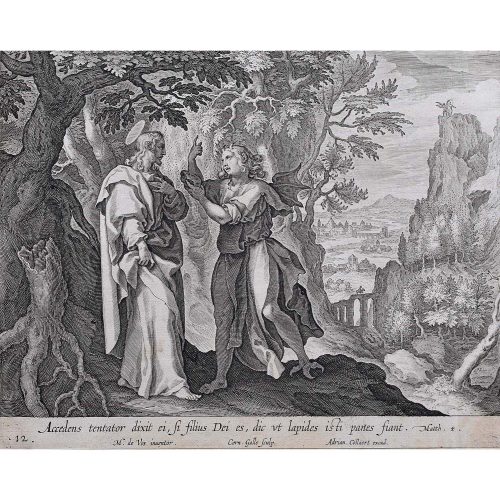
Jean Baptist Barbé (1578?-1649) Adriaen Collaert (c. 1560-1618) after Maerten de Vos (1532 - 1603) 12. Accedens tentator dixit ei fi lius, Dei es, dic vt lapides isti panes fiant. Matt. 4.
Engraving From Vita, Passio, et Resurrectio Iesu Christi first published 1598, this a later edition published by Joannes Galle (1600-1676) 16.5x21.8cm From the Gospel of Matthew, chapter 4 "If thou be the Son of God, command that these stones be made bread" Adriaen Collaert was born in Antwerp between 1555 and 1565, becoming wijnmeester of the Guild of St Luke in 1580 - a title reserved for the sons of guild members. The guild of St Luke was generally the city guild for artists. Working for Philip Galle, a Dutch publisher best known for his old master prints, he married Galle's daughter Justa. After learning the principles of engraving in the Netherlands, he spent some years in Italy improving his skill. Upon returning to Flanders he engraved, in accomplished fashion, a great number of plates. His brother, Jan Collaert II, his son, Jan Baptist Collaert II and a grandson were all printmakers. These particular plates are after paintings by Maerten de Vos, a Flemish painter and draughtsman. His father was Pieter de Vos, from whom he learned. From 1550 - 1558 he travelled in Italy, visiting Rome and Venice and becoming master of the Antwerp Guild of St Luke upon his return in 1558. After 1575 he was mainly engaged in producing print designs. If you are interested email info@manningfineart.co.uk or call us on 07929 749056. Condition: Trimmed to plate margins, generally good condition commensurate with age, slight age toning and handling marks as evident from image. -
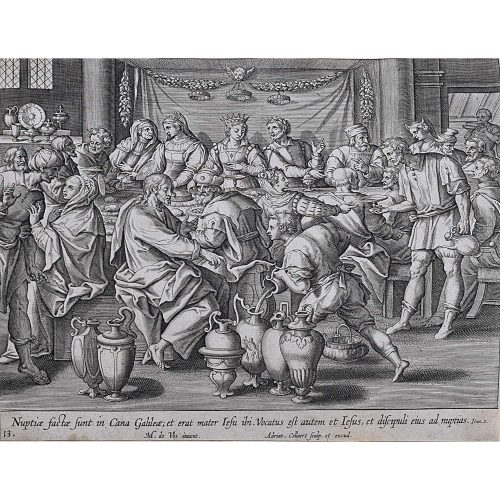
Jean Baptist Barbé (1578?-1649) Adriaen Collaert (c. 1560-1618) after Maerten de Vos (1532 - 1603) 13. nuptia facta sunt in cana galilaeae; et erat mater Iefu ibi. Vocatus eft autem et Iefus, et difcipuli eius ad nuptias. Ioan. 2.
Engraving From Vita, Passio, et Resurrectio Iesu Christi first published 1598, this a later edition published by Joannes Galle (1600-1676) 16.5x21.8cm From the Gospel of John, chapter 2 "On the third day a wedding took place at Cana in Galilee. Jesus’ mother was there, and Jesus and His disciples had also been invited to the wedding. When the wine ran out, Jesus’ mother said to Him, “They have no more wine." Adriaen Collaert was born in Antwerp between 1555 and 1565, becoming wijnmeester of the Guild of St Luke in 1580 - a title reserved for the sons of guild members. The guild of St Luke was generally the city guild for artists. Working for Philip Galle, a Dutch publisher best known for his old master prints, he married Galle's daughter Justa. After learning the principles of engraving in the Netherlands, he spent some years in Italy improving his skill. Upon returning to Flanders he engraved, in accomplished fashion, a great number of plates. His brother, Jan Collaert II, his son, Jan Baptist Collaert II and a grandson were all printmakers. These particular plates are after paintings by Maerten de Vos, a Flemish painter and draughtsman. His father was Pieter de Vos, from whom he learned. From 1550 - 1558 he travelled in Italy, visiting Rome and Venice and becoming master of the Antwerp Guild of St Luke upon his return in 1558. After 1575 he was mainly engaged in producing print designs. If you are interested email info@manningfineart.co.uk or call us on 07929 749056. Condition: Trimmed to plate margins, generally good condition commensurate with age, slight age toning and handling marks as evident from image. -
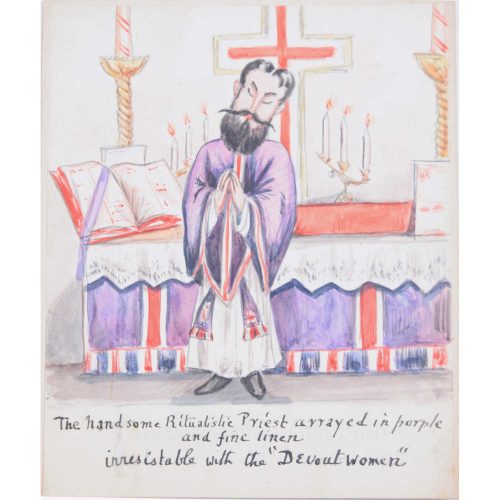
Anonymous, c.1850
'The handsome Ritualistic Priest, arrayed in purple and fine linen irresistible with the "Devout Women"' Caricature
Pen, ink and watercolour 20 x 24 cm By repute this item was found in the rooms of John Keble (1792-1866) at the Hermitage Hotel in Eastbourne after his death in 1866, together with another caricature watercolour of the 'Cotton-ia Worcester-ienisis' which we also have for sale. Condition: Generally very good, slight toning to paper. -
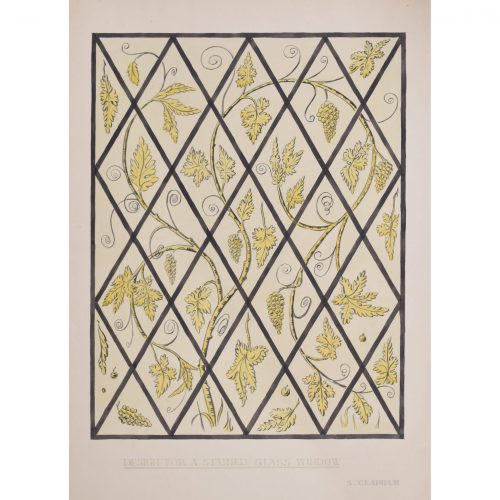
S Clapham (active 1940 - 1960)
Designs for a Stained Glass Window
Watercolour 71 x 56 cm Signed lower right. A beautiful stained glass window design in the medievalist Arts and Crafts style popularised by William Morris in the 1890s. Clapham was an architect based in Stockwell in London. Condition: very good. If you are interested, please email info@manningfineart.co.uk or call us on 07929 749056. Click here for other works by the artist. -
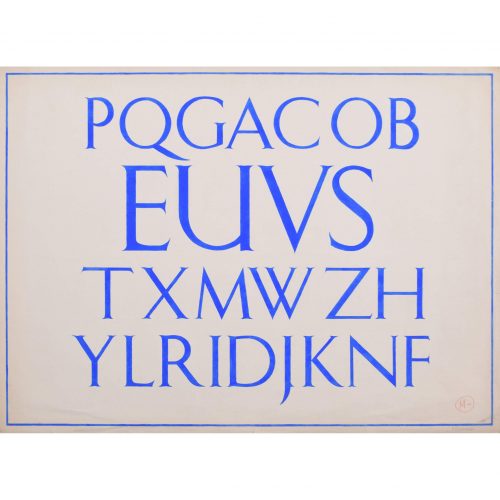
S Clapham (active 1940 - 1960)
Lettering Design
Watercolour 53 x 75 cm Examiner's mark 'M-' (likely 'lower merit') lower right within border. Signed lower right without border in pencil. A trainee architect's lettering design. It was crucial that an architectural draughtsman be skilled in depicting lettering which might appear on a building commission, and here is one of Clapham's stylish efforts, marked by an examiner. Condition: generally good, a few repaired very short edge tears not into image, with examiner's mark to bottom right. If you are interested, please email info@manningfineart.co.uk or call us on 07929 749056. Click here for other works by the artist. -
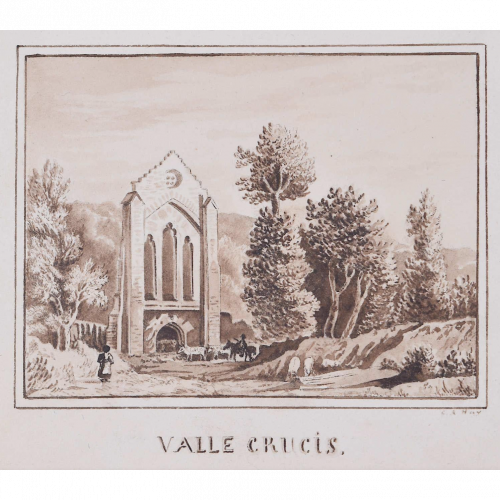
C.A. Hay
Valle Crucis Abbey, Wales (early 19th century)
Pen, ink and monochrome watercolour 8 x 12 cm Valle Crucis is a Cistercian abbey located in Llantysilio in Denbighshire, Wales. The abbey was built in 1201 by Madog ap Gruffydd Maelor, Prince of Powys Fadog. In 1537, at the height of Henry VIII's Dissolution of the Monasteries, Valle Crucis was dissolved and fell into disrepair. The abbey is now a ruin, though large parts of the original structure still survive. We also have in stock an en-suite watercolour of the nearby Llangollen Bridge; it is likely that some of the abbey's stone was used to build the bridge after the abbey had been dissolved. Condition: Generally very good. Signed lower right. -
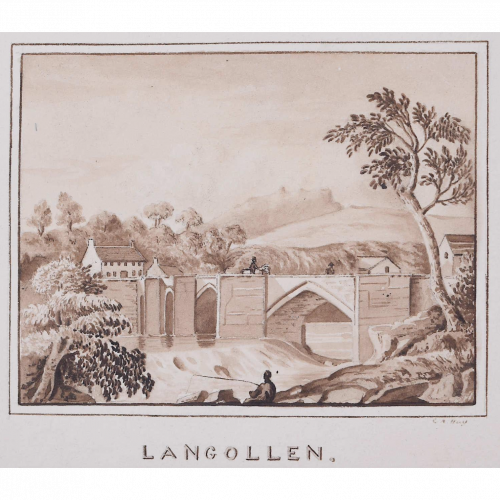
C.A. Hay
Llangollen Bridge, Wales (early 19th century)
Pen, ink and monochrome watercolour 8 x 12 cm Llangollen Bridge is built across the River Dee at the North end of the high street of Llangollen in the county of Denbigshire in Wales. The Bridge is listed as one of the seven wonders of Wales and is Grade I listed. There has been a bridge across the Dee at Llangollen since at least 1284. Some historians believe that the bridge was constructed in the 1540s; there is evidence of sepulchral slabs within the bridge's masonry, indicating that it was rebuilt following the dissolution of Henry VIII's dissolution of the monasteries. We also have in stock an en-suite watercolour of the nearby Valle Crucis abbey, from which some of the bridge's stone might have been taken. Condition: Generally very good. Signed lower right. -

Sir Hugh Casson (1910-1999)
The Chapel at Radley College
Lithographic print signed in pencil and numbered 18/250. Provenance: the artist’s estate. 28 x 35 cm (11 x 14 in) If you are interested email info@manningfineart.co.uk or call us on 07929 749056. For biographical details and other works by the artist click here. -

Sir Hugh Casson (1910-1999)
The Chapel at Radley College
Lithographic print signed in pencil. Proof print aside from series. Provenance: the artist’s estate. 28 x 35 cm (11 x 14 in) If you are interested email info@manningfineart.co.uk or call us on 07929 749056. For biographical details and other works by the artist click here. -
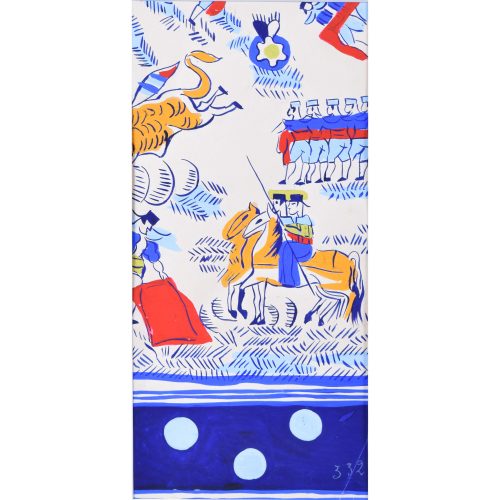
Robert Bonfils (French: 1886-1972)
Designs for scarf for Bianchini Ferrier Bull Fighting 31x15cm Gouache and pencil Provenance: Christies, 25-27 July 2001 Bianchini Textiles sale Born in Paris, Bonfils spent between 1903-1909 at various Parisian art schools: the École Germain Pilon, the École Nationale Supérieure des Arts Décoratifs (where he subsequently taught for thirty-two years), and the École des Beaux Arts. From 1909 he exhibited regularly at the Salon d'Automne, by 1912 he was exhibiting at Salon des Artistes Décorateurs and then subsequently at Tuileries and abroad. He was an organiser of the 1925 Paris International Exposition of Modern Industrial and Decorative Arts, and the 1937 Exposition. His relationship with Bianchini commenced in 1915 who produced many of his textile designs. He was made Chevalier de la Légion d'honneur in 1926, being promoted to Officier in 1938. -
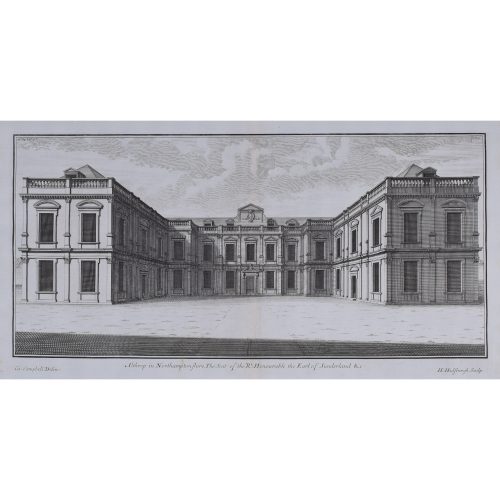
Colen Campbell (1676-1729)
Althrop Hall in Northamptonshire the Seat of the Rt Honourable The Earl of Sunderland & co.
35x50cm Engraving (1715-1725) from 'Vitruvius Britannicus, or the British Architect...' Althorp Hall - as it is now written, but still pronounced 'Althrop' - is the seat of the Earl Spencer and the location of the grave of Diana, Princess of Wales. Colen Campbell was a Scottish architect and architectural writer, renowned for being a founder of the Georgian style. His major published work was 'Vitruvius Britannicus' which was a catalogue of design, containing a series of engravings of English buildings by Inigo Jones, Sir Christopher Wren, Campbell himself and other prominent architects of the era. It was published in three volumes between 1715 and 1725. -
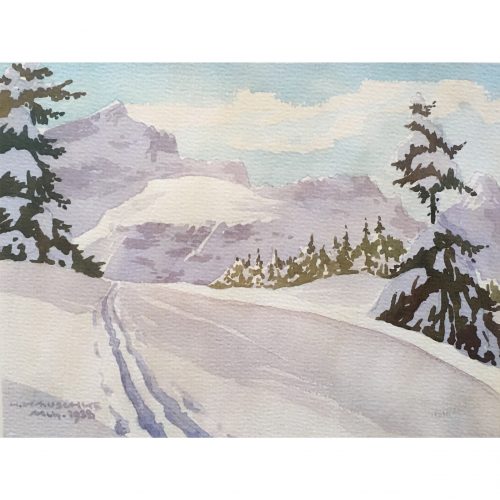
Hermann Kauschke Alpspitze, Zugspitze und Waxenstein (1938)
Watercolour 14.5 x 19.5 cm Inscribed "Alpspitze, Zugspitze u. Waxenstein - original Aquarell". Signed and dated. A beautiful snowy scene depicting three Bavarian mountains: the Alpspitze, Zugspitze, and Waxenstein. Kauschke's view emphasises the wintry quietude of the snow-covered trees and mountains. The winter sun reflects on the freshly fallen snow, and a pair of ski tracks disappear into the distance. If you are interested, please email info@manningfineart.co.uk or call us on 07929 749056. Condition: excellent. -
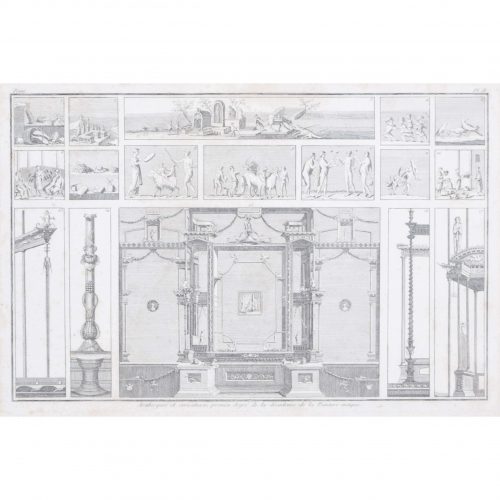
Arabesques and caricatures
Engraving 24.5 x 36 cm Condition: good. If you’d like to know more, please email info@manningfineart.co.uk or call us on 07929 749056. -
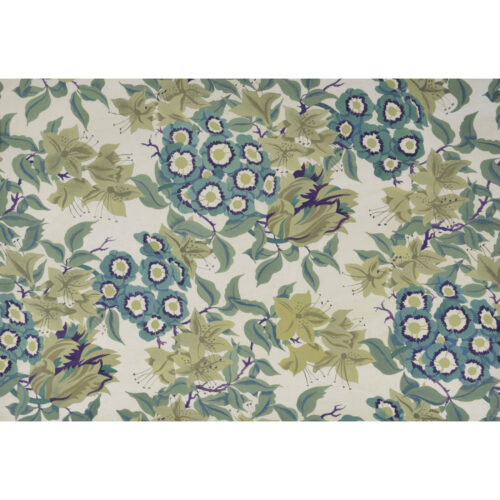
Glasgow School of Art
Wallpaper design
Gouache 33 x 48 cm An Arts and Crafts wallpaper design in the style popularised by William Morris, featuring pansies and lilies in shades of green, blue, and purple. Condition: generally very good; a few very faint spots. If you are interested, please email info@manningfineart.co.uk or call us on 07929 749056. -
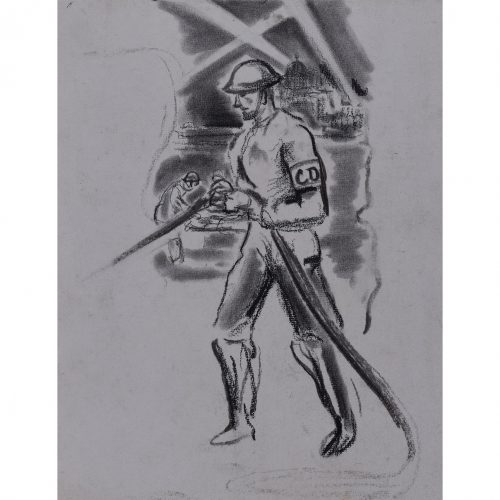
The Blitz: A Civil Defence Firefighter In Action before St Paul's Cathedral with Search Lights and Stretcher Bearers
Charcoal c. 1940 30x24cm A World War II Civil Defence firefighter, with 'CD' armband operates a fire hose as stretcher bearers work behind him, St Paul's cathedral being illuminated by searchlights. A typical night-time scene from London during the 1940 Blitz. If you are interested email info@manningfineart.co.uk or call us on 07929 749056. -
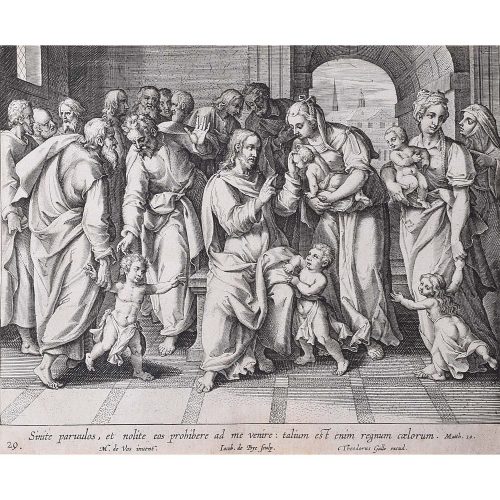
Theodoor Galle (1571 – 1633), Iacob de Bye (1581-1640) after Maerten de Vos (1532 - 1603) 29. Sinite paruulos, et nolite eos prohibere ad me venire : talium est enim reguum coelorum. 19.
Engraving From Vita, Passio, et Resurrectio Iesu Christi first published 1598, this a later edition published by Joannes Galle (1600-1676) 16.5x21.8cm Hand-finished wooden frame included (UK shipping only) From the Gospel of Matthew, chapter 19 "Suffer the little children, and forbid them not, to come unto me: for of such is the kingdom of heaven." Theodoor Galle was the son of Philip Galle, a Dutch publisher best known for his old master prints, from whom he learnt the craft. Theodoor married a daughter of the prominent family of Plantin in Antwerp. His marriage established the productive partnership between the Galle workshop and the Plantin Moretus printing house. A talented workman, Galle quickly became a respected engraver, print publisher and a member of the guild of St Luke, a city guild for artists in 1595. In the years to follow he became the guild's deacon. These particular plates are after paintings by Maerten de Vos, a Flemish painter and draughtsman. His father was Pieter de Vos, from whom he learned. From 1550 - 1558 he travelled in Italy, visiting Rome and Venice and becoming master of the Antwerp Guild of St Luke upon his return in 1558. After 1575 he was mainly engaged in producing print designs. If you are interested email info@manningfineart.co.uk or call us on 07929 749056. Condition: Trimmed to plate margins, generally good condition commensurate with age, slight age toning and handling marks as evident from image. -
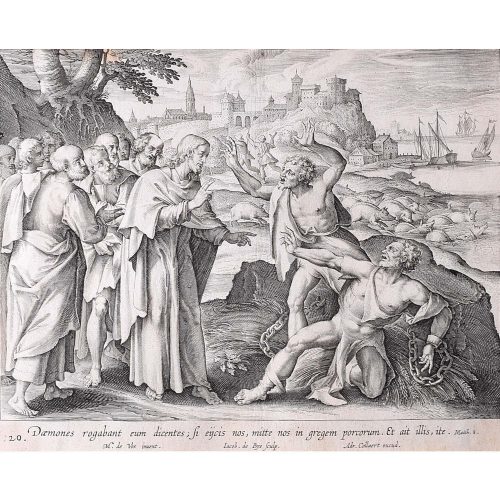
Adriaen Collaert (c. 1560-1618) Jacob de Bye (1581-1640) after Maerten de Vos (1532 - 1603) 20. Daemones rogabant eum dicentes ; si eijcis nos, mitte nos in gregem porcorum. Et ait illis, ite. Matth. 8.
Engraving From Vita, Passio, et Resurrectio Iesu Christi first published 1598, this a later edition published by Joannes Galle (1600-1676) 16.5x21.8cm Hand-finished black frame included (UK shipping only) From the Gospel of Matthew, chapter 8 "The demons begged Jesus, “If you drive us out, send us into the herd. He said to them, “Go!" Adriaen Collaert was born in Antwerp between 1555 and 1565, becoming wijnmeester of the Guild of St Luke in 1580 - a title reserved for the sons of guild members. The guild of St Luke was generally the city guild for artists. Working for Philip Galle, a Dutch publisher best known for his old master prints, he married Galle's daughter Justa. After learning the principles of engraving in the Netherlands, he spent some years in Italy improving his skill. Upon returning to Flanders he engraved, in accomplished fashion, a great number of plates. His brother, Jan Collaert II, his son, Jan Baptist Collaert II and a grandson were all printmakers. These particular plates are after paintings by Maerten de Vos, a Flemish painter and draughtsman. His father was Pieter de Vos, from whom he learned. From 1550 - 1558 he travelled in Italy, visiting Rome and Venice and becoming master of the Antwerp Guild of St Luke upon his return in 1558. After 1575 he was mainly engaged in producing print designs. If you are interested email info@manningfineart.co.uk or call us on 07929 749056. Condition: Trimmed to plate margins, generally good condition commensurate with age, slight age toning and handling marks as evident from image. -
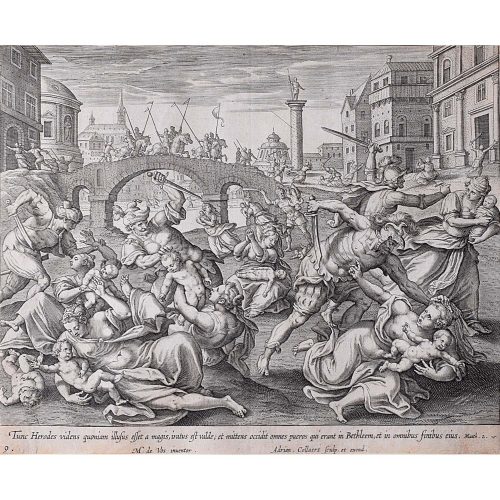
Adriaen Collaert (c. 1560-1618) Jacob de Bye (1581-1640) after Maerten de Vos (1532 - 1603) 9. Tunc Herodes videns quonium illusus esset a magis, iratus est valde; et mittens occidit omnes pueros qui erant in Bethleem, et in omnibus finibus eius Matth. 2.
Engraving From Vita, Passio, et Resurrectio Iesu Christi first published 1598, this a later edition published by Joannes Galle (1600-1676) 16.5x21.8cm Hand-finished black frame included (UK shipping only) From the Gospel of Matthew, chapter 2 "Then Herod, when he saw that he was mocked of the Wise-men, was exceeding wroth, and sent forth, and slew all the male children that were in Bethlehem, and in all the borders thereof". Adrian Collaert was born in Antwerp between 1555 and 1565, becoming wijnmeester of the Guild of St Luke in 1580 - a title reserved for the sons of guild members. The guild of St Luke was generally the city guild for artists. Working for Philip Galle, a Dutch publisher best known for his old master prints, he married Galle's daughter Justa. After learning the principles of engraving in the Netherlands, he spent some years in Italy improving his skill. Upon returning to Flanders he engraved, in accomplished fashion, a great number of plates. His brother, Jan Collaert II, his son, Jan Baptist Collaert II and a grandson were all printmakers. These particular plates are after paintings by Maerten de Vos, a Flemish painter and draughtsman. His father was Pieter de Vos, from whom he learned. From 1550 - 1558 he travelled in Italy, visiting Rome and Venice and becoming master of the Antwerp Guild of St Luke upon his return in 1558. After 1575 he was mainly engaged in producing print designs. If you are interested email info@manningfineart.co.uk or call us on 07929 749056. Condition: Trimmed to plate margins, generally good condition commensurate with age, slight age toning and handling marks as evident from image. -
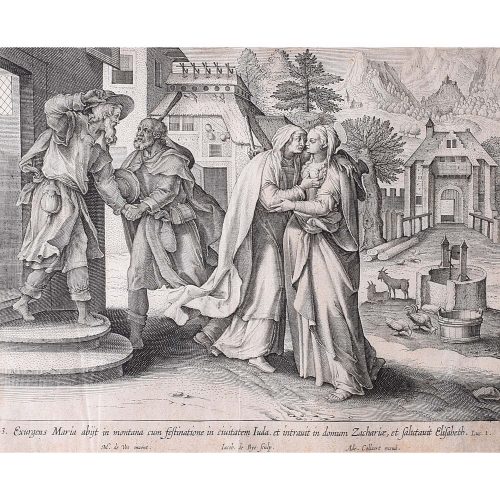
Adriaen Collaert (c. 1560-1618) Jacob de Bye (1581-1640) after Maerten de Vos (1532 - 1603) 3. Exurgens maria abjit in montana cum festinatione in ciuitatem Iuda et intrauit in domum Zacharie, et salutauit Elisabeth . Luc 1.
Engraving From Vita, Passio, et Resurrectio Iesu Christi first published 1598, this a later edition published by Joannes Galle (1600-1676) 17.5x22cm Hand-finished black frame included (UK shipping only) From the Gospel of Luke, chapter 1 "And Mary arose in those days, and went into the hill country with haste, into a city of Juda. And entered into the house of Zacharias, and saluted Elizabeth". Adrian Collaert was born in Antwerp between 1555 and 1565, becoming wijnmeester of the Guild of St Luke in 1580 - a title reserved for the sons of guild members. The guild of St Luke was generally the city guild for artists. Working for Philip Galle, a Dutch publisher best known for his old master prints, he married Galle's daughter Justa. After learning the principles of engraving in the Netherlands, he spent some years in Italy improving his skill. Upon returning to Flanders he engraved, in accomplished fashion, a great number of plates. His brother, Jan Collaert II, his son, Jan Baptist Collaert II and a grandson were all printmakers. These particular plates are after paintings by Maerten de Vos, a Flemish painter and draughtsman. His father was Pieter de Vos, from whom he learned. From 1550 - 1558 he travelled in Italy, visiting Rome and Venice and becoming master of the Antwerp Guild of St Luke upon his return in 1558. After 1575 he was mainly engaged in producing print designs. If you are interested email info@manningfineart.co.uk or call us on 07929 749056. Condition: Trimmed to plate margins, generally good condition commensurate with age, slight age toning and handling marks as evident from image. -
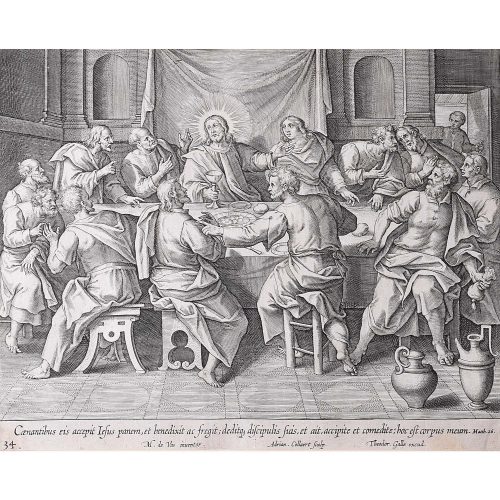
Adriaen Collaert (c. 1560-1618) Jacob de Bye (1581-1640) after Maerten de Vos (1532 - 1603) 34. Coenantibus eis accepit Iesus panem, et benedixit et fregit; deditq discipulis suis, et ait, accipite et comedite; hoc est corpus muem. Matth 16.
Engraving From Vita, Passio, et Resurrectio Iesu Christi first published 1598, this a later edition published by Joannes Galle (1600-1676) 17.5x22cm Hand-finished black frame included (UK shipping only) From the Gospel of Matthew, chapter 16 "And as they were eating, Jesus took bread, and blessed it, and brake it, and gave it to the disciples, and said, Take, eat; this is my body". Theodoor Galle was the son of Philip Galle, a Dutch publisher best known for his old master prints, from whom he learnt the craft. Theodoor married a daughter of the prominent family of Plantin in Antwerp. His marriage established the productive partnership between the Galle workshop and the Plantin Moretus printing house. A talented workman, Galle quickly became a respected engraver, print publisher and a member of the guild of St Luke, a city guild for artists in 1595. In the years to follow he became the guild's deacon. Adrian Collaert was born in Antwerp between 1555 and 1565, becoming wijnmeester of the Guild of St Luke in 1580 - a title reserved for the sons of guild members. The guild of St Luke was generally the city guild for artists. Working for Philip Galle, a Dutch publisher best known for his old master prints, he married Galle's daughter Justa. After learning the principles of engraving in the Netherlands, he spent some years in Italy improving his skill. Upon returning to Flanders he engraved, in accomplished fashion, a great number of plates. His brother, Jan Collaert II, his son, Jan Baptist Collaert II and a grandson were all printmakers. These particular plates are after paintings by Maerten de Vos, a Flemish painter and draughtsman. His father was Pieter de Vos, from whom he learned. From 1550 - 1558 he travelled in Italy, visiting Rome and Venice and becoming master of the Antwerp Guild of St Luke upon his return in 1558. After 1575 he was mainly engaged in producing print designs. If you are interested email info@manningfineart.co.uk or call us on 07929 749056. Condition: Trimmed to plate margins, generally good condition commensurate with age, slight age toning and handling marks as evident from image. -
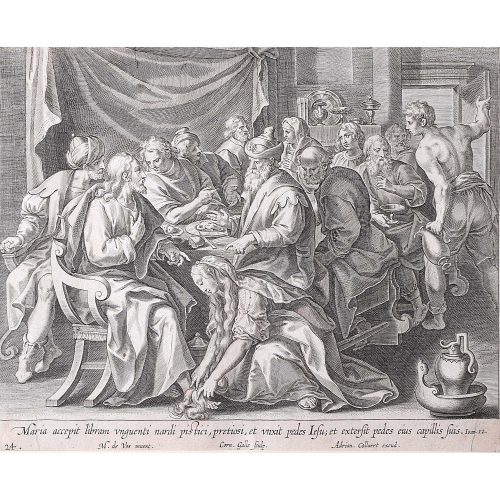
Adriaen Collaert (c. 1560-1618) Cornelius Galle (1576-1650) after Maerten de Vos (1532 - 1603) 24. aria accepit libram unguenti nardi pistici, pretiosti, et vnxit pedes Iefu; et extersit pedes eius capillis suis. John. 12.
Engraving From Vita, Passio, et Resurrectio Iesu Christi first published 1598, this a later edition published by Joannes Galle (1600-1676) 17.5x22cm Hand-finished black frame included (UK shipping only) From the Gospel of John, chapter 12 " Mary therefore took a pound of expensive ointment made from pure nard, and anointed the feet of Jesus and wiped his feet with her hair". Adrian Collaert was born in Antwerp between 1555 and 1565, becoming wijnmeester of the Guild of St Luke in 1580 - a title reserved for the sons of guild members. The guild of St Luke was generally the city guild for artists. Working for Philip Galle, a Dutch publisher best known for his old master prints, he married Galle's daughter Justa. After learning the principles of engraving in the Netherlands, he spent some years in Italy improving his skill. Upon returning to Flanders he engraved, in accomplished fashion, a great number of plates. His brother, Jan Collaert II, his son, Jan Baptist Collaert II and a grandson were all printmakers. These particular plates are after paintings by Maerten de Vos, a Flemish painter and draughtsman. His father was Pieter de Vos, from whom he learned. From 1550 - 1558 he travelled in Italy, visiting Rome and Venice and becoming master of the Antwerp Guild of St Luke upon his return in 1558. After 1575 he was mainly engaged in producing print designs. If you are interested email info@manningfineart.co.uk or call us on 07929 749056. Condition: Trimmed to plate margins, generally good condition commensurate with age, slight age toning and handling marks as evident from image. -
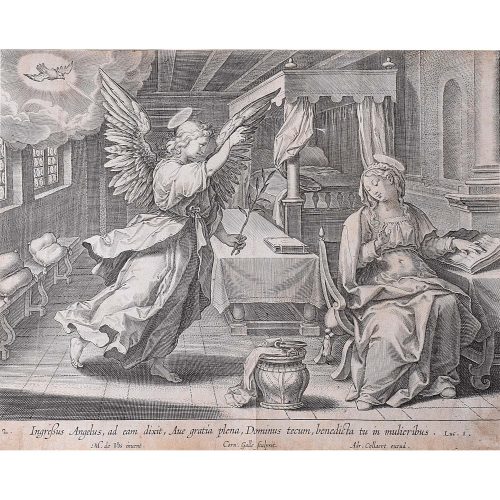
Adriaen Collaert (c. 1560-1618) Cornelius Galle (1576-1650) after Maerten de Vos (1532 - 1603) 2. Ingressus angelus, ad eam dixit, Aue gratia plana, Dominus tecum, benedicta tu in mulieribus. Luke. 1.
Engraving From Vita, Passio, et Resurrectio Iesu Christi first published 1598, this a later edition published by Joannes Galle (1600-1676) 17.5x22cm Hand-finished black frame included (UK shipping only) From the Gospel of Luke, chapter 1 "And the angel came in unto her, and said, Hail, thou that art highly favoured, the lord is with thee". Adrian Collaert was born in Antwerp between 1555 and 1565, becoming wijnmeester of the Guild of St Luke in 1580 - a title reserved for the sons of guild members. The guild of St Luke was generally the city guild for artists. Working for Philip Galle, a Dutch publisher best known for his old master prints, he married Galle's daughter Justa. After learning the principles of engraving in the Netherlands, he spent some years in Italy improving his skill. Upon returning to Flanders he engraved, in accomplished fashion, a great number of plates. His brother, Jan Collaert II, his son, Jan Baptist Collaert II and a grandson were all printmakers. These particular plates are after paintings by Maerten de Vos, a Flemish painter and draughtsman. His father was Pieter de Vos, from whom he learned. From 1550 - 1558 he travelled in Italy, visiting Rome and Venice and becoming master of the Antwerp Guild of St Luke upon his return in 1558. After 1575 he was mainly engaged in producing print designs. If you are interested email info@manningfineart.co.uk or call us on 07929 749056. Condition: Trimmed to plate margins, generally good condition commensurate with age, slight age toning and handling marks as evident from image. -
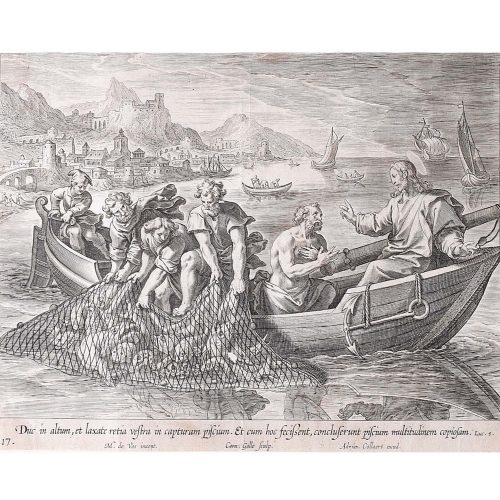
Adriaen Collaert (c. 1560-1618) Cornelius Galle (1576-1650) after Maerten de Vos (1532 - 1603) 17. Duc in altum, et laxate retia vestra in capturam piscium. Et cum hoc fecissent, concluserunt piscium multitudium copiosum. Luke. 5.
Engraving From Vita, Passio, et Resurrectio Iesu Christi first published 1598, this a later edition published by Joannes Galle (1600-1676) 17.5x22cm Hand-finished black frame included (UK shipping only) From the Gospel of Luke, chapter 5 "Put out into the deep and let down your nets for a catch. When they had done this, they enclosed a great quantity of fish". Adrian Collaert was born in Antwerp between 1555 and 1565, becoming wijnmeester of the Guild of St Luke in 1580 - a title reserved for the sons of guild members. The guild of St Luke was generally the city guild for artists. Working for Philip Galle, a Dutch publisher best known for his old master prints, he married Galle's daughter Justa. After learning the principles of engraving in the Netherlands, he spent some years in Italy improving his skill. Upon returning to Flanders he engraved, in accomplished fashion, a great number of plates. His brother, Jan Collaert II, his son, Jan Baptist Collaert II and a grandson were all printmakers. These particular plates are after paintings by Maerten de Vos, a Flemish painter and draughtsman. His father was Pieter de Vos, from whom he learned. From 1550 - 1558 he travelled in Italy, visiting Rome and Venice and becoming master of the Antwerp Guild of St Luke upon his return in 1558. After 1575 he was mainly engaged in producing print designs. If you are interested email info@manningfineart.co.uk or call us on 07929 749056. Condition: Trimmed to plate margins, generally good condition commensurate with age, slight age toning and handling marks as evident from image. -
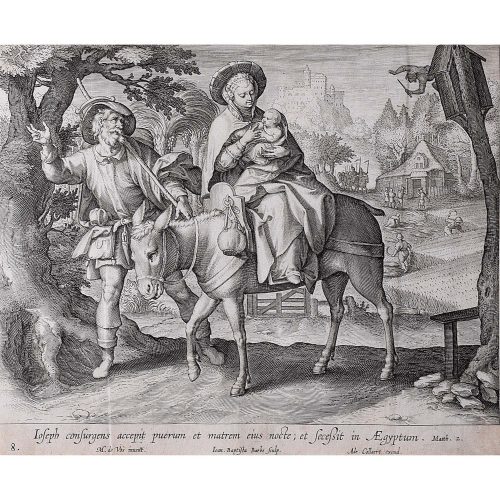
Adriaen Collaert (c. 1560-1618) John de Barbe (1578–1649) after Maerten de Vos (1532 - 1603) 8. Ioseph consurgens accepit puerum et matrem eius nocte; et secessit in Aegyptum. Matth. 2.
Engraving From Vita, Passio, et Resurrectio Iesu Christi first published 1598, this a later edition published by Joannes Galle (1600-1676) 17.5x22cm Hand-finished black frame included (UK shipping only) From the Gospel of Matthew, chapter 2 "Joseph arose, he took the young child and his mother by night; and left for Egypt". Adrian Collaert was born in Antwerp between 1555 and 1565, becoming wijnmeester of the Guild of St Luke in 1580 - a title reserved for the sons of guild members. The guild of St Luke was generally the city guild for artists. Working for Philip Galle, a Dutch publisher best known for his old master prints, he married Galle's daughter Justa. After learning the principles of engraving in the Netherlands, he spent some years in Italy improving his skill. Upon returning to Flanders he engraved, in accomplished fashion, a great number of plates. His brother, Jan Collaert II, his son, Jan Baptist Collaert II and a grandson were all printmakers. These particular plates are after paintings by Maerten de Vos, a Flemish painter and draughtsman. His father was Pieter de Vos, from whom he learned. From 1550 - 1558 he travelled in Italy, visiting Rome and Venice and becoming master of the Antwerp Guild of St Luke upon his return in 1558. After 1575 he was mainly engaged in producing print designs. If you are interested email info@manningfineart.co.uk or call us on 07929 749056. Condition: Trimmed to plate margins, generally good condition commensurate with age, slight age toning and handling marks as evident from image. -
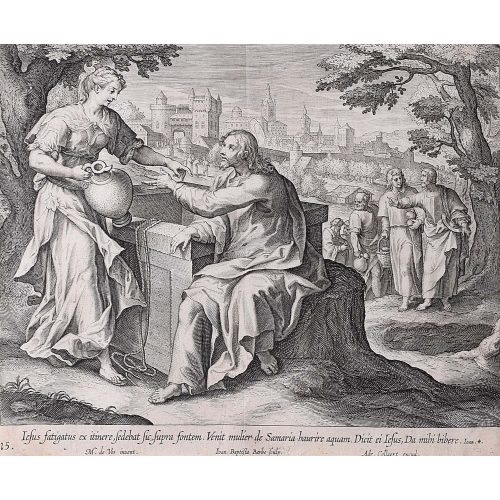
Adriaen Collaert (c. 1560-1618) John de Barbe (1578–1649) after Maerten de Vos (1532 - 1603) 15. Iesus fatigatus ex itinere, sedebat sic supra fontem. Uenit mulier de Samaria haurire aquam. Dicit ei Iesus, Da mihi bibere. John 4.
Engraving From Vita, Passio, et Resurrectio Iesu Christi first published 1598, this a later edition published by Joannes Galle (1600-1676) 17.5x22cm Hand-finished black frame included (UK shipping only) From the Gospel of John, chapter 4 "Jesus, being wearied from his journey, was sitting thus on the well. A Samaritan woman came to draw water. Jesus said to her, “Will you give me a drink?” Adrian Collaert was born in Antwerp between 1555 and 1565, becoming wijnmeester of the Guild of St Luke in 1580 - a title reserved for the sons of guild members. The guild of St Luke was generally the city guild for artists. Working for Philip Galle, a Dutch publisher best known for his old master prints, he married Galle's daughter Justa. After learning the principles of engraving in the Netherlands, he spent some years in Italy improving his skill. Upon returning to Flanders he engraved, in accomplished fashion, a great number of plates. His brother, Jan Collaert II, his son, Jan Baptist Collaert II and a grandson were all printmakers. These particular plates are after paintings by Maerten de Vos, a Flemish painter and draughtsman. His father was Pieter de Vos, from whom he learned. From 1550 - 1558 he travelled in Italy, visiting Rome and Venice and becoming master of the Antwerp Guild of St Luke upon his return in 1558. After 1575 he was mainly engaged in producing print designs. If you are interested email info@manningfineart.co.uk or call us on 07929 749056. Condition: Trimmed to plate margins, generally good condition commensurate with age, slight age toning and handling marks as evident from image. -
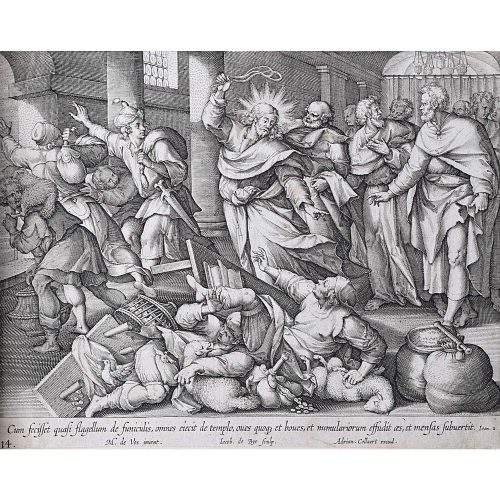
Adriaen Collaert (c. 1560-1618) John de Barbe (1578–1649) after Maerten de Vos (1532 - 1603) 14. Cum fecisset quasi flagellum de funiculis, omnes eiecit de templo, oues quoq et boues, et numulariorum effudit aes, et mensas subuertit. John. 2.
Engraving From Vita, Passio, et Resurrectio Iesu Christi first published 1598, this a later edition published by Joannes Galle (1600-1676) 17.5x22cm Hand-finished black frame included (UK shipping only) From the Gospel of John, chapter 2 "So he made a whip out of cords, and drove all from the temple courts, both sheep and cattle; he scattered the coins of the money changers and overturned their tables”. Adrian Collaert was born in Antwerp between 1555 and 1565, becoming wijnmeester of the Guild of St Luke in 1580 - a title reserved for the sons of guild members. The guild of St Luke was generally the city guild for artists. Working for Philip Galle, a Dutch publisher best known for his old master prints, he married Galle's daughter Justa. After learning the principles of engraving in the Netherlands, he spent some years in Italy improving his skill. Upon returning to Flanders he engraved, in accomplished fashion, a great number of plates. His brother, Jan Collaert II, his son, Jan Baptist Collaert II and a grandson were all printmakers. These particular plates are after paintings by Maerten de Vos, a Flemish painter and draughtsman. His father was Pieter de Vos, from whom he learned. From 1550 - 1558 he travelled in Italy, visiting Rome and Venice and becoming master of the Antwerp Guild of St Luke upon his return in 1558. After 1575 he was mainly engaged in producing print designs. If you are interested email info@manningfineart.co.uk or call us on 07929 749056. Condition: Trimmed to plate margins, generally good condition commensurate with age, slight age toning and handling marks as evident from image. -
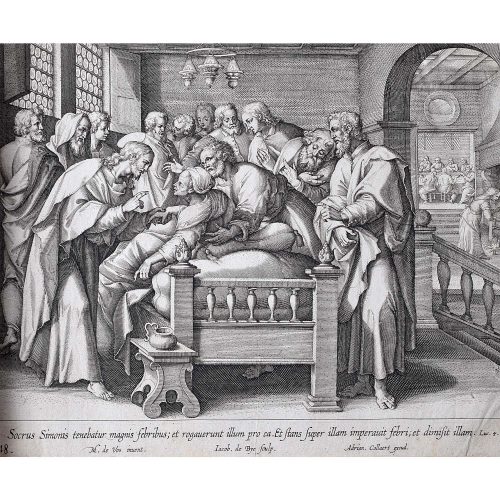
Adriaen Collaert (c. 1560-1618) John de Barbe (1578–1649) after Maerten de Vos (1532 - 1603) 18. Socrus simonis tenebatur magnis febribus; et rogauerunt illum pro ea. Et stans super illum imperauit febri; et dimiset illum. Luke. 4.
Engraving From Vita, Passio, et Resurrectio Iesu Christi first published 1598, this a later edition published by Joannes Galle (1600-1676) 17.5x22cm From the Gospel of Luke, chapter 4 "Simon’s mother-in-law was very sick. She had a high fever. They asked Jesus to do something to help her. He stood very close to her and ordered the sickness to go away". Adrian Collaert was born in Antwerp between 1555 and 1565, becoming wijnmeester of the Guild of St Luke in 1580 - a title reserved for the sons of guild members. The guild of St Luke was generally the city guild for artists. Working for Philip Galle, a Dutch publisher best known for his old master prints, he married Galle's daughter Justa. After learning the principles of engraving in the Netherlands, he spent some years in Italy improving his skill. Upon returning to Flanders he engraved, in accomplished fashion, a great number of plates. His brother, Jan Collaert II, his son, Jan Baptist Collaert II and a grandson were all printmakers. These particular plates are after paintings by Maerten de Vos, a Flemish painter and draughtsman. His father was Pieter de Vos, from whom he learned. From 1550 - 1558 he travelled in Italy, visiting Rome and Venice and becoming master of the Antwerp Guild of St Luke upon his return in 1558. After 1575 he was mainly engaged in producing print designs. If you are interested email info@manningfineart.co.uk or call us on 07929 749056. Condition: Trimmed to plate margins, generally good condition commensurate with age, slight age toning and handling marks as evident from image. -
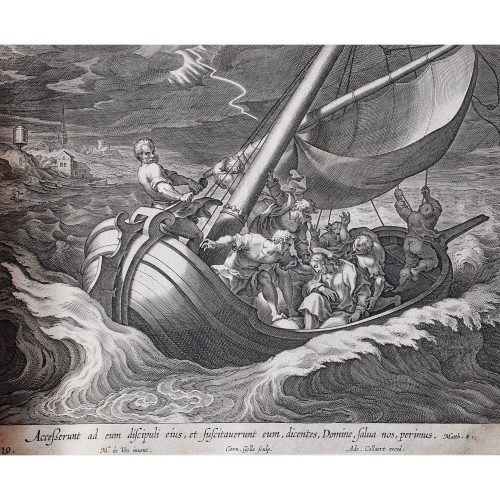
Adriaen Collaert (c. 1560-1618) John de Barbe (1578–1649) after Maerten de Vos (1532 - 1603) 19. Accesserunt ad eum discipuli eius, et suscitaverunt eum, dicentes, Domine, salua nos, perimus. Matth. 8.
Engraving From Vita, Passio, et Resurrectio Iesu Christi first published 1598, this a later edition published by Joannes Galle (1600-1676) 17.5x22cm From the Gospel of Matthew, chapter 8 "Then His disciples came to Him and awoke Him, saying, “Lord, save us! We are perishing!” Adrian Collaert was born in Antwerp between 1555 and 1565, becoming wijnmeester of the Guild of St Luke in 1580 - a title reserved for the sons of guild members. The guild of St Luke was generally the city guild for artists. Working for Philip Galle, a Dutch publisher best known for his old master prints, he married Galle's daughter Justa. After learning the principles of engraving in the Netherlands, he spent some years in Italy improving his skill. Upon returning to Flanders he engraved, in accomplished fashion, a great number of plates. His brother, Jan Collaert II, his son, Jan Baptist Collaert II and a grandson were all printmakers. These particular plates are after paintings by Maerten de Vos, a Flemish painter and draughtsman. His father was Pieter de Vos, from whom he learned. From 1550 - 1558 he travelled in Italy, visiting Rome and Venice and becoming master of the Antwerp Guild of St Luke upon his return in 1558. After 1575 he was mainly engaged in producing print designs. If you are interested email info@manningfineart.co.uk or call us on 07929 749056. Condition: Trimmed to plate margins, generally good condition commensurate with age, slight age toning and handling marks as evident from image. -
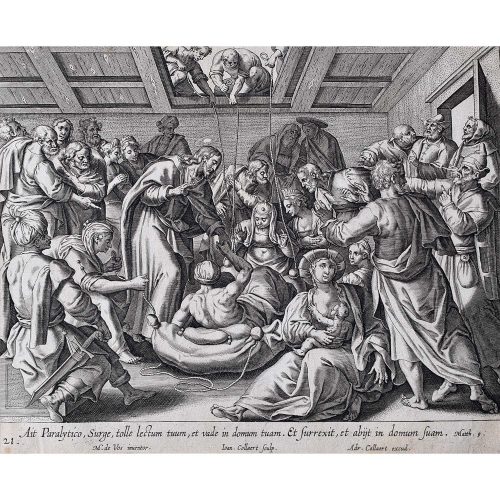
Adriaen Collaert (c. 1560-1618) Jan Collaert (1545–1628) after Maerten de Vos (1532 - 1603) 21. Ait Paralytico, Surge, tolle lectum, et vade in domum tuam. Et surrexit, et abijt in doman suam. Matth. 9.
Engraving From Vita, Passio, et Resurrectio Iesu Christi first published 1598, this a later edition published by Joannes Galle (1600-1676) 17.5x22cm From the Gospel of Matthew, chapter 9 "Get up, pick up your mat, and go home. And the man got up and went home.” Adrian Collaert was born in Antwerp between 1555 and 1565, becoming wijnmeester of the Guild of St Luke in 1580 - a title reserved for the sons of guild members. The guild of St Luke was generally the city guild for artists. Working for Philip Galle, a Dutch publisher best known for his old master prints, he married Galle's daughter Justa. After learning the principles of engraving in the Netherlands, he spent some years in Italy improving his skill. Upon returning to Flanders he engraved, in accomplished fashion, a great number of plates. His brother, Jan Collaert II, his son, Jan Baptist Collaert II and a grandson were all printmakers. These particular plates are after paintings by Maerten de Vos, a Flemish painter and draughtsman. His father was Pieter de Vos, from whom he learned. From 1550 - 1558 he travelled in Italy, visiting Rome and Venice and becoming master of the Antwerp Guild of St Luke upon his return in 1558. After 1575 he was mainly engaged in producing print designs. If you are interested email info@manningfineart.co.uk or call us on 07929 749056. Condition: Trimmed to plate margins, generally good condition commensurate with age, slight age toning and handling marks as evident from image. -
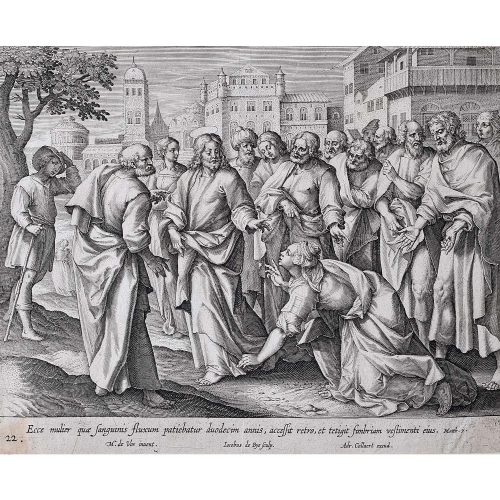
Adriaen Collaert (c. 1560-1618) Jacob de Bye (1581–1640) after Maerten de Vos (1532 - 1603) 22. Ecce mulier quat sanguinis fluxum patiebatur duodecim annis, accessit retro, et tetigit fimbriam vestimenti eius. Matth. 9.
Engraving From Vita, Passio, et Resurrectio Iesu Christi first published 1598, this a later edition published by Joannes Galle (1600-1676) 17.5x22cm From the Gospel of Matthew, chapter 9 "And suddenly, a woman who had a flow of blood for twelve years came from behind and touched the hem of His garment.” Adrian Collaert was born in Antwerp between 1555 and 1565, becoming wijnmeester of the Guild of St Luke in 1580 - a title reserved for the sons of guild members. The guild of St Luke was generally the city guild for artists. Working for Philip Galle, a Dutch publisher best known for his old master prints, he married Galle's daughter Justa. After learning the principles of engraving in the Netherlands, he spent some years in Italy improving his skill. Upon returning to Flanders he engraved, in accomplished fashion, a great number of plates. His brother, Jan Collaert II, his son, Jan Baptist Collaert II and a grandson were all printmakers. These particular plates are after paintings by Maerten de Vos, a Flemish painter and draughtsman. His father was Pieter de Vos, from whom he learned. From 1550 - 1558 he travelled in Italy, visiting Rome and Venice and becoming master of the Antwerp Guild of St Luke upon his return in 1558. After 1575 he was mainly engaged in producing print designs. If you are interested email info@manningfineart.co.uk or call us on 07929 749056. Condition: Trimmed to plate margins, generally good condition commensurate with age, slight age toning and handling marks as evident from image. -
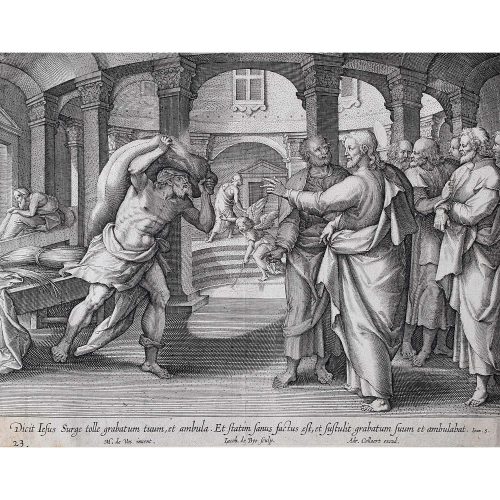
Adriaen Collaert (c. 1560-1618) Jacob de Bye (1581–1640) after Maerten de Vos (1532 - 1603) 23. Dicit iesus Surge tolle grabatum tuum, et ambula. Et statim sanus factus est, et sustulit grabatum suum et ambulabat. John. 5.
Engraving From Vita, Passio, et Resurrectio Iesu Christi first published 1598, this a later edition published by Joannes Galle (1600-1676) 17.5x22cm From the Gospel of John, chapter 5 "He says Rise, take up your bed and walk. He immediately became well, and picked up his bed and walked.” Adrian Collaert was born in Antwerp between 1555 and 1565, becoming wijnmeester of the Guild of St Luke in 1580 - a title reserved for the sons of guild members. The guild of St Luke was generally the city guild for artists. Working for Philip Galle, a Dutch publisher best known for his old master prints, he married Galle's daughter Justa. After learning the principles of engraving in the Netherlands, he spent some years in Italy improving his skill. Upon returning to Flanders he engraved, in accomplished fashion, a great number of plates. His brother, Jan Collaert II, his son, Jan Baptist Collaert II and a grandson were all printmakers. These particular plates are after paintings by Maerten de Vos, a Flemish painter and draughtsman. His father was Pieter de Vos, from whom he learned. From 1550 - 1558 he travelled in Italy, visiting Rome and Venice and becoming master of the Antwerp Guild of St Luke upon his return in 1558. After 1575 he was mainly engaged in producing print designs. If you are interested email info@manningfineart.co.uk or call us on 07929 749056. Condition: Trimmed to plate margins, generally good condition commensurate with age, slight age toning and handling marks as evident from image. -
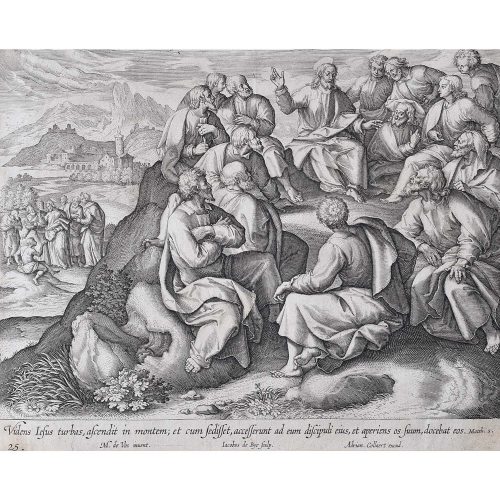
Adriaen Collaert (c. 1560-1618) Jacob de Bye (1581–1640) after Maerten de Vos (1532 - 1603) 25. Videns Iesus turbas, ascendit in montem; et cum sedisset, accesserunt ad eum discipuli eius, et aperiens os suum, docebat eos. Matth. 5.
Engraving From Vita, Passio, et Resurrectio Iesu Christi first published 1598, this a later edition published by Joannes Galle (1600-1676) 17.5x22cm From the Gospel of Matthew, chapter 5 "And seeing the multitudes, He went up on a mountain, and when He was seated His disciples came to Him.” Adrian Collaert was born in Antwerp between 1555 and 1565, becoming wijnmeester of the Guild of St Luke in 1580 - a title reserved for the sons of guild members. The guild of St Luke was generally the city guild for artists. Working for Philip Galle, a Dutch publisher best known for his old master prints, he married Galle's daughter Justa. After learning the principles of engraving in the Netherlands, he spent some years in Italy improving his skill. Upon returning to Flanders he engraved, in accomplished fashion, a great number of plates. His brother, Jan Collaert II, his son, Jan Baptist Collaert II and a grandson were all printmakers. These particular plates are after paintings by Maerten de Vos, a Flemish painter and draughtsman. His father was Pieter de Vos, from whom he learned. From 1550 - 1558 he travelled in Italy, visiting Rome and Venice and becoming master of the Antwerp Guild of St Luke upon his return in 1558. After 1575 he was mainly engaged in producing print designs. If you are interested email info@manningfineart.co.uk or call us on 07929 749056. Condition: Trimmed to plate margins, generally good condition commensurate with age, slight age toning and handling marks as evident from image. -
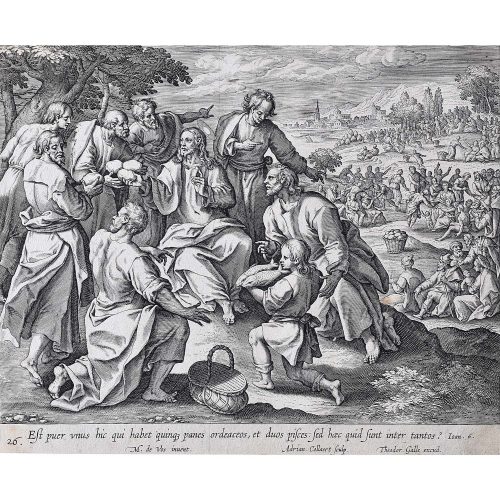
Adriaen Collaert (c. 1560-1618) Theodoor Galle (1571–1633) after Maerten de Vos (1532 - 1603) 26. Est puer vnus hic qui habet quinq panes ordeaceos, et duos: sed haec quid funt tantos? Iohn. 6.
Engraving From Vita, Passio, et Resurrectio Iesu Christi first published 1598, this a later edition published by Joannes Galle (1600-1676) 17.5x22cm From the Gospel of John, chapter 6 "There is a lad here, which hath five barley loaves, one, and two, but what are these for so many?” Adrian Collaert was born in Antwerp between 1555 and 1565, becoming wijnmeester of the Guild of St Luke in 1580 - a title reserved for the sons of guild members. The guild of St Luke was generally the city guild for artists. Working for Philip Galle, a Dutch publisher best known for his old master prints, he married Galle's daughter Justa. After learning the principles of engraving in the Netherlands, he spent some years in Italy improving his skill. Upon returning to Flanders he engraved, in accomplished fashion, a great number of plates. His brother, Jan Collaert II, his son, Jan Baptist Collaert II and a grandson were all printmakers. These particular plates are after paintings by Maerten de Vos, a Flemish painter and draughtsman. His father was Pieter de Vos, from whom he learned. From 1550 - 1558 he travelled in Italy, visiting Rome and Venice and becoming master of the Antwerp Guild of St Luke upon his return in 1558. After 1575 he was mainly engaged in producing print designs. If you are interested email info@manningfineart.co.uk or call us on 07929 749056. Condition: Trimmed to plate margins, generally good condition commensurate with age, slight age toning and handling marks as evident from image. -

Adriaen Collaert (c. 1560-1618) Jacob de Bye (1685-?) after Maerten de Vos (1532 - 1603) 27. Assumit Iesus Petrum et Iacobum et Ioannem fratrem eius, et ducit illos in montem excelsum seorsum; et transfiguratus est eos. Matth. 17.
Engraving From Vita, Passio, et Resurrectio Iesu Christi first published 1598, this a later edition published by Joannes Galle (1600-1676) 17.5x22cm From the Gospel of Matthew, chapter 17 "After six days Jesus took with him Peter, James and John the brother of James, and led them up a high mountain by themselves. There he was transfigured before them.” Adrian Collaert was born in Antwerp between 1555 and 1565, becoming wijnmeester of the Guild of St Luke in 1580 - a title reserved for the sons of guild members. The guild of St Luke was generally the city guild for artists. Working for Philip Galle, a Dutch publisher best known for his old master prints, he married Galle's daughter Justa. After learning the principles of engraving in the Netherlands, he spent some years in Italy improving his skill. Upon returning to Flanders he engraved, in accomplished fashion, a great number of plates. His brother, Jan Collaert II, his son, Jan Baptist Collaert II and a grandson were all printmakers. These particular plates are after paintings by Maerten de Vos, a Flemish painter and draughtsman. His father was Pieter de Vos, from whom he learned. From 1550 - 1558 he travelled in Italy, visiting Rome and Venice and becoming master of the Antwerp Guild of St Luke upon his return in 1558. After 1575 he was mainly engaged in producing print designs. If you are interested email info@manningfineart.co.uk or call us on 07929 749056. Condition: Trimmed to plate margins, generally good condition commensurate with age, slight age toning and handling marks as evident from image. -
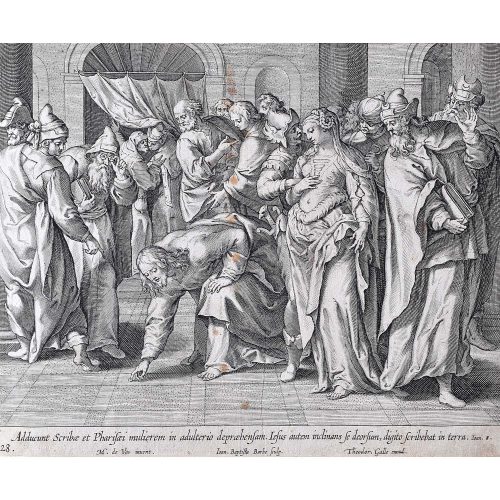
Theodoor Galle (c. 1571-1633) Jean Baptiste Barbe (1578-1649) after Maerten de Vos (1532 - 1603) 28. Adducunt Scibe et Pharisaei mulierem in adulterio deprehensam. Iesus autem inclinans se deorsum, digito scribebat in terra. Iohn. 8.
Engraving From Vita, Passio, et Resurrectio Iesu Christi first published 1598, this a later edition published by Joannes Galle (1600-1676) 17.5x22cm From the Gospel of John, chapter 8 "The scribes and the Pharisees brought a woman who had been caught in adultery, and placing her in the midst they said to him, “Teacher, this woman has been caught in the act of adultery". Jesus bent down and wrote with his finger on the ground.” Adrian Collaert was born in Antwerp between 1555 and 1565, becoming wijnmeester of the Guild of St Luke in 1580 - a title reserved for the sons of guild members. The guild of St Luke was generally the city guild for artists. Working for Philip Galle, a Dutch publisher best known for his old master prints, he married Galle's daughter Justa. After learning the principles of engraving in the Netherlands, he spent some years in Italy improving his skill. Upon returning to Flanders he engraved, in accomplished fashion, a great number of plates. His brother, Jan Collaert II, his son, Jan Baptist Collaert II and a grandson were all printmakers. These particular plates are after paintings by Maerten de Vos, a Flemish painter and draughtsman. His father was Pieter de Vos, from whom he learned. From 1550 - 1558 he travelled in Italy, visiting Rome and Venice and becoming master of the Antwerp Guild of St Luke upon his return in 1558. After 1575 he was mainly engaged in producing print designs. If you are interested email info@manningfineart.co.uk or call us on 07929 749056. Condition: Trimmed to plate margins, generally good condition commensurate with age, slight age toning and handling marks as evident from image. -
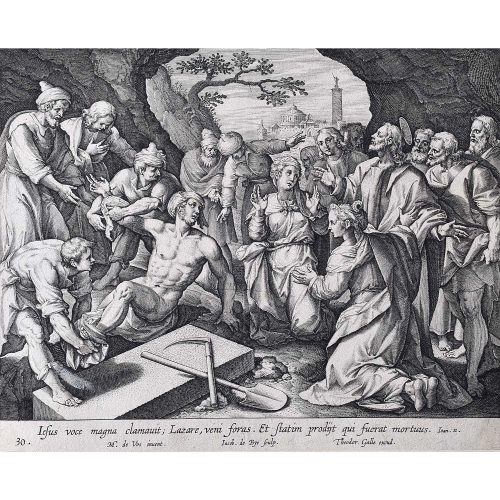
Theodoor Galle (c. 1571-1633) Jacob de Bye (1685-?) after Maerten de Vos (1532 - 1603) 30. Iesus voce magna clamauit; Lazare, veni foras. Et statim proijt qui fuerat mortuus. Iohn. 11.
Engraving From Vita, Passio, et Resurrectio Iesu Christi first published 1598, this a later edition published by Joannes Galle (1600-1676) 17.5x22cm From the Gospel of John, chapter 11 "Jesus called in a loud voice, “Lazarus, come out!” The dead man came out.” Theodoor Galle was the son of Philip Galle, a Dutch publisher best known for his old master prints, from whom he learnt the craft. Theodoor married a daughter of the prominent family of Plantin in Antwerp. His marriage established the productive partnership between the Galle workshop and the Plantin Moretus printing house. A talented workman, Galle quickly became a respected engraver, print publisher and a member of the guild of St Luke, a city guild for artists in 1595. In the years to follow he became the guild's deacon. These particular plates are after paintings by Maerten de Vos, a Flemish painter and draughtsman. His father was Pieter de Vos, from whom he learned. From 1550 - 1558 he travelled in Italy, visiting Rome and Venice and becoming master of the Antwerp Guild of St Luke upon his return in 1558. After 1575 he was mainly engaged in producing print designs. If you are interested email info@manningfineart.co.uk or call us on 07929 749056. Condition: Trimmed to plate margins, generally good condition commensurate with age, slight age toning and handling marks as evident from image. -
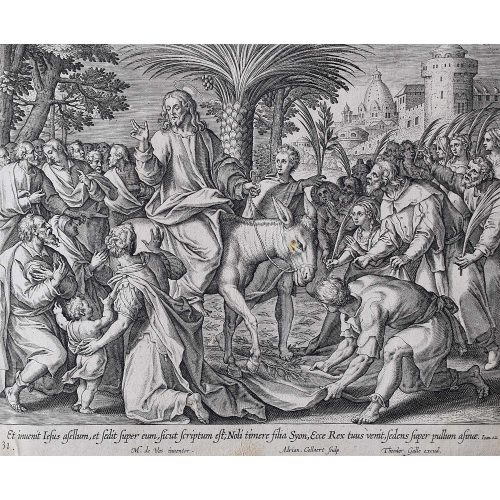
Adrian Collaert (1560–1618) Theodoor Galle (c. 1571-1633) after Maerten de Vos (1532 - 1603) 31. Et inuenit Iesus afellum, et sedit super eum, sicut scriptum est; Noli timere filia Syon, Ecce Rex tuus venit, sedens super pullion asine. Iohn. 12.
Engraving From Vita, Passio, et Resurrectio Iesu Christi first published 1598, this a later edition published by Joannes Galle (1600-1676) 17.5x22cm From the Gospel of John, chapter 12 "Finding a young donkey, Jesus sat on it, as it is written: Fear not, daughter of Zion; Behold, your King is coming, Sitting on a donkey’s colt." Adrian Collaert was born in Antwerp between 1555 and 1565, becoming wijnmeester of the Guild of St Luke in 1580 - a title reserved for the sons of guild members. The guild of St Luke was generally the city guild for artists. Working for Philip Galle, a Dutch publisher best known for his old master prints, he married Galle's daughter Justa. After learning the principles of engraving in the Netherlands, he spent some years in Italy improving his skill. Upon returning to Flanders he engraved, in accomplished fashion, a great number of plates. His brother, Jan Collaert II, his son, Jan Baptist Collaert II and a grandson were all printmakers. These particular plates are after paintings by Maerten de Vos, a Flemish painter and draughtsman. His father was Pieter de Vos, from whom he learned. From 1550 - 1558 he travelled in Italy, visiting Rome and Venice and becoming master of the Antwerp Guild of St Luke upon his return in 1558. After 1575 he was mainly engaged in producing print designs. If you are interested email info@manningfineart.co.uk or call us on 07929 749056. Condition: Trimmed to plate margins, generally good condition commensurate with age, slight age toning and handling marks as evident from image. -
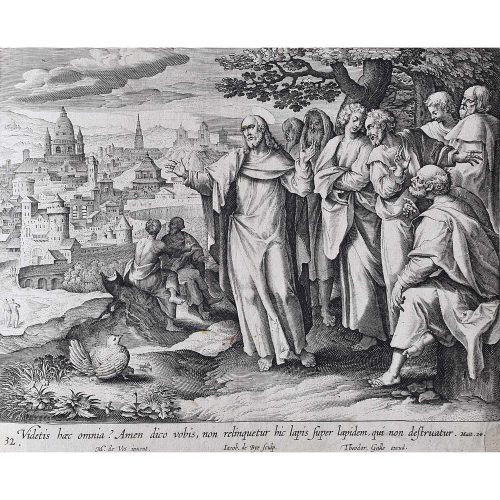
Theodoor Galle (c. 1571-1633) Jacob de Bye (1685-?) after Maerten de Vos (1532 - 1603) 31. Videtis hec omnia? Amen dico vobis, non relinquetur hic lapis super lapidem, qui non destruatur. Matth. 24.
Engraving From Vita, Passio, et Resurrectio Iesu Christi first published 1598, this a later edition published by Joannes Galle (1600-1676) 17.5x22cm From the Gospel of Matthew, chapter 24 "You see all of this? Verily I say unto you, there shall not be left here one stone upon another, that shall not be thrown down.” Theodoor Galle was the son of Philip Galle, a Dutch publisher best known for his old master prints, from whom he learnt the craft. Theodoor married a daughter of the prominent family of Plantin in Antwerp. His marriage established the productive partnership between the Galle workshop and the Plantin Moretus printing house. A talented workman, Galle quickly became a respected engraver, print publisher and a member of the guild of St Luke, a city guild for artists in 1595. In the years to follow he became the guild's deacon. These particular plates are after paintings by Maerten de Vos, a Flemish painter and draughtsman. His father was Pieter de Vos, from whom he learned. From 1550 - 1558 he travelled in Italy, visiting Rome and Venice and becoming master of the Antwerp Guild of St Luke upon his return in 1558. After 1575 he was mainly engaged in producing print designs. If you are interested email info@manningfineart.co.uk or call us on 07929 749056. Condition: Trimmed to plate margins, generally good condition commensurate with age, slight age toning and handling marks as evident from image. -

Theodoor Galle (c. 1571-1633) Jacob de Bye (1685-?) after Maerten de Vos (1532 - 1603) 33. Vidit Iesus quandam vidnam pauperculam mittentem ara minuta duo: Et dixit, Velre dico vobis, quia vidua hec pauper, plusquam omnes misit. Luke. 22.
Engraving From Vita, Passio, et Resurrectio Iesu Christi first published 1598, this a later edition published by Joannes Galle (1600-1676) 17.5x22cm From the Gospel of Luke, Chapter 22 "Vidit Iesus quandam vidnam pauperculam mittentem ara minuta duo: Et dixit, Vere dico vobis, quia vidua hec pauper, plusquam omnes misit. Luke. 22.” Theodoor Galle was the son of Philip Galle, a Dutch publisher best known for his old master prints, from whom he learnt the craft. Theodoor married a daughter of the prominent family of Plantin in Antwerp. His marriage established the productive partnership between the Galle workshop and the Plantin Moretus printing house. A talented workman, Galle quickly became a respected engraver, print publisher and a member of the guild of St Luke, a city guild for artists in 1595. In the years to follow he became the guild's deacon. These particular plates are after paintings by Maerten de Vos, a Flemish painter and draughtsman. His father was Pieter de Vos, from whom he learned. From 1550 - 1558 he travelled in Italy, visiting Rome and Venice and becoming master of the Antwerp Guild of St Luke upon his return in 1558. After 1575 he was mainly engaged in producing print designs. If you are interested email info@manningfineart.co.uk or call us on 07929 749056. Condition: Trimmed to plate margins, generally good condition commensurate with age, slight age toning and handling marks as evident from image. -
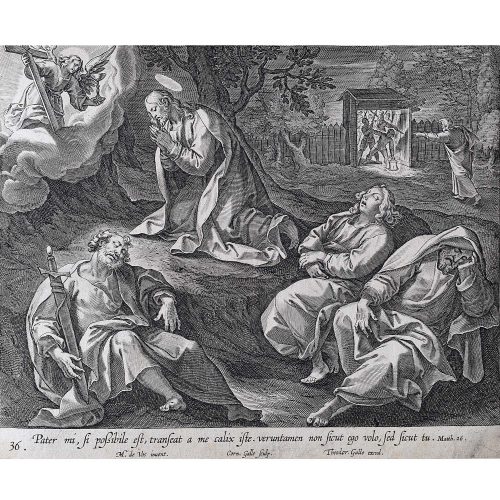
Theodoor Galle (c. 1571-1633) Cornelius Galle (1576-1650) after Maerten de Vos (1532 - 1603) 35. Pater mi, possibile est, transeat a me calix iste. veruntamen non ficut ego volo, sed sicut tu. Matth. 26.
Engraving From Vita, Passio, et Resurrectio Iesu Christi first published 1598, this a later edition published by Joannes Galle (1600-1676) 17.5x22cm From the Gospel of Matthew, Chapter 26 "My Father, if it is possible, may this cup be taken from me. Yet not as I will, but as you will.” Theodoor Galle was the son of Philip Galle, a Dutch publisher best known for his old master prints, from whom he learnt the craft. Theodoor married a daughter of the prominent family of Plantin in Antwerp. His marriage established the productive partnership between the Galle workshop and the Plantin Moretus printing house. A talented workman, Galle quickly became a respected engraver, print publisher and a member of the guild of St Luke, a city guild for artists in 1595. In the years to follow he became the guild's deacon. These particular plates are after paintings by Maerten de Vos, a Flemish painter and draughtsman. His father was Pieter de Vos, from whom he learned. From 1550 - 1558 he travelled in Italy, visiting Rome and Venice and becoming master of the Antwerp Guild of St Luke upon his return in 1558. After 1575 he was mainly engaged in producing print designs. If you are interested email info@manningfineart.co.uk or call us on 07929 749056. Condition: Trimmed to plate margins, generally good condition commensurate with age, slight age toning and handling marks as evident from image. -
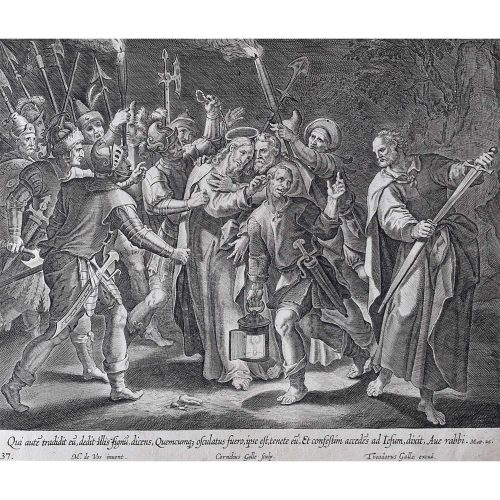
Theodoor Galle (c. 1571-1633) Cornelius Galle (1576-1650) after Maerten de Vos (1532 - 1603) 37. Qui aute tradidit eu, dedit illis fignu, dicens, Quemcumq osculatus fuero, ipse est, tenete eu. Et confestim accedes ad Iesum, dixit, Aue rabbi. Matth. 26.
Engraving From Vita, Passio, et Resurrectio Iesu Christi first published 1598, this a later edition published by Joannes Galle (1600-1676) 17.5x22cm From the Gospel of Matthew, Chapter 26 "The one I kiss, that’s the one—seize him.” He went straight to Jesus, greeted him, “How are you, Rabbi?" and kissed him.” Theodoor Galle was the son of Philip Galle, a Dutch publisher best known for his old master prints, from whom he learnt the craft. Theodoor married a daughter of the prominent family of Plantin in Antwerp. His marriage established the productive partnership between the Galle workshop and the Plantin Moretus printing house. A talented workman, Galle quickly became a respected engraver, print publisher and a member of the guild of St Luke, a city guild for artists in 1595. In the years to follow he became the guild's deacon. These particular plates are after paintings by Maerten de Vos, a Flemish painter and draughtsman. His father was Pieter de Vos, from whom he learned. From 1550 - 1558 he travelled in Italy, visiting Rome and Venice and becoming master of the Antwerp Guild of St Luke upon his return in 1558. After 1575 he was mainly engaged in producing print designs. If you are interested email info@manningfineart.co.uk or call us on 07929 749056. Condition: Trimmed to plate margins, generally good condition commensurate with age, slight age toning and handling marks as evident from image. -
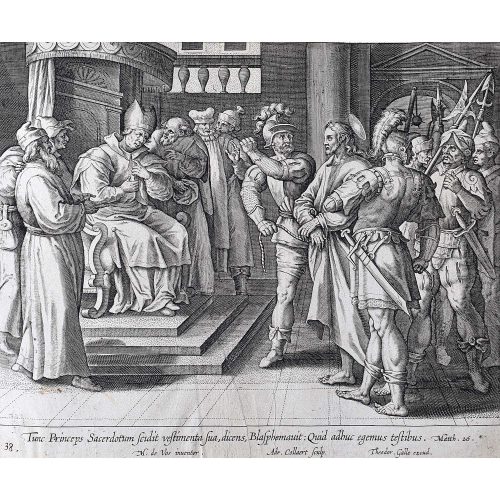
Theodoor Galle (c. 1571-1633) Adrian Collaert (1560-1618) after Maerten de Vos (1532 - 1603) 38. Tunc Princeps Sacerdotum scidit veftimenta sua, dicens, Blasphemauit: Quid adhuc egemus testibus. Matth. 26.
Engraving From Vita, Passio, et Resurrectio Iesu Christi first published 1598, this a later edition published by Joannes Galle (1600-1676) 17.5x22cm From the Gospel of Matthew, Chapter 26 "Then the high priest tore his clothes, saying, “He has spoken blasphemy! What further need do we have of witnesses?” Theodoor Galle was the son of Philip Galle, a Dutch publisher best known for his old master prints, from whom he learnt the craft. Theodoor married a daughter of the prominent family of Plantin in Antwerp. His marriage established the productive partnership between the Galle workshop and the Plantin Moretus printing house. A talented workman, Galle quickly became a respected engraver, print publisher and a member of the guild of St Luke, a city guild for artists in 1595. In the years to follow he became the guild's deacon. These particular plates are after paintings by Maerten de Vos, a Flemish painter and draughtsman. His father was Pieter de Vos, from whom he learned. From 1550 - 1558 he travelled in Italy, visiting Rome and Venice and becoming master of the Antwerp Guild of St Luke upon his return in 1558. After 1575 he was mainly engaged in producing print designs. If you are interested email info@manningfineart.co.uk or call us on 07929 749056. Condition: Trimmed to plate margins, generally good condition commensurate with age, slight age toning and handling marks as evident from image. -
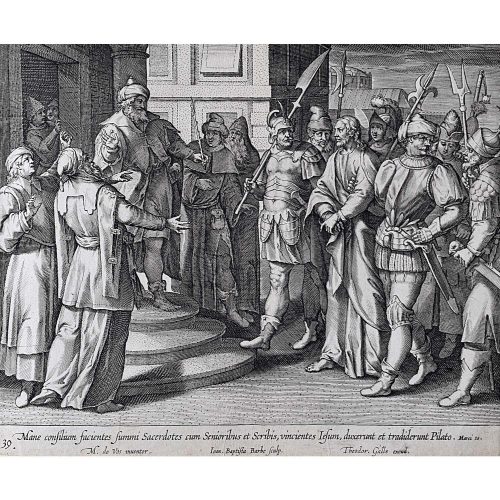
Theodoor Galle (c. 1571-1633) Jan Baptist Barbé (1578-1649) after Maerten de Vos (1532 - 1603) 39. Mane consilium facientes summi sacerdotes cum Senioribus et Scribis, vincientes Iesum, duxerunt et tradiderunt Pilato. Marci. 15.
Engraving From Vita, Passio, et Resurrectio Iesu Christi first published 1598, this a later edition published by Joannes Galle (1600-1676) 17.5x22cm From the Gospel of Mark, Chapter 15 "In the morning, the high priests and elders and teachers, binding Jesus, led him away and delivered him to Pilate." Theodoor Galle was the son of Philip Galle, a Dutch publisher best known for his old master prints, from whom he learnt the craft. Theodoor married a daughter of the prominent family of Plantin in Antwerp. His marriage established the productive partnership between the Galle workshop and the Plantin Moretus printing house. A talented workman, Galle quickly became a respected engraver, print publisher and a member of the guild of St Luke, a city guild for artists in 1595. In the years to follow he became the guild's deacon. These particular plates are after paintings by Maerten de Vos, a Flemish painter and draughtsman. His father was Pieter de Vos, from whom he learned. From 1550 - 1558 he travelled in Italy, visiting Rome and Venice and becoming master of the Antwerp Guild of St Luke upon his return in 1558. After 1575 he was mainly engaged in producing print designs. If you are interested email info@manningfineart.co.uk or call us on 07929 749056. Condition: Trimmed to plate margins, generally good condition commensurate with age, slight age toning and handling marks as evident from image. -

Theodoor Galle (c. 1571-1633) Jan Baptist Barbé (1578-1649) after Maerten de Vos (1532 - 1603) 40. Vt cognouit Pilatus quod de Herodis potestate esset, remisit eum Herodem, qui et ipse Hierosolymis erat illis diebus. Luc 23.
Engraving From Vita, Passio, et Resurrectio Iesu Christi first published 1598, this a later edition published by Joannes Galle (1600-1676) 17.5x22cm From the Gospel of Luke, Chapter 23 "When he discovered that he came under Herod’s jurisdiction, he passed him on to Herod who happened to be in Jerusalem at that time." Theodoor Galle was the son of Philip Galle, a Dutch publisher best known for his old master prints, from whom he learnt the craft. Theodoor married a daughter of the prominent family of Plantin in Antwerp. His marriage established the productive partnership between the Galle workshop and the Plantin Moretus printing house. A talented workman, Galle quickly became a respected engraver, print publisher and a member of the guild of St Luke, a city guild for artists in 1595. In the years to follow he became the guild's deacon. These particular plates are after paintings by Maerten de Vos, a Flemish painter and draughtsman. His father was Pieter de Vos, from whom he learned. From 1550 - 1558 he travelled in Italy, visiting Rome and Venice and becoming master of the Antwerp Guild of St Luke upon his return in 1558. After 1575 he was mainly engaged in producing print designs. If you are interested email info@manningfineart.co.uk or call us on 07929 749056. Condition: Trimmed to plate margins, generally good condition commensurate with age, slight age toning and handling marks as evident from image. -
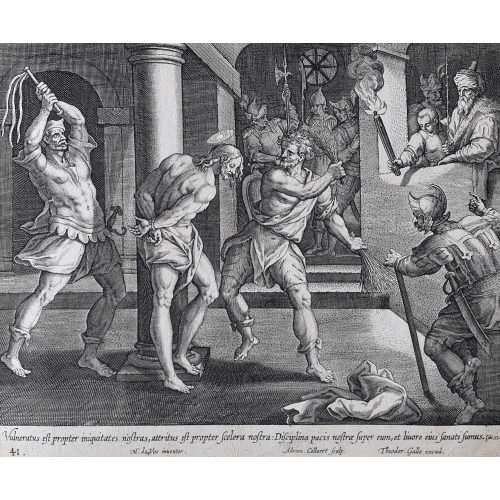
Theodoor Galle (c. 1571-1633) Adrian Collaert (1560-1618) after Maerten de Vos (1532 - 1603) 41. Vulneratus est propter iniquitates nostra, attritus est propter scelera nostra. Disciplina pacis nostrae super eum, et liuore eius sanati sumus. Isai. 53.
Engraving From Vita, Passio, et Resurrectio Iesu Christi first published 1598, this a later edition published by Joannes Galle (1600-1676) 17.5x22cm From the Gospel of Isaiah, Chapter 53 "But He was wounded for our transgressions, He was bruised for our iniquities; The chastisement for our peace was upon Him, And by His stripes we are healed." Theodoor Galle was the son of Philip Galle, a Dutch publisher best known for his old master prints, from whom he learnt the craft. Theodoor married a daughter of the prominent family of Plantin in Antwerp. His marriage established the productive partnership between the Galle workshop and the Plantin Moretus printing house. A talented workman, Galle quickly became a respected engraver, print publisher and a member of the guild of St Luke, a city guild for artists in 1595. In the years to follow he became the guild's deacon. Adrian Collaert was born in Antwerp between 1555 and 1565, becoming wijnmeester of the Guild of St Luke in 1580 - a title reserved for the sons of guild members. The guild of St Luke was generally the city guild for artists. Working for Philip Galle, a Dutch publisher best known for his old master prints, he married Galle's daughter Justa. After learning the principles of engraving in the Netherlands, he spent some years in Italy improving his skill. Upon returning to Flanders he engraved, in accomplished fashion, a great number of plates. His brother, Jan Collaert II, his son, Jan Baptist Collaert II and a grandson were all printmakers. These particular plates are after paintings by Maerten de Vos, a Flemish painter and draughtsman. His father was Pieter de Vos, from whom he learned. From 1550 - 1558 he travelled in Italy, visiting Rome and Venice and becoming master of the Antwerp Guild of St Luke upon his return in 1558. After 1575 he was mainly engaged in producing print designs. If you are interested email info@manningfineart.co.uk or call us on 07929 749056. Condition: Trimmed to plate margins, generally good condition commensurate with age, slight age toning and handling marks as evident from image. -
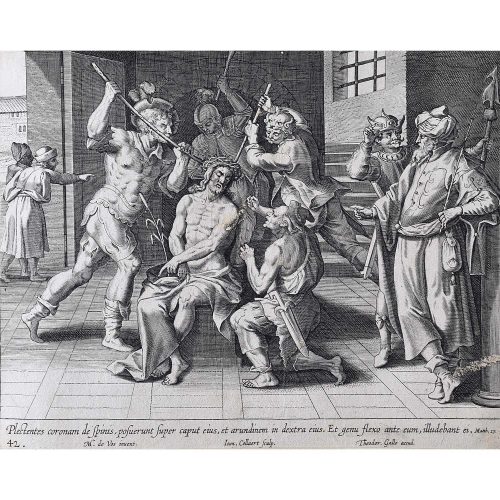
Theodoor Galle (c. 1571-1633) Johannes Collaert (1525-1580) after Maerten de Vos (1532 - 1603) 42. Plectentes coronam de spinis, posuerunt super caput eius, et arundinem in dextra eius. Et genu flexo ante eum, illudebant ei. Matth. 27.
Engraving From Vita, Passio, et Resurrectio Iesu Christi first published 1598, this a later edition published by Joannes Galle (1600-1676) 17.5x22cm From the Gospel of Matthew, Chapter 27 "When they had twisted a crown of thorns, they put it on His head, and a reed in His right hand. And they bowed the knee before Him and mocked Him." Theodoor Galle was the son of Philip Galle, a Dutch publisher best known for his old master prints, from whom he learnt the craft. Theodoor married a daughter of the prominent family of Plantin in Antwerp. His marriage established the productive partnership between the Galle workshop and the Plantin Moretus printing house. A talented workman, Galle quickly became a respected engraver, print publisher and a member of the guild of St Luke, a city guild for artists in 1595. In the years to follow he became the guild's deacon. Adrian Collaert was born in Antwerp between 1555 and 1565, becoming wijnmeester of the Guild of St Luke in 1580 - a title reserved for the sons of guild members. The guild of St Luke was generally the city guild for artists. Working for Philip Galle, a Dutch publisher best known for his old master prints, he married Galle's daughter Justa. After learning the principles of engraving in the Netherlands, he spent some years in Italy improving his skill. Upon returning to Flanders he engraved, in accomplished fashion, a great number of plates. His brother, Jan Collaert II, his son, Jan Baptist Collaert II and a grandson were all printmakers. These particular plates are after paintings by Maerten de Vos, a Flemish painter and draughtsman. His father was Pieter de Vos, from whom he learned. From 1550 - 1558 he travelled in Italy, visiting Rome and Venice and becoming master of the Antwerp Guild of St Luke upon his return in 1558. After 1575 he was mainly engaged in producing print designs. If you are interested email info@manningfineart.co.uk or call us on 07929 749056. Condition: Trimmed to plate margins, generally good condition commensurate with age, slight age toning and handling marks as evident from image. -
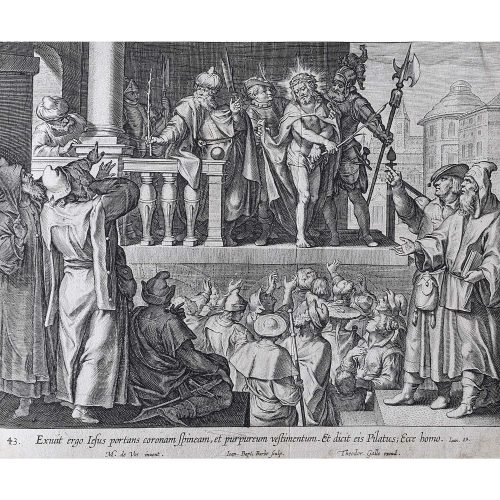
Theodoor Galle (c. 1571-1633) Jan Baptist Barbe (1578-1649) after Maerten de Vos (1532 - 1603) 43. Exiuit ergo Iesus portans coronam spineam, et purpureum vestimentum. Et dicit eis Pilatus; Ecce homo. Ioan. 19.
Engraving From Vita, Passio, et Resurrectio Iesu Christi first published 1598, this a later edition published by Joannes Galle (1600-1676) 17.5x22cm From the Gospel of John, Chapter 19 "Then Jesus came out, wearing the crown of thorns and the purple robe. And Pilate said to them, Behold the Man!" Theodoor Galle was the son of Philip Galle, a Dutch publisher best known for his old master prints, from whom he learnt the craft. Theodoor married a daughter of the prominent family of Plantin in Antwerp. His marriage established the productive partnership between the Galle workshop and the Plantin Moretus printing house. A talented workman, Galle quickly became a respected engraver, print publisher and a member of the guild of St Luke, a city guild for artists in 1595. In the years to follow he became the guild's deacon. These particular plates are after paintings by Maerten de Vos, a Flemish painter and draughtsman. His father was Pieter de Vos, from whom he learned. From 1550 - 1558 he travelled in Italy, visiting Rome and Venice and becoming master of the Antwerp Guild of St Luke upon his return in 1558. After 1575 he was mainly engaged in producing print designs. If you are interested email info@manningfineart.co.uk or call us on 07929 749056. Condition: Trimmed to plate margins, generally good condition commensurate with age, slight age toning and handling marks as evident from image. -
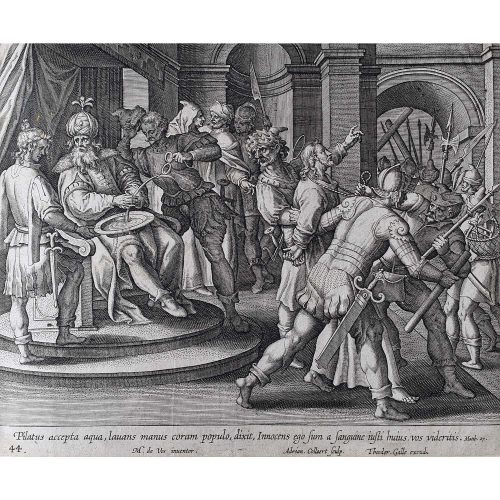
Theodoor Galle (c. 1571-1633) Adrian Collaert (c.1560-1618) after Maerten de Vos (1532 - 1603) 44. Pilatus accepta aqua, lauans manus coram populo, dixit, Innocens ego sum a sanguine insti huius vos videritus. Matth. 27.
Engraving From Vita, Passio, et Resurrectio Iesu Christi first published 1598, this a later edition published by Joannes Galle (1600-1676) 17.5x22cm From the Gospel of Matthew, Chapter 27 "When Pilate saw that he could not prevail at all, but rather that a tumult was rising, he took water and washed his hands before the multitude, saying, “I am innocent of the blood of this just Person. You see to it."" Theodoor Galle was the son of Philip Galle, a Dutch publisher best known for his old master prints, from whom he learnt the craft. Theodoor married a daughter of the prominent family of Plantin in Antwerp. His marriage established the productive partnership between the Galle workshop and the Plantin Moretus printing house. A talented workman, Galle quickly became a respected engraver, print publisher and a member of the guild of St Luke, a city guild for artists in 1595. In the years to follow he became the guild's deacon. Adrian Collaert was born in Antwerp between 1555 and 1565, becoming wijnmeester of the Guild of St Luke in 1580 - a title reserved for the sons of guild members. The guild of St Luke was generally the city guild for artists. Working for Philip Galle, a Dutch publisher best known for his old master prints, he married Galle's daughter Justa. After learning the principles of engraving in the Netherlands, he spent some years in Italy improving his skill. Upon returning to Flanders he engraved, in accomplished fashion, a great number of plates. His brother, Jan Collaert II, his son, Jan Baptist Collaert II and a grandson were all printmakers. These particular plates are after paintings by Maerten de Vos, a Flemish painter and draughtsman. His father was Pieter de Vos, from whom he learned. From 1550 - 1558 he travelled in Italy, visiting Rome and Venice and becoming master of the Antwerp Guild of St Luke upon his return in 1558. After 1575 he was mainly engaged in producing print designs. If you are interested email info@manningfineart.co.uk or call us on 07929 749056. Condition: Trimmed to plate margins, generally good condition commensurate with age, slight age toning and handling marks as evident from image.

